Organic Light Emitting Element And Composition For Organic Material Layer Of Organic Light Emitting Element
PARK; Geon Yu ; et al.
U.S. patent application number 16/471477 was filed with the patent office on 2019-12-26 for organic light emitting element and composition for organic material layer of organic light emitting element. This patent application is currently assigned to HEESUNG MATERIAL LTD.. The applicant listed for this patent is HEESUNG MATERIAL LTD.. Invention is credited to Dae Hyuk CHOI, Jin Seok CHOI, Dongjun KIM, Joo Dong LEE, Geon Yu PARK.
| Application Number | 20190393430 16/471477 |
| Document ID | / |
| Family ID | 62626882 |
| Filed Date | 2019-12-26 |
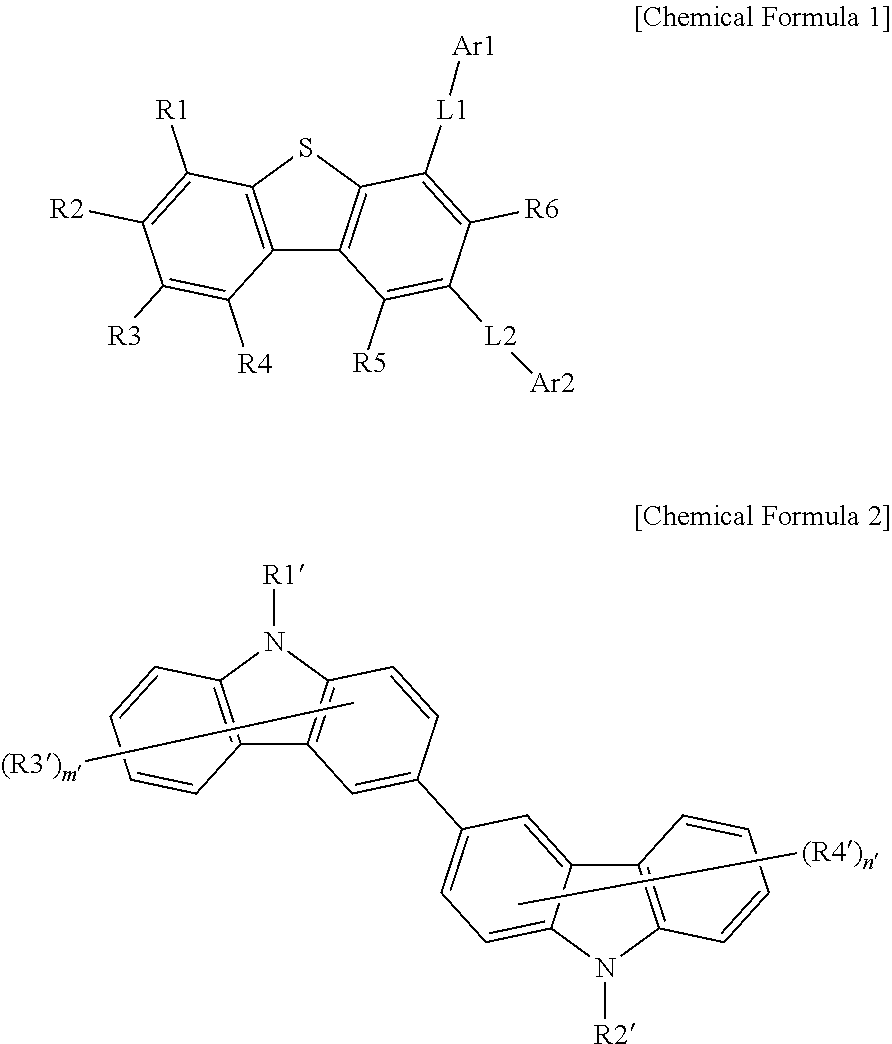



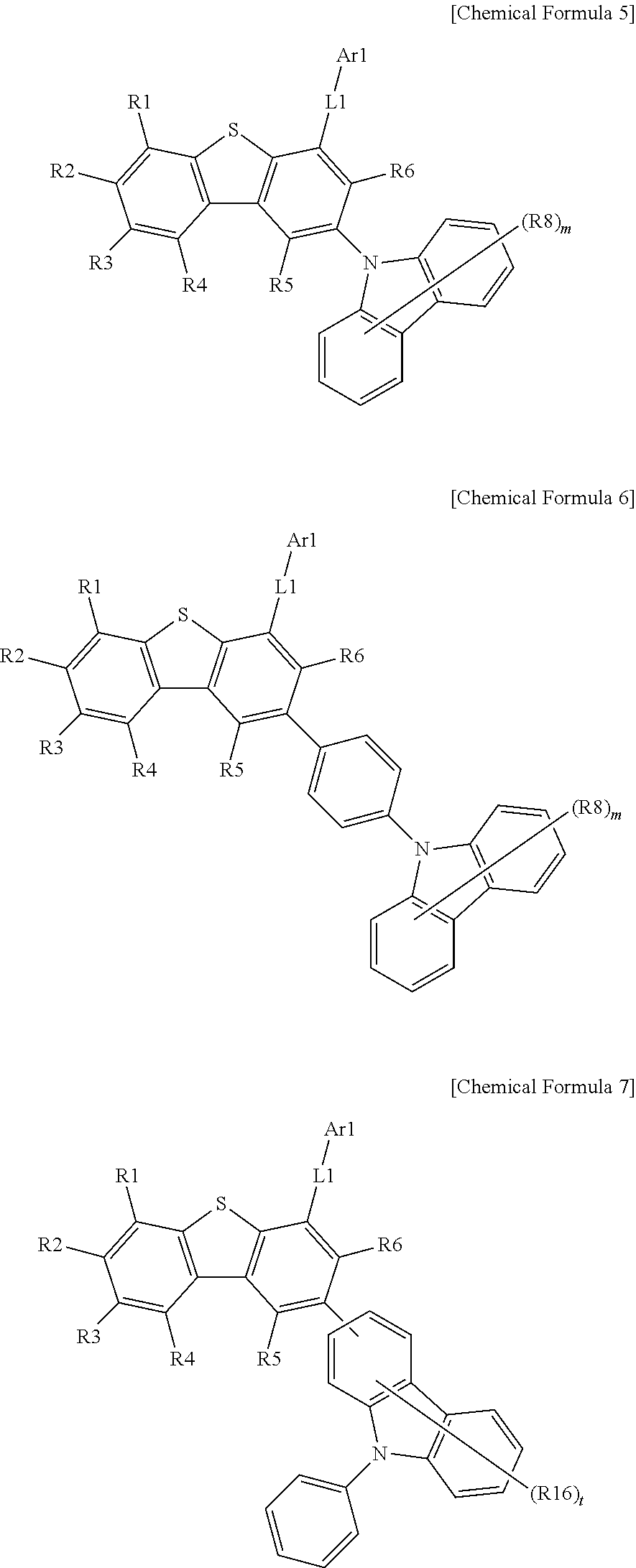

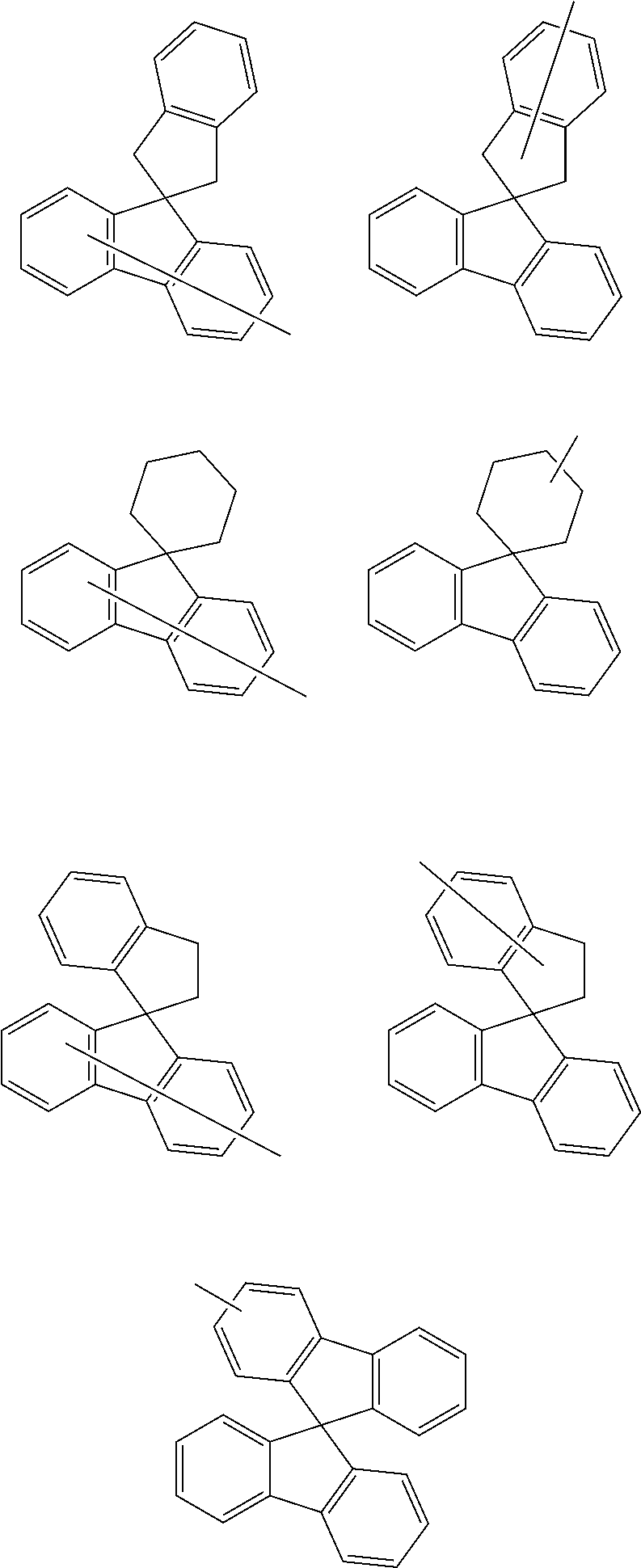
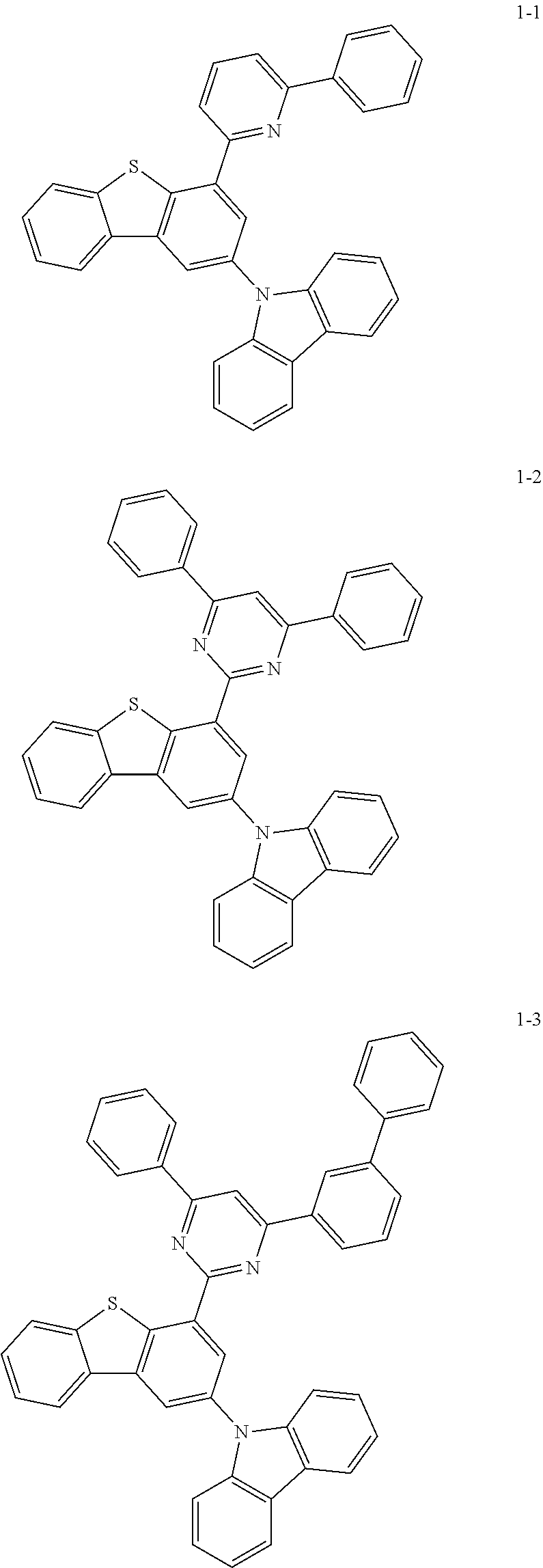
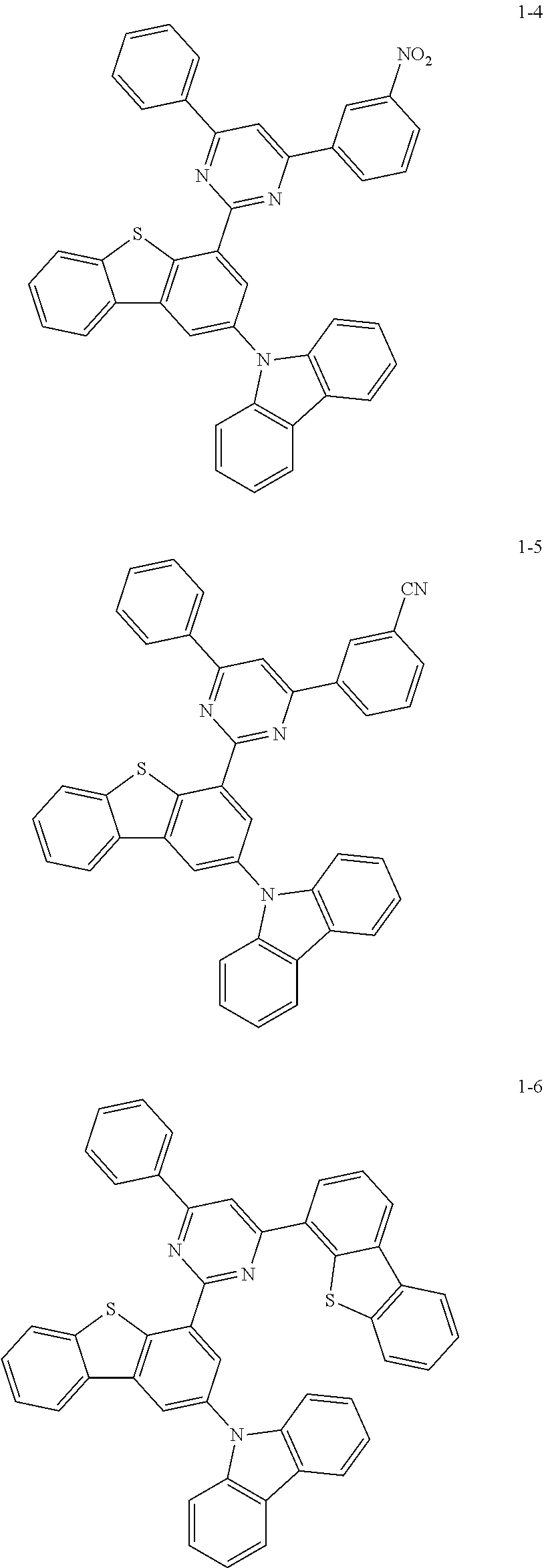
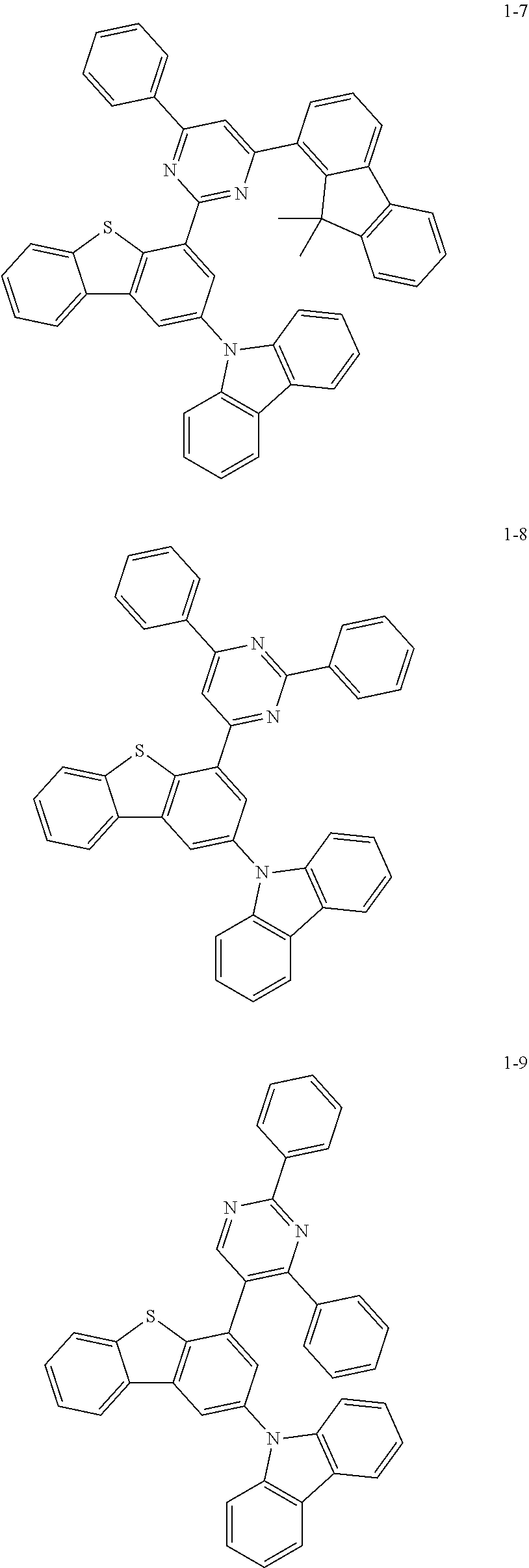


View All Diagrams
| United States Patent Application | 20190393430 |
| Kind Code | A1 |
| PARK; Geon Yu ; et al. | December 26, 2019 |
ORGANIC LIGHT EMITTING ELEMENT AND COMPOSITION FOR ORGANIC MATERIAL LAYER OF ORGANIC LIGHT EMITTING ELEMENT
Abstract
The present application provides a hetero-cyclic compound capable of greatly enhancing lifetime, efficiency, electrochemical stability and thermal stability of an organic light emitting device, and an organic light emitting device containing the hetero-cyclic compound in an organic compound layer.
| Inventors: | PARK; Geon Yu; (Osan-si, KR) ; KIM; Dongjun; (Yongin-si, KR) ; CHOI; Jin Seok; (Suwon-si, KR) ; CHOI; Dae Hyuk; (Yongin-si, KR) ; LEE; Joo Dong; (Seongnam-si, KR) | ||||||||||
| Applicant: |
|
||||||||||
|---|---|---|---|---|---|---|---|---|---|---|---|
| Assignee: | HEESUNG MATERIAL LTD. Yongin-City, Gyeonggi-do KR |
||||||||||
| Family ID: | 62626882 | ||||||||||
| Appl. No.: | 16/471477 | ||||||||||
| Filed: | December 20, 2017 | ||||||||||
| PCT Filed: | December 20, 2017 | ||||||||||
| PCT NO: | PCT/KR2017/015073 | ||||||||||
| 371 Date: | June 19, 2019 |
| Current U.S. Class: | 1/1 |
| Current CPC Class: | H01L 51/5092 20130101; H01L 51/5016 20130101; H01L 51/5056 20130101; H01L 51/5088 20130101; H01L 51/50 20130101; C07D 409/14 20130101; H01L 51/5096 20130101; H01L 51/0067 20130101; H01L 51/0085 20130101; H01L 51/5012 20130101; H01L 2251/5384 20130101; H01L 51/5072 20130101; C09K 11/06 20130101; H01L 51/0074 20130101; H01L 51/0072 20130101; C07D 209/86 20130101; C09K 2211/1018 20130101; H01L 51/00 20130101 |
| International Class: | H01L 51/00 20060101 H01L051/00; C07D 409/14 20060101 C07D409/14; C09K 11/06 20060101 C09K011/06; C07D 209/86 20060101 C07D209/86 |
Foreign Application Data
| Date | Code | Application Number |
|---|---|---|
| Dec 20, 2016 | KR | 10-2016-0174449 |
Claims
1. An organic light emitting device comprising: an anode; a cathode; and one or more organic material layers provided between the anode and the cathode, wherein one or more layers of the organic material layers comprise a hetero-cyclic compound represented by the following to Chemical Formula 1 and a compound represented by the following Chemical Formula 2 at the same time: ##STR00144## in Chemical Formulae 1 and 2, L1 and L2 are the same as or different from each other, and each independently a direct bond, or a substituted or unsubstituted C.sub.6 to C.sub.60 arylene group; Ar1 is a substituted or unsubstituted C.sub.2 to C.sub.60 heteroaryl group comprising at least one N; Ar2 is represented by any one of the following Chemical Formulae 3 and 4; ##STR00145## Y1 to Y4 are the same as or different from each other, and each independently a substituted or unsubstituted C.sub.6 to C.sub.60 aromatic hydrocarbon ring; or a substituted or unsubstituted C.sub.2 to C.sub.60 aromatic heteroring; R1 to R7, R3' and R4' are the same as or different from each other, and each independently selected from the group consisting of hydrogen; deuterium; a halogen group; --CN; a substituted or unsubstituted C.sub.1 to C.sub.60 alkyl group; a substituted or unsubstituted C.sub.2 to C.sub.60 alkenyl group; a substituted or unsubstituted C.sub.2 to C.sub.60 alkynyl group; a substituted or unsubstituted C.sub.1 to C.sub.60 alkoxy group; a substituted or unsubstituted C.sub.3 to C.sub.60 cycloalkyl group; a substituted or unsubstituted C.sub.2 to C.sub.60 heterocycloalkyl group; a substituted or unsubstituted C.sub.6 to C.sub.60 aryl group; a substituted or unsubstituted C.sub.2 to C.sub.60 heteroaryl group; --SiRR'R''; --P(.dbd.O)RR'; and an amine group unsubstituted or substituted with a C.sub.1 to C.sub.20 alkyl group, a substituted or unsubstituted C.sub.6 to C.sub.60 aryl group, or a C.sub.2 to C.sub.60 heteroaryl group, or two or more groups adjacent to each other bond to each other to form a substituted or unsubstituted aliphatic or aromatic hydrocarbon ring; R1' is represented by -(L1')p'-(Ar1')q', and R2' is represented by -(L2')r'-(Ar2')s'; L1' and L2' are each independently a direct bond, or a substituted or unsubstituted C.sub.6 to C.sub.60 arylene group; Ar1' and Ar2' are each independently --CN; a substituted or unsubstituted C.sub.1 to C.sub.60 alkyl group; --SiRR'R''; a substituted or unsubstituted C.sub.6 to C.sub.60 aryl group; or a substituted or unsubstituted C.sub.2 to C.sub.60 heteroaryl group; R, R' and R'' are the same as or different from each other, and each independently hydrogen; deuterium; --CN; a substituted or unsubstituted C.sub.1 to C.sub.60 alkyl group; a substituted or unsubstituted C.sub.3 to C.sub.60 cycloalkyl group; a substituted or unsubstituted C.sub.6 to C.sub.60 aryl group; or a substituted or unsubstituted C.sub.2 to C.sub.60 heteroaryl group; p' and r' are each independently an integer of 0 to 4; q' and s' are each independently an integer of 1 to 4; and m' and n' are each independently an integer of 0 to 7.
2. The organic light emitting device of claim 1, wherein Chemical Formula 3 is represented by any one of the following structural formulae: ##STR00146## in the structural formulae, X1 to X6 are the same as or different from each other, and each independently NR, S, O or CR'R''; R8 to R14 are the same as or different from each other, and each independently selected from the group consisting of hydrogen; deuterium; a halogen group; --CN; a substituted or unsubstituted C.sub.1 to C.sub.60 alkyl group; a substituted or unsubstituted C.sub.2 to C.sub.60 alkenyl group; a substituted or unsubstituted C.sub.2 to C.sub.60 alkynyl group; a substituted or unsubstituted C.sub.1 to C.sub.60 alkoxy group; a substituted or unsubstituted C.sub.3 to C.sub.60 cycloalkyl group; a substituted or unsubstituted C.sub.2 to C.sub.60 heterocycloalkyl group; a substituted or unsubstituted C.sub.6 to C.sub.60 aryl group; a substituted or unsubstituted C.sub.2 to C.sub.60 heteroaryl group; --SiRR'R''; --P(.dbd.O)RR'; and an amine group unsubstituted or substituted with a C.sub.1 to C.sub.20 alkyl group, a substituted or unsubstituted C.sub.6 to C.sub.60 aryl group, or a C.sub.2 to C.sub.60 heteroaryl group, or two or more groups adjacent to each other bond to each other to form a substituted or unsubstituted aliphatic or aromatic hydrocarbon ring; R, R' and R'' are the same as or different from each other, and each independently hydrogen; deuterium; --CN; a substituted or unsubstituted C.sub.1 to C.sub.60 alkyl group; a substituted or unsubstituted C.sub.3 to C.sub.60 cycloalkyl group; a substituted or unsubstituted C.sub.6 to C.sub.60 aryl group; or a substituted or unsubstituted C.sub.2 to C.sub.60 heteroaryl group; and m is an integer of 0 to 8, and n, o, p, q, r and s are each independently an integer of 0 to 6.
3. The organic light emitting device of claim 1, wherein Chemical Formula 4 is represented by any one of the following structural formulae: ##STR00147## in the structural formulae, X7 and X8 are the same as or different from each other, and each independently NR, S, O or CR' R''; R15 to R18 are the same as or different from each other, and each independently selected from the group consisting of hydrogen; deuterium; a halogen group; --CN; a substituted or unsubstituted C.sub.1 to C.sub.60 alkyl group; a substituted or unsubstituted C.sub.2 to C.sub.60 alkenyl group; a substituted or unsubstituted C.sub.2 to C.sub.60 alkynyl group; a substituted or unsubstituted C.sub.1 to C.sub.60 alkoxy group; a substituted or unsubstituted C.sub.3 to C.sub.60 cycloalkyl group; a substituted or unsubstituted C.sub.2 to C.sub.60 heterocycloalkyl group; a substituted or unsubstituted C.sub.6 to C.sub.60 aryl group; a substituted or unsubstituted C.sub.2 to C.sub.60 heteroaryl group; --SiRR'R''; --P(.dbd.O)RR'; and an amine group unsubstituted or substituted with a C.sub.1 to C.sub.20 alkyl group, a substituted or unsubstituted C.sub.6 to C.sub.60 aryl group, or a C.sub.2 to C.sub.60 heteroaryl group, or two or more groups adjacent to each other bond to each other to form a substituted or unsubstituted aliphatic or aromatic hydrocarbon ring; R, R' and R'' are the same as or different from each other, and each independently hydrogen; deuterium; --CN; a substituted or unsubstituted C.sub.1 to C.sub.60 alkyl group; a substituted or unsubstituted C.sub.3 to C.sub.60 cycloalkyl group; a substituted or unsubstituted C.sub.6 to C.sub.60 aryl group; or a substituted or unsubstituted C.sub.2 to C.sub.60 heteroaryl group; and t is an integer of 0 to 7.
4. The organic light emitting device of claim 1, wherein Chemical Formula 1 is represented by any one of the following Chemical Formulae 5 to 10: ##STR00148## ##STR00149## in Chemical Formulae 5 to 10, R1 to R6, L1 and Ar1 have the same definitions as in Chemical Formula 1; X1, X4 and X5 are the same as or different from each other, and each independently NR, S, O or CR'R''; R8, R9, R12, R13 and R16 are the same as or different from each other, and each independently selected from the group consisting of hydrogen; deuterium; a halogen group; --CN; a substituted or unsubstituted C.sub.1 to C.sub.60 alkyl group; a substituted or unsubstituted C.sub.2 to C.sub.60 alkenyl group; a substituted or unsubstituted C.sub.2 to C.sub.60 alkynyl group; a substituted or unsubstituted C.sub.1 to C.sub.60 alkoxy group; a substituted or unsubstituted C.sub.3 to C.sub.60 cycloalkyl group; a substituted or unsubstituted C.sub.2 to C.sub.60 heterocycloalkyl group; a substituted or unsubstituted C.sub.6 to C.sub.60 aryl group; a substituted or unsubstituted C.sub.2 to C.sub.60 heteroaryl group; --SiRR'R''; --P(.dbd.O)RR'; and an amine group unsubstituted or substituted with a C.sub.1 to C.sub.20 alkyl group, a substituted or unsubstituted C.sub.6 to C.sub.60 aryl group, or a C.sub.2 to C.sub.60 heteroaryl group, or two or more groups adjacent to each other bond to each other to form a substituted or unsubstituted aliphatic or aromatic hydrocarbon ring; R, R' and R'' are the same as or different from each other, and each independently hydrogen; deuterium; --CN; a substituted or unsubstituted C.sub.1 to C.sub.60 alkyl group; a substituted or unsubstituted C.sub.3 to C.sub.60 cycloalkyl group; a substituted or unsubstituted C.sub.6 to C.sub.60 aryl group; or a substituted or unsubstituted C.sub.2 to C.sub.60 heteroaryl group; and m is an integer of 0 to 8, n, q and r are each independently an integer of 0 to 6, and t is an integer of 0 to 7.
5. The organic light emitting device of claim 1, wherein Chemical Formula 1 is represented by any one of the following compounds: ##STR00150## ##STR00151## ##STR00152## ##STR00153## ##STR00154## ##STR00155## ##STR00156## ##STR00157## ##STR00158## ##STR00159## ##STR00160## ##STR00161## ##STR00162## ##STR00163## ##STR00164## ##STR00165## ##STR00166## ##STR00167## ##STR00168## ##STR00169## ##STR00170## ##STR00171## ##STR00172## ##STR00173## ##STR00174## ##STR00175## ##STR00176## ##STR00177## ##STR00178## ##STR00179## ##STR00180## ##STR00181## ##STR00182## ##STR00183## ##STR00184## ##STR00185## ##STR00186## ##STR00187## ##STR00188## ##STR00189## ##STR00190## ##STR00191## ##STR00192## ##STR00193## ##STR00194## ##STR00195## ##STR00196## ##STR00197## ##STR00198## ##STR00199## ##STR00200## ##STR00201## ##STR00202## ##STR00203## ##STR00204## ##STR00205## ##STR00206## ##STR00207## ##STR00208## ##STR00209## ##STR00210## ##STR00211## ##STR00212## ##STR00213## ##STR00214## ##STR00215## ##STR00216## ##STR00217## ##STR00218## ##STR00219##
6. The organic light emitting device of claim 1, wherein Chemical Formula 2 is represented by any one of the following compounds: ##STR00220## ##STR00221## ##STR00222## ##STR00223## ##STR00224## ##STR00225## ##STR00226## ##STR00227## ##STR00228## ##STR00229## ##STR00230## ##STR00231## ##STR00232## ##STR00233## ##STR00234## ##STR00235## ##STR00236## ##STR00237## ##STR00238## ##STR00239## ##STR00240## ##STR00241## ##STR00242## ##STR00243## ##STR00244## ##STR00245## ##STR00246## ##STR00247## ##STR00248## ##STR00249## ##STR00250## ##STR00251## ##STR00252## ##STR00253## ##STR00254##
7. The organic light emitting device of claim 1, wherein the organic material layer comprises at least one of a hole blocking layer, an electron injection layer and an electron transfer layer, and at least one of the hole blocking layer, the electron injection layer and the electron transfer layer comprises the hetero-cyclic compound.
8. The organic light emitting device of claim 1, wherein the organic material layer comprises a light emitting layer, and the light emitting layer comprises the hetero-cyclic compound.
9. The organic light emitting device of claim 1, wherein the organic material layer comprises one or more of a hole injection layer, a hole transfer layer, and a layer carrying out hole injection and hole transfer at the same time, and one of the layers comprises the hetero-cyclic compound.
10. A composition for an organic material layer of an organic light emitting device, the composition comprising: a hetero-cyclic compound represented by the following Chemical Formula 1; and a compound represented by the following Chemical Formula 2 at the same time: ##STR00255## wherein, in Chemical Formulae 1 and 2, L1 and L2 are the same as or different from each other, and each independently a direct bond, or a substituted or unsubstituted C.sub.6 to C.sub.60 arylene group; Ar1 is a substituted or unsubstituted C.sub.2 to C.sub.60 heteroaryl group comprising at least one N; Ar2 is represented by any one of the following Chemical Formulae 3 and 4; ##STR00256## Y1 to Y4 are the same as or different from each other, and each independently a substituted or unsubstituted C.sub.6 to C.sub.60 aromatic hydrocarbon ring; or a substituted or unsubstituted C.sub.2 to C.sub.60 aromatic heteroring; R1 to R7, R3' and R4' are the same as or different from each other, and each independently selected from the group consisting of hydrogen; deuterium; a halogen group; --CN; a substituted or unsubstituted C.sub.1 to C.sub.60 alkyl group; a substituted or unsubstituted C.sub.2 to C.sub.60 alkenyl group; a substituted or unsubstituted C.sub.2 to C.sub.60 alkynyl group; a substituted or unsubstituted C.sub.1 to C.sub.60 alkoxy group; a substituted or unsubstituted C.sub.3 to C.sub.60 cycloalkyl group; a substituted or unsubstituted C.sub.2 to C.sub.60 heterocycloalkyl group; a substituted or unsubstituted C.sub.6 to C.sub.60 aryl group; a substituted or unsubstituted C.sub.2 to C.sub.60 heteroaryl group; --SiRR'R''; --P(.dbd.O)RR'; and an amine group unsubstituted or substituted with a C.sub.1 to C.sub.20 alkyl group, a substituted or unsubstituted C.sub.6 to C.sub.60 aryl group, or a C.sub.2 to C.sub.60 heteroaryl group, or two or more groups adjacent to each other bond to each other to form a substituted or unsubstituted aliphatic or aromatic hydrocarbon ring; R1' is represented by -(L1')p'-(Ar1')q', and R2' is represented by -(L2')r'-(Ar2')s'; L1' and L2' are each independently a direct bond, or a substituted or unsubstituted CF to C.sub.60 arylene group; Ar1' and Ar2' are each independently --CN; a substituted or unsubstituted C.sub.1 to C.sub.60 alkyl group; --SiRR'R''; a substituted or unsubstituted C.sub.6 to C.sub.60 aryl group; or a substituted or unsubstituted C.sub.2 to C.sub.60 heteroaryl group; R, R' and R'' are the same as or different from each other, and each independently hydrogen; deuterium; --CN; a substituted or unsubstituted C.sub.1 to C.sub.60 alkyl group; a substituted or unsubstituted C.sub.3 to C.sub.60 cycloalkyl group; a substituted or unsubstituted C.sub.6 to C.sub.60 aryl group; or a substituted or unsubstituted C.sub.2 to C.sub.60 heteroaryl group; p' and r' are each independently an integer of 0 to 4; q' and s' are each independently an integer of 1 to 4; and m' and n' are each independently an integer of 0 to 7.
11. The composition for an organic material layer of an organic light emitting device of claim 10, wherein a weight ratio of the hetero-cyclic compound represented by Chemical Formula 1: the compound represented by Chemical Formula 2 in the composition is from 1:10 to 10:1.
12. The composition for an organic material layer of an organic light emitting device of claim 10, wherein Chemical Formula 1 is represented by any one of the following Chemical Formulae 5 to 10: ##STR00257## ##STR00258## in Chemical Formulae 5 to 10, R1 to R6, L1 and Ar1 have the same definitions as in Chemical Formula 1; X1, X4 and X5 are the same as or different from each other, and each independently NR, S, O or CR'R''; R8, R9, R12, R13 and R16 are the same as or different from each other, and each independently selected from the group consisting of hydrogen; deuterium; a halogen group; --CN; a substituted or unsubstituted C.sub.1 to C.sub.60 alkyl group; a substituted or unsubstituted C.sub.2 to C.sub.60 alkenyl group; a substituted or unsubstituted C.sub.2 to C.sub.60 alkynyl group; a substituted or unsubstituted C.sub.1 to C.sub.60 alkoxy group; a substituted or unsubstituted C.sub.3 to C.sub.60 cycloalkyl group; a substituted or unsubstituted C.sub.2 to C.sub.60 heterocycloalkyl group; a substituted or unsubstituted C.sub.6 to C.sub.60 aryl group; a substituted or unsubstituted C.sub.2 to C.sub.60 heteroaryl group; --SiRR'R''; --P(.dbd.O)RR'; and an amine group unsubstituted or substituted with a C.sub.1 to C.sub.20 alkyl group, a substituted or unsubstituted C.sub.6 to C.sub.60 aryl group, or a C.sub.2 to C.sub.60 heteroaryl group, or two or more groups adjacent to each other bond to each other to form a substituted or unsubstituted aliphatic or aromatic hydrocarbon ring; R, R' and R'' are the same as or different from each other, and each independently hydrogen; deuterium; --CN; a substituted or unsubstituted C.sub.1 to C.sub.60 alkyl group; a substituted or unsubstituted C.sub.3 to C.sub.60 cycloalkyl group; a substituted or unsubstituted C.sub.6 to C.sub.60 aryl group; or a substituted or unsubstituted C.sub.2 to C.sub.60 heteroaryl group; and m is an integer of 0 to 8, n, q and r are each independently an integer of 0 to 6, and t is an integer of 0 to 7.
Description
TECHNICAL FIELD
[0001] This application claims priority to and the benefits of Korean Patent Application No. 10-2016-0174449, filed with the Korean Intellectual Property Office on Dec. 20, 2016, the entire contents of which are incorporated herein by reference.
[0002] The present application relates to an organic light emitting device, and a composition for an organic material layer of an organic light emitting device.
BACKGROUND ART
[0003] An electroluminescent device is one type of self-emissive display devices, and has an advantage of having a wide viewing angle, and a high response speed as well as having an excellent contrast.
[0004] An organic light emitting device has a structure disposing an organic thin film between two electrodes. When a voltage is applied to an organic light emitting device having such a structure, electrons and holes injected from the two electrodes bind and pair in the organic thin film, and light emits as these annihilate. The organic thin film may be formed in a single layer or a multilayer as necessary.
[0005] A material of the organic thin film may have a light emitting function as necessary. For example, as a material of the organic thin film, compounds capable of forming a light emitting layer themselves alone may be used, or compounds capable of performing a role of a host or a dopant of a host-dopant-based light emitting layer may also be used. In addition thereto, compounds capable of performing roles of hole injection, hole transfer, electron blocking, hole blocking, electron transfer, electron injection and the like may also be used as a material of the organic thin film.
[0006] Development of an organic thin film material has been continuously required for enhancing performance, lifetime or efficiency of an organic light emitting device.
DISCLOSURE
Technical Problem
[0007] Researches for an organic light emitting device comprising a compound capable of satisfying conditions required for materials usable in an organic light emitting device, for example, a proper energy level, electrochemical stability, thermal stability and the like, and having a chemical structure that may perform various roles required in an organic light emitting device depending on substituents have been required.
Technical Solution
[0008] One embodiment of the present application provides an organic light emitting device comprising an anode, a cathode and one or more organic material layers provided between the anode and the cathode,
[0009] wherein one or more layers of the organic material layers comprise a hetero-cyclic compound represented by the following Chemical Formula 1 and a hetero-cyclic compound represented by the following Chemical Formula 2 at the same time.
##STR00001##
[0010] In Chemical Formulae 1 and 2,
[0011] L1 and L2 are the same as or different from each other, and each independently a direct bond, or a substituted or unsubstituted C.sub.6 to C.sub.60 arylene group,
[0012] Ar1 is a substituted or unsubstituted C.sub.2 to C.sub.60 heteroaryl group comprising at least one N,
[0013] Ar2 is represented by any one of the following Chemical Formulae 3 and 4,
##STR00002##
[0014] Y1 to Y4 are the same as or different from each other, and each independently a substituted or unsubstituted C.sub.6 to C.sub.60 aromatic hydrocarbon ring; or a substituted or unsubstituted C.sub.2 to C.sub.60 aromatic heteroring,
[0015] R1 to R7, R3' and R4' are the same as or different from each other, and each independently selected from the group consisting of hydrogen; deuterium; a halogen group; --CN; a substituted or unsubstituted C.sub.1 to C.sub.60 alkyl group; a substituted or unsubstituted C.sub.2 to C.sub.60 alkenyl group; a substituted or unsubstituted C.sub.2 to C.sub.60 alkynyl group; a substituted or unsubstituted C.sub.1 to C.sub.60 alkoxy group; a substituted or unsubstituted C.sub.3 to C.sub.60 cycloalkyl group; a substituted or unsubstituted C.sub.2 to C.sub.60 heterocycloalkyl group; a substituted or unsubstituted C.sub.6 to C.sub.60 aryl group; a substituted or unsubstituted C.sub.2 to C.sub.60 heteroaryl group; --SiRR'R''; --P(.dbd.O)RR'; and an amine group unsubstituted or substituted with a C.sub.1 to C.sub.20 alkyl group, a substituted or unsubstituted C.sub.6 to C.sub.60 aryl group, or a C.sub.2 to C.sub.60 heteroaryl group, or two or more groups adjacent to each other bond to each other to form a substituted or unsubstituted aliphatic or aromatic hydrocarbon ring,
[0016] R1' is represented by -(L1')p'-(Ar1')q', and R2' is represented by -(L2')r'-(Ar2')s',
[0017] L1' and L2' are each independently a direct bond, or a substituted or unsubstituted C.sub.6 to C.sub.60 arylene group,
[0018] Ar1' and Ar2' are each independently --CN; a substituted or unsubstituted C.sub.1 to C.sub.60 alkyl group; --SiRR'R''; a substituted or unsubstituted C.sub.6 to C.sub.60 aryl group; or a substituted or unsubstituted C.sub.2 to C.sub.60 heteroaryl group,
[0019] R, R' and R'' are the same as or different from each other, and each independently hydrogen; deuterium; --CN; a substituted or unsubstituted C.sub.1 to C.sub.60 alkyl group; a substituted or unsubstituted C.sub.3 to C.sub.60 cycloalkyl group; a substituted or unsubstituted C.sub.6 to C.sub.60 aryl group; or a substituted or unsubstituted C.sub.2 to C.sub.60 heteroaryl group,
[0020] p' and r' are each independently an integer of 0 to 4,
[0021] q' and s' are each independently an integer of 1 to 4, and
[0022] m' and n' are each independently an integer of 0 to 7.
[0023] Another embodiment of the present application provides a composition for an organic material layer of an organic light emitting device comprising the hetero-cyclic compound represented by Chemical Formula 1 and the compound represented by Chemical Formula 2 at the same time.
Advantageous Effects
[0024] A hetero-cyclic compound according to one embodiment of the present application can be used as a material of an organic material layer of an organic light emitting device. The hetero-cyclic compound can be used as a material of a hole injection layer, a hole transfer layer, a light emitting layer, an electron transfer layer, an electron injection layer, a charge generation layer or the like in an organic light emitting device. Particularly, the hetero-cyclic compound represented by Chemical Formula 1 and the compound represented by Chemical Formula 2 can be used as a material of a light emitting layer of an organic light emitting device at the same time. In addition, using the hetero-cyclic compound represented by Chemical Formula 1 and the hetero-cyclic compound represented by Chemical Formula 2 in an organic light emitting device at the same time lowers a driving voltage of the device, enhances light efficiency, and can enhance a lifetime property of the device with thermal stability of the compound.
DESCRIPTION OF DRAWINGS
[0025] FIG. 1 to FIG. 3 are diagrams each schematically illustrating a lamination structure of an organic light emitting device according to one embodiment of the present application.
REFERENCE NUMERAL
[0026] 100: Substrate [0027] 200: Anode [0028] 300: Organic Material Layer [0029] 301: Hole Injection Layer [0030] 302: Hole Transfer Layer [0031] 303: Light Emitting Layer [0032] 304: Hole Blocking Layer [0033] 305: Electron Transfer Layer [0034] 306: Electron Injection Layer [0035] 400: Cathode
BEST MODE FOR DISCLOSURE
[0036] Hereinafter, the present application will be described in detail.
[0037] An organic light emitting device according to one embodiment of the present application comprises an anode, a cathode, and one or more organic material layers provided between the anode and the cathode, and one or more layers of the organic material layers comprise the hetero-cyclic compound represented by Chemical Formula 1 and the compound represented by Chemical Formula 2.
[0038] In Chemical Formulae 3 and 4, * represents a position linked to L2 of Chemical Formula 1.
[0039] According to one embodiment of the present application, Chemical Formula 3 may be represented by any one of the following structural formulae.
##STR00003##
[0040] In the structural formulae, X1 to X6 are the same as or different from each other, and each independently NR, S, O or CR'R'',
[0041] R8 to R14 are the same as or different from each other, and each independently selected from the group consisting of hydrogen; deuterium; a halogen group; --CN; a substituted or unsubstituted C.sub.1 to C.sub.60 alkyl group; a substituted or unsubstituted C.sub.2 to C.sub.60 alkenyl group; a substituted or unsubstituted C.sub.2 to C.sub.60 alkynyl group; a substituted or unsubstituted C.sub.1 to C.sub.60 alkoxy group; a substituted or unsubstituted C.sub.3 to C.sub.60 cycloalkyl group; a substituted or unsubstituted C.sub.2 to C.sub.60 heterocycloalkyl group; a substituted or unsubstituted C.sub.6 to C.sub.60 aryl group; a substituted or unsubstituted C.sub.2 to C.sub.60 heteroaryl group; --SiRR'R''; --P(.dbd.O)RR'; and an amine group unsubstituted or substituted with a C.sub.1 to C.sub.20 alkyl group, a substituted or unsubstituted C.sub.6 to C.sub.60 aryl group, or a C.sub.2 to C.sub.60 heteroaryl group, or two or more groups adjacent to each other bond to each other to form a substituted or unsubstituted aliphatic or aromatic hydrocarbon ring,
[0042] R, R' and R'' are the same as or different from each other, and each independently hydrogen; deuterium; --CN; a substituted or unsubstituted C.sub.1 to C.sub.60 alkyl group; a substituted or unsubstituted C.sub.3 to C.sub.60 cycloalkyl group; a substituted or unsubstituted C.sub.6 to C.sub.60 aryl group; or a substituted or unsubstituted C.sub.2 to C.sub.60 heteroaryl group, and
[0043] m is an integer of 0 to 8, and n, o, p, q, r and s are each independently an integer of 0 to 6.
[0044] According to one embodiment of the present application, Chemical Formula 4 may be represented by any one of the following structural formulae.
##STR00004##
[0045] In the structural formulae, X7 and X8 are the same as or different from each other, and each independently NR, S, O or CR' R'',
[0046] R15 to R18 are the same as or different from each other, and each independently selected from the group consisting of hydrogen; deuterium; a halogen group; --CN; a substituted or unsubstituted C.sub.1 to C.sub.60 alkyl group; a substituted or unsubstituted C.sub.2 to C.sub.60 alkenyl group; a substituted or unsubstituted C.sub.2 to C.sub.60 alkynyl group; a substituted or unsubstituted C.sub.1 to C.sub.60 alkoxy group; a substituted or unsubstituted C.sub.3 to C.sub.60 cycloalkyl group; a substituted or unsubstituted C.sub.2 to C.sub.60 heterocycloalkyl group; a substituted or unsubstituted C.sub.6 to C.sub.60 aryl group; a substituted or unsubstituted C.sub.2 to C.sub.60 heteroaryl group; --SiRR'R''; --P(.dbd.O)RR'; and an amine group unsubstituted or substituted with a C.sub.1 to C.sub.20 alkyl group, a substituted or unsubstituted C.sub.6 to C.sub.60 aryl group, or a C.sub.2 to C.sub.60 heteroaryl group, or two or more groups adjacent to each other bond to each other to form a substituted or unsubstituted aliphatic or aromatic hydrocarbon ring,
[0047] R, R' and R'' are the same as or different from each other, and each independently hydrogen; deuterium; --CN; a substituted or unsubstituted C.sub.1 to C.sub.60 alkyl group; a substituted or unsubstituted C.sub.3 to C.sub.60 cycloalkyl group; a substituted or unsubstituted C.sub.6 to C.sub.60 aryl group; or a substituted or unsubstituted C.sub.2 to C.sub.60 heteroaryl group, and
[0048] t is an integer of 0 to 7.
[0049] According to one embodiment of the present application, L1 and L2 are the same as or different from each other, and may be each independently a direct bond, or a substituted or unsubstituted C.sub.6 to C.sub.60 arylene group.
[0050] According to another embodiment, L1 and L2 are the same as or different from each other, and may be each independently a direct bond, or a substituted or unsubstituted C.sub.6 to C.sub.40 arylene group.
[0051] According to another embodiment, L1 and L2 are the same as or different from each other, and may be each independently a direct bond, or a substituted or unsubstituted C.sub.6 to C.sub.20 arylene group.
[0052] According to another embodiment, L1 and L2 are the same as or different from each other, and may be each independently a direct bond, or a C.sub.6 to C.sub.20 arylene group.
[0053] According to another embodiment, L1 and L2 are the same as or different from each other, and may be each independently a direct bond or a monocyclic arylene group.
[0054] According to another embodiment, L1 and L2 are the same as or different from each other, and may be each independently a direct bond or a phenylene group.
[0055] According to one embodiment of the present application, Ar1 may be a substituted or unsubstituted C.sub.2 to C.sub.60 heteroaryl group comprising at least one N.
[0056] According to another embodiment, Ar1 may be a substituted or unsubstituted C.sub.2 to C.sub.40 heteroaryl group comprising at least one N.
[0057] According to another embodiment, Ar1 may be a C.sub.2 to C.sub.40 heteroaryl group unsubstituted or substituted with one or more substituents selected from the group consisting of a C.sub.1 to C.sub.20 alkyl group, a C.sub.6 to C.sub.40 aryl group and a C.sub.2 to C.sub.40 heteroaryl group, and comprising at least one N.
[0058] According to another embodiment, Ar1 may be a pyridine group unsubstituted or substituted with a phenyl group; a pyrimidine group unsubstituted or substituted with one or more substituents selected from the group consisting of a phenyl group, a biphenyl group, a dibenzothiophene group and a dimethylfluorene group; a triazine group unsubstituted or substituted with one or more substituents selected from the group consisting of a phenyl group, a biphenyl group, a dibenzothiophene group and a dimethylfluorene group; a quinoline group unsubstituted or substituted with a phenyl group; a quinazoline group unsubstituted or substituted with a phenyl group or a biphenyl group; a phenanthroline group; or a benzimidazole group unsubstituted or substituted with a phenyl group.
[0059] In one embodiment of the present application, Ar1 may be substituted again with NO.sub.2 or CN.
[0060] According to one embodiment of the present application, Y1 to Y4 are the same as or different from each other, and may be each independently a substituted or unsubstituted C.sub.6 to C.sub.60 aromatic hydrocarbon ring; or a substituted or unsubstituted C.sub.2 to C.sub.60 aromatic heteroring.
[0061] According to another embodiment, Y1 to Y4 are the same as or different from each other, and may be each independently a substituted or unsubstituted C.sub.6 to C.sub.40 aromatic hydrocarbon ring; or a substituted or unsubstituted C.sub.2 to C.sub.40 aromatic heteroring.
[0062] According to another embodiment, Y1 to Y4 are the same as or different from each other, and may be each independently a C.sub.6 to C.sub.40 aromatic hydrocarbon ring unsubstituted or substituted with one or more substituents selected from the group consisting of a C.sub.6 to C.sub.40 aryl group and a C.sub.2 to C.sub.40 heteroaryl group; or a C.sub.2 to C.sub.40 aromatic heteroring unsubstituted or substituted with a C.sub.6 to C.sub.40 aryl group.
[0063] According to another embodiment, Y1 to Y4 are the same as or different from each other, and may be each independently a C.sub.6 to C.sub.40 aromatic hydrocarbon ring unsubstituted or substituted with one or more substituents selected from the group consisting of a phenyl group, a biphenyl group, a naphthyl group, a carbazole group, a dibenzothiophene group and a dibenzofuran group; or a C.sub.2 to C.sub.40 aromatic heteroring unsubstituted or substituted with a phenyl group.
[0064] According to another embodiment, Y1 to Y4 are the same as or different from each other, and may be each independently a benzene ring unsubstituted or substituted with one or more substituents selected from the group consisting of a phenyl group, a biphenyl group, a naphthyl group, a carbazole group, a dibenzothiophene group and a dibenzofuran group; a dimethylfluorene group; a carbazole group unsubstituted or substituted with a phenyl group; a dibenzothiophene group; or a dibenzofuran group.
[0065] In one embodiment of the present application, Y1 to Y4 may be unsubstituted or substituted again with a phenyl group.
[0066] In one embodiment of the present application, R7 may be a substituted or unsubstituted C.sub.6 to C.sub.30 aryl group. In another embodiment, R7 may be a C.sub.6 to C.sub.30 aryl group.
[0067] In another embodiment, R7 may be a phenyl group.
[0068] According to one embodiment of the present application, Chemical Formula 1 may be represented by any one of the following Chemical Formulae 5 to 10.
##STR00005## ##STR00006##
[0069] In Chemical Formulae 5 to 10, R1 to R6, R8, R9, R12, R13, R16, L1, Ar1, X1, X4, X5, m, n, q, r, and t have the same definitions as in Chemical Formula 1 and the structural formulae.
[0070] In one embodiment of the present application, R1 to R6 of Chemical Formula 1 may be each independently hydrogen or deuterium.
[0071] In one embodiment of the present application, R8 to R18 of the structural formulae may be each independently hydrogen; deuterium; a substituted or unsubstituted C.sub.6 to C.sub.60 aryl group; or a substituted or unsubstituted C.sub.2 to C.sub.60 heteroaryl group.
[0072] In another embodiment, R8 to R18 of the structural formulae may be each independently hydrogen; a substituted or unsubstituted C.sub.6 to C.sub.40 aryl group; or a substituted or unsubstituted C.sub.2 to C.sub.40 heteroaryl group.
[0073] In another embodiment, R8 to R18 of the structural formulae may be each independently hydrogen; a C.sub.6 to C.sub.40 aryl group; or a C.sub.2 to C.sub.40 heteroaryl group unsubstituted or substituted with a C.sub.6 to C.sub.40 aryl group.
[0074] In another embodiment, R8 to R18 of the structural formulae may be each independently hydrogen; a phenyl group; a biphenyl group; a naphthyl group; a carbazole group unsubstituted or substituted with a phenyl group; a dibenzothiophene group; or a dibenzofuran group.
[0075] In one embodiment of the present application, R, R' and R'' of Chemical Formula 1 are the same as or different from each other, and each independently hydrogen; a substituted or unsubstituted C.sub.1 to C.sub.60 alkyl group; or a substituted or unsubstituted C.sub.6 to C.sub.60 aryl group.
[0076] In another embodiment, R, R' and R'' of Chemical Formula 1 are the same as or different from each other, and each independently a substituted or unsubstituted C.sub.1 to C.sub.30 alkyl group; or a substituted or unsubstituted C.sub.6 to C.sub.30 aryl group.
[0077] In another embodiment, R, R' and R'' of Chemical Formula 1 are the same as or different from each other, and each independently a C.sub.1 to C.sub.30 alkyl group; or a C.sub.6 to C.sub.30 aryl group.
[0078] In another embodiment, R, R' and R'' of Chemical Formula 1 are the same as or different from each other, and each independently a methyl group; or a phenyl group.
[0079] In one embodiment of the present application, R3' and R4' of Chemical Formula 2 may be each independently hydrogen or deuterium.
[0080] In one embodiment of the present application, Ar1' and
[0081] Ar2' of Chemical Formula 2 may be each independently --CN; a substituted or unsubstituted C.sub.1 to C.sub.60 alkyl group; --SiRR'R''; or a substituted or unsubstituted C.sub.6 to C.sub.60 aryl group.
[0082] In another embodiment, Ar1' and Ar2' of Chemical Formula 2 may be each independently --CN; a substituted or unsubstituted C.sub.1 to C.sub.40 alkyl group; --SiRR'R''; or a substituted or unsubstituted C.sub.6 to C.sub.40 aryl group.
[0083] In another embodiment, Ar1' and Ar2' of Chemical Formula 2 may be each independently --CN; a C.sub.1 to C.sub.40 alkyl group; --SiRR'R''; or a C.sub.6 to C.sub.40 aryl group.
[0084] In another embodiment, Ar1' and Ar2' of Chemical Formula 2 may be each independently --CN; a methyl group; a phenyl group; a biphenyl group; a naphthyl group; a dimethylfluorene group; a fluorene group; a diphenylfluorene group; a spirobifluorene group; a triphenylene group; or --SiRR'R''.
[0085] In one embodiment of the present application, L1' and L2' may be each independently a direct bond, or a substituted or unsubstituted C.sub.6 to C.sub.60 arylene group.
[0086] In another embodiment, L1' and L2' may be each independently a direct bond or a C.sub.6 to C.sub.60 arylene group.
[0087] In another embodiment, L1' and L2' may be each independently a direct bond or a C.sub.6 to C.sub.o4 arylene group.
[0088] In another embodiment, L1' and L2' may be each independently a direct bond; a phenylene group; or a biphenylene group.
[0089] In the present application, substituents of Chemical Formulae 1 and 2 may be more specifically described as follows.
[0090] In the present specification, the term "substituted or unsubstituted" means being substituted with one or more substituents selected from the group consisting of deuterium; a halogen group; --CN; a C.sub.1 to C.sub.60 alkyl group; a C.sub.2 to C.sub.60 alkenyl group; a C.sub.2 to C.sub.60 alkynyl group; a C.sub.3 to C.sub.60 cycloalkyl group; a C.sub.2 to C.sub.60 heterocycloalkyl group; a C.sub.6 to C.sub.60 aryl group; a C.sub.2 to C.sub.60 heteroaryl group; --SiRR'R''; --P(.dbd.O)RR'; a C.sub.1 to C.sub.20 alkylamine group; a C.sub.6 to C.sub.60 arylamine group; and a C.sub.2 to C.sub.60 heteroarylamine group, or being unsubstituted, or being substituted with a substituent bonding two or more of the above-mentioned substituents, or being substituted, or being substituted with a substituent linking two or more substituents selected from among the above-mentioned substituents, or being unsubstituted. For example, "a substituent linking two or more substituents" may comprise a biphenyl group. In other words, a biphenyl group may be an aryl group, or may be interpreted as a substituent linking two phenyl groups. The additional substituents may be further substituted. R, R' and R'' are the same as or different from each other, and each independently hydrogen; deuterium; --CN; a substituted or unsubstituted C.sub.1 to C.sub.60 alkyl group; a substituted or unsubstituted C.sub.3 to C.sub.60 cycloalkyl group; a substituted or unsubstituted C.sub.6 to C.sub.60 aryl group; or a substituted or unsubstituted C.sub.2 to C.sub.60 heteroaryl group.
[0091] According to one embodiment of the present application, the "substituted or unsubstituted" means being substituted with one or more substituents selected from the group consisting of deuterium, a halogen group, --CN, SiRR'R'', P(.dbd.O)RR', a C.sub.1 to C.sub.20 linear or branched alkyl group, a C.sub.6 to C.sub.60 aryl group and a C.sub.2 to C.sub.60 heteroaryl group, or being unsubstituted, and
[0092] R, R' and R'' are the same as or different from each other, and each independently hydrogen; deuterium; --CN; a C.sub.1 to C.sub.60 alkyl group unsubstituted or substituted with deuterium, a halogen group, --CN, a C.sub.1 to C.sub.20 alkyl group, a C.sub.6 to C.sub.60 aryl group and a C.sub.2 to C.sub.60 heteroaryl group; a C.sub.3 to C.sub.60 cycloalkyl group unsubstituted or substituted with deuterium, halogen, --CN, a C.sub.1 to C.sub.20 alkyl group, a C.sub.6 to C.sub.60 aryl group and a C.sub.2 to C.sub.60 heteroaryl group; a C.sub.6 to C.sub.60 aryl group unsubstituted or substituted with deuterium, halogen, --CN, a C.sub.1 to C.sub.20 alkyl group, a C.sub.6 to C.sub.60 aryl group and a C.sub.2 to C.sub.60 heteroaryl group; or a C.sub.2 to C.sub.60 heteroaryl group unsubstituted or substituted with deuterium, halogen, --CN, a C.sub.1 to C.sub.20 alkyl group, a C.sub.6 to C.sub.60 aryl group and a C.sub.2 to C.sub.60 heteroaryl group.
[0093] The term "substituted" means a hydrogen atom bonding to a carbon atom of a compound is changed to another substituent, and the position of substitution is not limited as long as it is a position at which the hydrogen atom is substituted, that is, a position at which a substituent can substitute, and when two or more substituents substitute, the two or more substituents may be the same as or different from each other.
[0094] In the present specification, the halogen may be fluorine, chlorine, bromine or iodine.
[0095] In the present specification, the alkyl group comprises linear or branched having 1 to 60 carbon atoms, and may be further substituted with other substituents. The number of carbon atoms of the alkyl group may be from 1 to 60, specifically from 1 to 40 and more specifically from 1 to 20. Specific examples thereof may comprise a methyl group, an ethyl group, a propyl group, an n-propyl group, an isopropyl group, a butyl group, an n-butyl group, an isobutyl group, a tert-butyl group, a sec-butyl group, a 1-methyl-butyl group, a 1-ethyl-butyl group, a pentyl group, an n-pentyl group, an isopentyl group, a neopentyl group, a tert-pentyl group, a hexyl group, an n-hexyl group, a 1-methylpentyl group, a 2-methylpentyl group, a 4-methyl-2-pentyl group, a 3,3-dimethylbutyl group, a 2-ethylbutyl group, a heptyl group, an n-heptyl group, a 1-methylhexyl group, a cyclopentylmethyl group, a cyclohexylmethyl group, an octyl group, an n-octyl group, a tert-octyl group, a 1-methylheptyl group, a 2-ethylhexyl group, a 2-propylpentyl group, an n-nonyl group, a 2,2-dimethylheptyl group, a 1-ethyl-propyl group, a 1,1-dimethyl-propyl group, an isohexyl group, a 2-methylpentyl group, a 4-methylhexyl group, a 5-methylhexyl group and the like, but are not limited thereto.
[0096] In the present specification, the alkenyl group comprises linear or branched having 2 to 60 carbon atoms, and may be further substituted with other substituents. The number of carbon atoms of the alkenyl group may be from 2 to 60, specifically from 2 to 40 and more specifically from 2 to 20. Specific examples thereof may comprise a vinyl group, a 1-propenyl group, an isopropenyl group, a 1-butenyl group, a 2-butenyl group, a 3-butenyl group, a 1-pentenyl group, a 2-pentenyl group, a 3-pentenyl group, a 3-methyl-1-butenyl group, a 1,3-butadienyl group, an allyl group, a 1-phenylvinyl-1-yl group, a 2-phenylvinyl-1-yl group, a 2,2-diphenylvinyl-1-yl group, a 2-phenyl-2-(naphthyl-1-yl)vinyl-1-yl group, a 2,2-bis(diphenyl-1-yl)vinyl-1-yl group, a stilbenyl group, a styrenyl group and the like, but are not limited thereto.
[0097] In the present specification, the alkynyl group comprises linear or branched having 2 to 60 carbon atoms, and may be further substituted with other substituents. The number of carbon atoms of the alkynyl group may be from 2 to 60, to specifically from 2 to 40 and more specifically from 2 to 20.
[0098] In the present specification, the cycloalkyl group comprises monocyclic or multicyclic having 3 to 60 carbon atoms, and may be further substituted with other substituents. Herein, the multicyclic means a group in which the cycloalkyl group is directly linked to or fused with other cyclic groups. Herein, the other cyclic groups may be a cycloalkyl group, but may also be different types of cyclic groups such as a heterocycloalkyl group, an aryl group and a heteroaryl group. The number of carbon groups of the cycloalkyl group may be from 3 to 60, specifically from 3 to 40 and more specifically from 5 to 20. Specific examples thereof may comprise a cyclopropyl group, a cyclobutyl group, a cyclopentyl group, a 3-methylcyclopentyl group, a 2,3-dimethylcyclopentyl group, a cyclohexyl group, a 3-methylcyclohexyl group, a 4-methylcyclohexyl group, a 2,3-dimethylcyclohexyl group, a 3,4,5-trimethylcyclohexyl group, a 4-tert-butylcyclohexyl group, a cycloheptyl group, a cyclooctyl group and the like, but are not limited thereto.
[0099] In the present specification, the heterocycloalkyl group comprises O, S, Se, N or Si as a heteroatom, comprises monocyclic or multicyclic having 2 to 60 carbon atoms, and may be further substituted with other substituents. Herein, the multicyclic means a group in which the heterocycloalkyl group is directly linked to or fused with other cyclic groups. Herein, the other cyclic groups may be a heterocycloalkyl group, but may also be different types of cyclic groups such as a cycloalkyl group, an aryl group and a heteroaryl group. The number of carbon atoms of the heterocycloalkyl group may be from 2 to 60, specifically from 2 to 40 and more specifically from 3 to 20.
[0100] In the present specification, the aryl group comprises monocyclic or multicyclic having 6 to 60 carbon atoms, and may be further substituted with other substituents. Herein, the multicyclic means a group in which the aryl group is directly linked to or fused with other cyclic groups. Herein, the other cyclic groups may be an aryl group, but may also be different types of cyclic groups such as a cycloalkyl group, a heterocycloalkyl group and a heteroaryl group. The aryl group comprises a spiro group. The number of carbon atoms of the aryl group may be from 6 to 60, specifically from 6 to 40 and more specifically from 6 to 25. Specific examples of the aryl group may comprise a phenyl group, a biphenyl group, a triphenyl group, a naphthyl group, an anthryl group, a chrysenyl group, a phenanthrenyl group, a perylenyl group, a fluoranthenyl group, a triphenylenyl group, a phenalenyl group, a pyrenyl group, a tetracenyl group, a pentacenyl group, a fluorenyl group, an indenyl group, an acenaphthylenyl group, a benzofluorenyl group, a spirobifluorenyl group, a 2,3-dihydro-1H-indenyl group, a fused ring thereof, and the like, but are not limited thereto.
[0101] In the present specification, the spiro group is a group comprising a spiro structure, and may have 15 to 60 carbon atoms. For example, the spiro group may comprise a structure in which a 2,3-dihydro-1H-indene group or a cyclohexane group spiro bonds to a fluorenyl group. Specifically, the following spiro group may comprise any one of the groups having the following structural formulae.
##STR00007##
[0102] In the present specification, the heteroaryl group comprises O, S, Se, N or Si as a heteroatom, comprises monocyclic or multicyclic having 2 to 60 carbon atoms, and may be further substituted with other substituents. Herein, the multicyclic means a group in which the heteroaryl group is directly linked to or fused with other cyclic groups. Herein, the other cyclic groups may be a heteroaryl group, but may also be different types of cyclic groups such as a cycloalkyl group, a heterocycloalkyl group and an aryl group. The number of carbon atoms of the heteroaryl group may be from 2 to 60, specifically from 2 to 40 and more specifically from 3 to 25. Specific examples of the heteroaryl group may comprise a pyridyl group, a pyrrolyl group, a pyrimidyl group, a pyridazinyl group, a furanyl group, a thiophene group, an imidazolyl group, a pyrazolyl group, an oxazolyl group, an isoxazolyl group, a thiazolyl group, an isothiazolyl group, a triazolyl group, a furazanyl group, an oxadiazolyl group, a thiadiazolyl group, a dithiazolyl group, a tetrazolyl group, a pyranyl group, a thiopyranyl group, a diazinyl group, an oxazinyl group, a thiazinyl group, a dioxynyl group, a triazinyl group, a tetrazinyl group, a quinolyl group, an isoquinolyl group, a quinazolinyl group, an isoquinazolinyl group, a qninozolinyl group, a naphthyridyl group, an acridinyl group, a phenanthridinyl group, an imidazopyridinyl group, a diazanaphthalenyl group, a triazaindene group, an indolyl group, an indolizinyl group, a benzothiazolyl group, a benzoxazolyl group, a benzimidazolyl group, a benzothiophene group, a benzofuran group, a dibenzothiophene group, a dibenzofuran group, a carbazolyl group, a benzocarbazolyl group, a dibenzocarbazolyl group, a phenazinyl group, a dibenzosilole group, spirobi(dibenzosilole), a dihydrophenazinyl group, a phenoxazinyl group, a phenanthridyl group, an imidazopyridinyl group, a thienyl group, an indolo[2,3-a]carbazolyl group, an indolo[2,3-b]carbazolyl group, an indolinyl group, a 10,11-dihydro-dibenzo[b,f]azepine group, a 9,10-dihydroacridinyl group, a phenanthrazinyl group, a phenothiazinyl group, a phthalazinyl group, a naphthyridinyl group, a phenanthrolinyl group, a benzo[c][1,2,5]thiadiazolyl group, a 5,10-dihydrobenzo[b,e][1,4]azasilinyl, a pyrazolo[1,5-c]quinazolinyl group, a pyrido[1,2-b]indazolyl group, a pyrido[1,2-a]imidazo[1,2-e]indolinyl group, a 5,11-dihydroindeno[1,2-b]carbazolyl group and the like, but are not limited thereto.
[0103] In the present specification, the amine group may be selected from the group consisting of a monoalkylamine group; a monoarylamine group; a monoheteroarylamine group; --NH.sub.2; a dialkylamine group; a diarylamine group; a diheteroarylamine group; an alkylarylamine group; an alkylheteroarylamine group; and an arylheteroarylamine group, and although not particularly limited thereto, the number of carbon atoms is preferably from 1 to 30. Specific examples of the amine group may comprise a methylamine group, a dimethylamine group, an ethylamine group, a diethylamine group, a phenylamine group, a naphthylamine group, a biphenylamine group, a dibiphenylamine group, an anthracenylamine group, a 9-methyl-anthracenylamine group, a diphenylamine group, a phenylnaphthylamine group, a ditolylamine group, a phenyltolylamine group, a triphenylamine group, a biphenylnaphthylamine group, a phenylbiphenylamine group, a biphenylfluorenylamine group, a phenyltriphenylenylamine group, a biphenyltriphenylenylamine group and the like, but are not limited thereto.
[0104] In the present specification, the arylene group means the aryl group having two bonding sites, that is, a divalent group. Descriptions on the aryl group provided above may be applied thereto except for each being a divalent. In addition, the heteroarylene group means the heteroaryl group having two bonding sites, that is, a divalent group. Descriptions on the heteroaryl group provided above may be applied thereto except for each being a divalent.
[0105] According to one embodiment of the present application, Chemical Formula 1 may be represented by any one of the following compounds, but is not limited thereto.
##STR00008## ##STR00009## ##STR00010## ##STR00011## ##STR00012## ##STR00013## ##STR00014## ##STR00015## ##STR00016## ##STR00017## ##STR00018## ##STR00019## ##STR00020## ##STR00021## ##STR00022## ##STR00023## ##STR00024## ##STR00025## ##STR00026## ##STR00027## ##STR00028## ##STR00029## ##STR00030## ##STR00031## ##STR00032## ##STR00033## ##STR00034## ##STR00035## ##STR00036## ##STR00037## ##STR00038## ##STR00039## ##STR00040## ##STR00041## ##STR00042## ##STR00043## ##STR00044## ##STR00045## ##STR00046## ##STR00047## ##STR00048## ##STR00049## ##STR00050## ##STR00051## ##STR00052## ##STR00053## ##STR00054## ##STR00055## ##STR00056## ##STR00057## ##STR00058## ##STR00059## ##STR00060## ##STR00061## ##STR00062## ##STR00063## ##STR00064## ##STR00065## ##STR00066## ##STR00067## ##STR00068## ##STR00069## ##STR00070## ##STR00071## ##STR00072## ##STR00073## ##STR00074## ##STR00075##
##STR00076## ##STR00077##
[0106] According to one embodiment of the present application, Chemical Formula 2 may be represented by any one of the following compounds, but is not limited thereto.
##STR00078## ##STR00079## ##STR00080## ##STR00081## ##STR00082## ##STR00083## ##STR00084## ##STR00085## ##STR00086## ##STR00087## ##STR00088## ##STR00089## ##STR00090## ##STR00091## ##STR00092## ##STR00093## ##STR00094## ##STR00095## ##STR00096## ##STR00097## ##STR00098## ##STR00099## ##STR00100## ##STR00101## ##STR00102## ##STR00103## ##STR00104## ##STR00105## ##STR00106## ##STR00107## ##STR00108## ##STR00109## ##STR00110## ##STR00111## ##STR00112## ##STR00113## ##STR00114## ##STR00115## ##STR00116## ##STR00117##
[0107] In addition, by introducing various substituents to the structures of Chemical Formulae 1 and 2, compounds having unique properties of the introduced substituents may be synthesized. For example, by introducing substituents normally used as hole injection layer materials, hole transfer layer materials, light emitting layer materials, electron transfer layer materials and charge generation layer materials used for manufacturing an organic light emitting device to the core structure, materials satisfying conditions required for each organic material layer may be synthesized.
[0108] In addition, by introducing various substituents to the structures of Chemical Formulae 1 and 2, the energy band gap may be finely controlled, and meanwhile, properties at interfaces between organic materials are enhanced, and material applications may become diverse.
[0109] Meanwhile, the hetero-cyclic compound has excellent thermal stability with a high glass transition temperature (Tg). Such an increase in the thermal stability becomes an important factor in providing driving stability to a device.
[0110] The hetero-cyclic compound according to one embodiment of the present application may be prepared through a multistep chemical reaction. Some intermediate compounds are prepared first, and the compound of Chemical Formula 1 or 2 may be prepared from the intermediate compounds. More specifically, the hetero-cyclic compound according to one embodiment of the present application may be prepared based on preparation examples to be described below.
[0111] Another embodiment of the present application provides a composition for an organic material layer of an organic light emitting device comprising the hetero-cyclic compound represented by Chemical Formula 1 and the compound represented by Chemical Formula 2 at the same time.
[0112] Specific descriptions on the hetero-cyclic compound represented by Chemical Formula 1, and the compound represented by Chemical Formula 2 are the same as the descriptions provided above.
[0113] A weight ratio of the hetero-cyclic compound represented by Chemical Formula 1: the compound represented by Chemical Formula 2 in the composition may be from 1:10 to 10:1, from 1:8 to 8:1, from 1:5 to 5:1, or from 1:2 to 2:1, but is not limited thereto.
[0114] The composition may be used when forming an organic material of an organic light emitting device, and particularly, may be more preferably used when forming a host of a light emitting layer.
[0115] The composition has a form of simply mixing two or more compounds, and materials in a powder state may be mixed before forming an organic material layer of an organic light emitting device, or compounds in a liquid state may be mixed at an appropriate temperature or higher. The composition is in a solid state at a temperature below a melting point of each material, and may maintain a liquid state when adjusting a temperature.
[0116] The organic light emitting device according to one embodiment of the present application may be manufactured using common organic light emitting device manufacturing methods and materials except that one or more organic material layers are formed using the hetero-cyclic compound represented by Chemical Formula 1 and the hetero-cyclic compound represented by Chemical Formula 2 described above.
[0117] The hetero-cyclic compound represented by Chemical Formula 1 and the hetero-cyclic compound represented by Chemical Formula 2 may be formed into an organic material layer through a solution coating method as well as a vacuum deposition method when manufacturing the organic light emitting device. Herein, the solution coating method means spin coating, dip coating, inkjet printing, screen printing, a spray method, roll coating and the like, but is not limited thereto.
[0118] Specifically, the organic light emitting device according to one embodiment of the present application comprises an anode, a cathode, and one or more organic material layers provided between the anode and the cathode, wherein one or more layers of the organic material layers comprise the hetero-cyclic compound represented by Chemical Formula 1 and the hetero-cyclic compound represented by Chemical Formula 2.
[0119] FIGS. 1 to 3 illustrate a lamination order of electrodes and organic material layers of an organic light emitting device according to one embodiment of the present application. However, the scope of the present application is not limited to these diagrams, and structures of organic light emitting devices known in the art may also be used in the present application.
[0120] FIG. 1 illustrates an organic light emitting device in which an anode (200), an organic material layer (300) and a cathode (400) are consecutively laminated on a substrate (100). However, the structure is not limited to such a structure, and as illustrated in FIG. 2, an organic light emitting device in which a cathode, an organic material layer and an anode are consecutively laminated on a substrate may also be obtained.
[0121] FIG. 3 illustrates a case of the organic material layer being a multilayer. The organic light emitting device according to FIG. 3 comprises a hole injection layer (301), a hole transfer layer (302), a light emitting layer (303), a hole blocking layer (304), an electron transfer layer (305) and an electron injection layer (306). However, the scope of the present application is not limited to such a lamination structure, and as necessary, other layers except the light emitting layer may not be included, and other necessary functional layers may be further included.
[0122] The organic light emitting device according to the present specification may be manufactured using materials and methods known in the art except that one or more layers of the organic material layers comprise the hetero-cyclic compound represented by Chemical Formula 1 and the hetero-cyclic compound represented by Chemical Formula 2.
[0123] The organic material layer comprising the hetero-cyclic compound represented by Chemical Formula 1 and the hetero-cyclic compound represented by Chemical Formula 2 may further comprise other materials as necessary.
[0124] The hetero-cyclic compound represented by Chemical Formula 1 and the hetero-cyclic compound represented by Chemical Formula 2 may be used as a material of a charge generation layer in the organic light emitting device.
[0125] The hetero-cyclic compound represented by Chemical Formula 1 and the hetero-cyclic compound represented by Chemical Formula 2 may be used as a material of an electron transfer layer, a hole blocking layer, a light emitting layer or the like in the organic light emitting device. As one example, the hetero-cyclic compound represented by Chemical Formula 1 and the hetero-cyclic compound represented by Chemical Formula 2 may be used as a material of an electron transfer layer, a hole transfer layer or a light emitting layer in the organic light emitting device.
[0126] In addition, the hetero-cyclic compound represented by Chemical Formula 1 and the compound represented by Chemical Formula 2 may be used as a material of a light emitting layer in the organic light emitting device. As one example, the hetero-cyclic compound represented by Chemical Formula 1 and the compound represented by Chemical Formula 2 may be used as a phosphorescent host material of a light emitting layer in the organic light emitting device.
[0127] In the organic light emitting device according to one embodiment of the present application, materials other than the hetero-cyclic compound of Chemical Formula 1 and the hetero-cyclic compound represented by Chemical Formula 2 are illustrated below, however, these are for illustrative purposes only and not for limiting the scope of the present application, and may be replaced by materials known in the art.
[0128] As the anode material, materials having relatively large work function may be used, and transparent conductive oxides, metals, conductive polymers or the like may be used. Specific examples of the anode material comprise metals such as vanadium, chromium, copper, zinc and gold, or alloys thereof; metal oxides such as zinc oxide, indium oxide, indium tin oxide (ITO) and indium zinc oxide (IZO); combinations of metals and oxides such as ZnO:Al or SnO2:Sb; conductive polymers such as poly(3-methylthiophene), poly[3,4-(ethylene-1,2-dioxy)thiophene] (PEDOT), polypyrrole and polyaniline, and the like, but are not limited thereto.
[0129] As the cathode material, materials having relatively small work function may be used, and metals, metal oxides, conductive polymers or the like may be used. Specific examples of the cathode material comprise metals such as magnesium, calcium, sodium, potassium, titanium, indium, yttrium, lithium, gadolinium, aluminum, silver, tin and lead, or alloys thereof; multilayer structure materials such as LiF/Al or LiO.sub.2/Al, and the like, but are not limited thereto.
[0130] As the hole injection material, known hole injection materials may be used, and for example, phthalocyanine compounds such as copper phthalocyanine disclosed in U.S. Pat. No. 4,356,429, or starburst-type amine derivatives such as tris(4-carbazoyl-9-ylphenyl)amine (TCTA), 4,4',4''-tri[phenyl(m-tolyl)amino]triphenylamine (m-MTDATA) or 1,3,5-tris[4-(3-methylphenylphenylamino)phenyl]benzene (m-MTDAPB) described in the literature [Advanced Material, 6, p. 677 (1994)], polyaniline/dodecylbenzene sulfonic acid, poly(3,4-ethylenedioxythiophene)/poly(4-styrenesulfonate), polyaniline/camphor sulfonic acid or polyaniline/poly(4-styrene-sulfonate) that are conductive polymers having solubility, and the like, may be used.
[0131] As the hole transfer material, pyrazoline derivatives, arylamine-based derivatives, stilbene derivatives, triphenyldiamine derivatives and the like may be used, and low molecular or high molecular materials may also be used.
[0132] As the electron transfer material, metal complexes of oxadiazole derivatives, anthraquinodimethane and derivatives thereof, benzoquinone and derivatives thereof, naphthoquinone and derivatives thereof, anthraquinone and derivatives thereof, tetracyanoanthraquinodimethane and derivatives thereof, fluorenone derivatives, diphenyldicyanoethylene and derivatives thereof, diphenoquinone derivatives, 8-hydroxyquinoline and derivatives thereof, and the like, may be used, and high molecular materials may also be used as well as low molecular materials.
[0133] As examples of the electron injection material, LiF is typically used in the art, however, the present application is not limited thereto.
[0134] As the light emitting material, red, green or blue light emitting materials may be used, and as necessary, two or more light emitting materials may be mixed and used. Herein, two or more light emitting materials may be used by being deposited as individual sources of supply or by being premixed and deposited as one source of supply. In addition, fluorescent materials may also be used as the light emitting material, however, phosphorescent materials may also be used. As the light emitting material, materials emitting light by bonding electrons and holes injected from an anode and a cathode, respectively, may be used alone, however, materials having a host material and a dopant material involved in light emission together may also be used.
[0135] When mixing light emitting material hosts, same series hosts may be mixed, or different series hosts may be mixed. For example, any two or more types of materials among n-type host materials or p-type host materials may be selected, and used as a host material of a light emitting layer.
[0136] The organic light emitting device according to one embodiment of the present application may be a top-emission type, a bottom-emission type or a dual-emission type depending on the materials used.
[0137] The hetero-cyclic compound according to one embodiment of the present application may also be used in an organic electronic device comprising an organic solar cell, an organic photo conductor, an organic transistor and the like under a similar principle used in the organic light emitting device.
MODE FOR DISCLOSURE
[0138] Hereinafter, the present specification will be described in more detail with reference to examples, however, these are for illustrative purposes only, and the scope of the present application is not limited thereto.
EXAMPLE
<Preparation Example 1> Preparation of Compound 1-39
##STR00118##
[0140] After dissolving 2-bromodibenzo[b,d]thiophene (5.0 g, 19.0 mM), 2-phenyl-9H-carbazole (3.8 g, 15.8 mM), CuI (3.0 g, 15.8 mM), trans-1,2-diaminocyclohexane (1.9 mL, 15.8 mM) and K.sub.3PO.sub.4 (3.3 g, 31.6 mM) in 1,4-oxane (100 mL), the result was refluxed for 24 hours. After the reaction was completed, the result was extracted using distilled water and DCM at room temperature, the organic layer was dried with MgSO.sub.4, and then the solvent was removed using a rotary evaporator. The reaction material was purified using column chromatography (DCM:Hex=1:3), and recrystallized using methanol to obtain target Compound 1-39-2 (5.7 g, 85%).
2) Preparation of Compound 1-39-1
[0141] 2.5 M n-BuLi (7.4 mL, 18.6 mM) was added dropwise to a mixed solution of Compound 1-39-2 (6.1 g, 14.3 mM) and THF (100 mL) at -78.degree. C., and the result was stirred for 1 hour at room temperature. To the reaction mixture, trimethyl borate (B(OMe).sub.3, 4.8 mL, 42.9 mM) was added dropwise, and the result was stirred for 2 hours at room temperature. After the reaction was completed, the result was extracted using distilled water and DCM at room temperature, the organic layer was dried with MgSO.sub.4, and then the solvent was removed using a rotary evaporator. The reaction material was purified using column chromatography (DCM:MeOH=100:3), and recrystallized using DCM to obtain target Compound 1-39-1 (4.7 g, 70%).
[0142] 3) Preparation of Compound 1-39
[0143] After dissolving Compound 1-39-1 (8.9 g, 19.0 mM), 2-chloro-4,6-diphenyl-1,3,5-triazine (5.1 g, 19.0 mM), Pd(PPh.sub.3).sub.4 (1.1 g, 0.95 mM) and K.sub.2CO.sub.3 (5.2 g, 38.0 mM) in toluene/EtOH/H.sub.2O (100/20/20 mL), the result was refluxed for 12 hours. After the reaction was completed, the result was extracted using distilled water and DCM at room temperature, the organic layer was dried with MgSO.sub.4, and then the solvent was removed using a rotary evaporator. The reaction material was purified using column chromatography (DCM:Hex=1:3), and recrystallized using methanol to obtain target Compound 1-39 (8.7 g, 70%).
[0144] Target Compound A was synthesized in the same manner as in Preparation Example 1 except that Intermediate A of the following Table 1 was used instead of 2-phenyl-9H-carbazole, and Intermediate B of the following Table 1 was used instead of 2-chloro-4,6-diphenyl-1,3,5-triazine.
TABLE-US-00001 TABLE 1 Com- pound Number Intermediate A Intermediate B 1-40 ##STR00119## ##STR00120## 1-67 ##STR00121## ##STR00122## 1-46 ##STR00123## 1-41 ##STR00124## ##STR00125## Com- pound Total Number Target Compound A Yield 1-40 ##STR00126## 41% 1-67 ##STR00127## 42% 1-46 ##STR00128## 43% 1-41 ##STR00129## 41%
<Preparation Example 2> Synthesis of Compound 2-3
##STR00130##
[0145] 1) Preparation of Compound 2-3
[0146] After dissolving 3-bromo-1,1'-biphenyl (3.7 g, 15.8 mM), 9-phenyl-9H,9'H-3,3'-bicarbazole (6.5 g, 15.8 mM), CuI (3.0 g, 15.8 mM), trans-1,2-diaminocyclohexane (1.9 mL, 15.8 mM) and K.sub.3PO.sub.4 (3.3 g, 31.6 mM) in 1,4-oxane (100 mL), the result was refluxed for 24 hours. After the reaction was completed, the result was extracted using distilled water and DCM at room temperature, the organic layer was dried with MgSO.sub.4, and then the solvent was removed using a rotary evaporator. The reaction material was purified using column chromatography (DCM:Hex=1:3), and recrystallized using methanol to obtain target Compound 2-3 (7.5 g, 85%).
[0147] Target Compound A was synthesized in the same manner as in Preparation Example 2 except that Intermediate A of the following Table 2 was used instead of 3-bromo-1,1'-biphenyl, and Intermediate B of the following Table 2 was used instead of 9-phenyl-9H, 9' H-3,3'-bicarbazole.
TABLE-US-00002 TABLE 2 Com- pound Num- ber Intermediate A Intermediate B 2-4 ##STR00131## ##STR00132## 2-7 ##STR00133## 2-31 ##STR00134## ##STR00135## 2-32 ##STR00136## 2-42 ##STR00137## ##STR00138## Com- pound Num- Total ber Target Compound A Yield 2-4 ##STR00139## 83% 2-7 ##STR00140## 84% 2-31 ##STR00141## 81% 2-32 ##STR00142## 80% 2-42 ##STR00143## 82%
[0148] Compounds were prepared in the same manner as in the preparation examples, and the synthesis identification results are shown in the following Tables 3 to 5.
TABLE-US-00003 TABLE 3 Com- pound Number .sup.1H NMR (CDCl.sub.3, 200 Mz) 1-39 .delta. = 9.35(1H, s), 8.90(4H, d) , 8.64(1H, s), 8.30~8.20(3H, m), 8.13(1H, d) , 7.71(1H, s), 7.66~7.45(14H, m), 7.38~7.33(3H, m) 1-40 .delta. = 9.38(1H, s), 9.24(1H, s), 8.87(3H, d), 8.64(1H, s), 8.30~8.21(3H, m), 8.08(1H, d), 7.90(1H, d), 7.80(2H, d), 7.72~7.32(19H, d) 1-41 .delta. = 9.30(1H, s), 8.90(1H, d), 8.80(4H, d), 8.43(1H, s), 8.26~8.20(3H, m), 8.03(1H, d), 7.93(1H, d), 7.87(1H, s), 7.77(1H, t), 7.72(1H, s), 7.67(1H, d), 7.60~7.47(11H, m), 7.41~7.29(4H, m) 1-46 .delta. = 8.62(1H, d), 8.45(1H, d), 8.36~8.31(5H, m), 8.22(1H, m), 8.00(1H, s), 7.93~7.91(2H, m), 7.77~7.74(7H, m), 7.50~7.41(14H, m) 1-67 .delta. = 9.39(1H, s), 8.90(4H, d), 8.68(1H, s), 8.54(1H, s), 8.30(1H, d), 8.25(1H, d), 8.15(1H, d), 7.91(1H, d), 7.64~7.52(10H, m), 7.47~7.35(4H, m), 7.29(1H, t), 1.53~1.50(6H, d) 2-3 .delta. = 8.55(1H, d), 8.30(1H, d), 8.21~8.13(3H, m), 7.99~7.89(4H, m), 7.77~7.35(17H, m), 7.20~7.16(2H, m) 2-4 .delta. = 8.55(1H, d), 8.30(1H, d), 8.19~8.13(2H, m), 7.99~7.89(8H, m), 7.77~7.75(3H, m), 7.62~7.35(11H, m), 7.20~7.16(2H, m) 2-7 .delta. = 8.55(1H, d), 8.31~8.30(3H, d), 8.19~8.13(2H, m), 7.99~7.89(5H, m), 7.77~7.75(5H, m), 7.62~7.35(14H, m), 7.20~7.16(2H, m) 2-31 .delta. = 8.55(1H, d), 8.30(1H, d), 8.21~8.13(4H, m), 7.99~7.89(4H, m), 7.77~7.35(20H, m), 7.20~7.16(2H, m) 2-32 .delta. = 8.55(1H, d), 8.30(1H, d), 8.21~8.13(3H, m), 7.99~7.89(8H, m), 7.77~7.35(17H, m), 7.20~7.16(2H, m)
TABLE-US-00004 TABLE 4 Com- Com- pound FD-MS pound FD-MS 1-2 m/z = 579.18 1-11 m/z = 580.17 (C.sub.40H.sub.25N.sub.3S = 579.72) (C.sub.39H.sub.24N.sub.4S = 580.71) 1-12 m/z = 656.20 1-17 m/z = 552.17 (C.sub.45H.sub.28N4S = 656.81) (C.sub.39H.sub.24N.sub.2S = 552.69) 1-23 m/z = 655.21 1-27 m/z = 656.20 (C.sub.46H.sub.29N.sub.3S = 655.81) (C.sub.45H.sub.28N.sub.4S = 656.80) 1-33 m/z = 655.21 1-36 m/z = 656.20 (C.sub.46H.sub.29N.sub.3S = 655.81) (C.sub.45H.sub.28N.sub.4S = 656.80) 1-39 m/z = 656.20 1-40 m/z = 732.23 (C.sub.45H.sub.28N4S = 656.80) (C.sub.51H.sub.32N.sub.4S = 732.90) 1-41 m/z = 732.23 1-42 m/z = 732.23 (C.sub.51H.sub.32N.sub.4S = 732.89) (C.sub.51H.sub.32N.sub.4S = 732.89) 1-46 m/z = 732.23 1-64 m/z = 656.20 (C.sub.51H.sub.32N.sub.4S = 732.89) (C.sub.45H.sub.28N.sub.4S = 656.80) 1-65 m/z = 695.24 1-66 m/z = 695.24 (C.sub.49H.sub.33N.sub.3S = 695.87) (C.sub.49H.sub.33N.sub.3S = 695.87) 1-67 m/z = 696.23 1-68 m/z = 669.22 (C.sub.48H.sub.32N.sub.4S = 696.86) (C.sub.47H.sub.31N.sub.3S = 669.83) 1-69 m/z = 771.27 1-70 m/z = 772.27 (C.sub.55H.sub.37N.sub.3S = 771.97) (C.sub.54H.sub.36N.sub.4S = 772.96) 1-71 m/z = 733.26 1-72 m/z = 772.27 (C.sub.52H.sub.35N.sub.3S = 733.93) (C.sub.54H.sub.36N.sub.4S = 772.96) 1-78 m/z = 696.23 1-82 m/z = 744.23 (C.sub.48H.sub.32N.sub.4S = 696.86) (C.sub.52H.sub.32N.sub.4S = 744.90) 1-83 m/z = 744.23 1-84 m/z = 745.23 (C.sub.52H.sub.32N.sub.4S = 744.90) (C.sub.51H.sub.31N.sub.5S = 745.89) 1-93 m/z = 745.23 1-96 m/z = 685.16 (C.sub.51H.sub.31N.sub.5S = 745.89) (C.sub.46H.sub.27N.sub.3S.sub.2 = 685.86) 1-98 m/z = 686.16 1-99 m/z = 761.20 (C.sub.45H.sub.26N.sub.4S.sub.2 = 686.84) (C.sub.51H.sub.31N.sub.3S.sub.2 = 761.95) 1-100 m/z = 762.19 1-110 m/z = 686.16 (C.sub.51H.sub.30N.sub.4S.sub.2 = 762.94) (C.sub.45H.sub.26N.sub.4S.sub.2 = 686.84) 1-117 m/z = 670.18 1-119 m/z = 746.21 (C.sub.45H.sub.26N.sub.4OS = 670.78) (C.sub.51H.sub.30N.sub.4OS = 746.88) 1-126 m/z = 670.18 1-163 m/z = 656.80 (C.sub.45H.sub.26N.sub.4OS = 670.78) (C.sub.45H.sub.28N.sub.4S = 656.20) 1-170 m/z = 762.19 1-172 m/z = 746.21 (C.sub.51H.sub.30N.sub.4S.sub.2 = 762.94) (C.sub.51H.sub.30N.sub.4OS = 746.88) 1-176 m/z = 643.17 1-177 m/z = 659.15 (C.sub.44H.sub.25N.sub.3OS = 643.75) (C.sub.44H.sub.25N.sub.3S.sub.2 = 659.82) 1-178 m/z = 669.22 1-179 m/z = 669.22 (C.sub.47H.sub.31N.sub.3S = 669.83) (C.sub.47H.sub.31N.sub.3S = 669.83) 1-180 m/z = 659.15 1-181 m/z = 643.17 (C.sub.44H.sub.25N.sub.3S.sub.2 = 659.82) (C.sub.44H.sub.25N.sub.3OS = 643.75)
TABLE-US-00005 TABLE 5 Com- Com- pound FD-Mass pound FD-Mass 2-1 m/z = 484.19 2-2 m/z = 560.23 (C.sub.36H.sub.24N.sub.2 = 484.60) (C.sub.42H.sub.28N.sub.2 = 560.70) 2-3 m/z = 560.23 2-4 m/z = 560.23 (C.sub.42H.sub.28N.sub.2 = 560.70) (C.sub.42H.sub.28N.sub.2 = 560.70) 2-5 m/z = 636.26 2-6 m/z = 636.26 (C.sub.48H.sub.32N.sub.2 = 636.80) (C.sub.48H.sub.32N.sub.2 = 636.80) 2-7 m/z = 636.26 2-8 m/z = 534.21 (C.sub.48H.sub.32N.sub.2 = 636.80) (C.sub.40H.sub.26N.sub.2 = 534.66) 2-9 m/z = 534.21 2-10 m/z = 600.26 (C.sub.40H.sub.26N.sub.2 = 534.66) (C.sub.45H.sub.32N.sub.2 = 600.76) 2-11 m/z = 600.26 2-12 m/z = 724.29 (C.sub.45H.sub.32N.sub.2 = 600.76) (C.sub.55H.sub.36N.sub.2 = 724.91) 2-13 m/z = 724.29 2-14 m/z = 722.27 (C.sub.55H.sub.36N.sub.2 = 724.91) (C.sub.55H.sub.34N.sub.2 = 722.89) 2-15 m/z = 722.27 2-16 m/z = 634.24 (C.sub.55H.sub.34N.sub.2 = 722.89) (C.sub.48H.sub.30N.sub.2 = 634.78) 2-17 m/z = 509.19 2-18 m/z = 742.28 (C.sub.37H.sub.23N.sub.3 = 509.61) (C.sub.54H.sub.38N.sub.2Si = 743.00) 2-19 m/z = 636.26 2-20 m/z = 636.26 (C.sub.48H.sub.32N.sub.2 = 636.80) (C.sub.48H.sub.32N.sub.2 = 636.80) 2-21 m/z = 636.26 2-22 m/z = 712.29 (C.sub.48H.sub.32N.sub.2 = 636.80) (C.sub.54H.sub.36N.sub.2 = 712.90) 2-23 m/z = 712.29 2-24 m/z = 712.29 (C.sub.54H.sub.36N.sub.2 = 712.90) (C.sub.54H.sub.36N.sub.2 = 712.90) 2-25 m/z = 610.24 2-26 m/z = 610.24 (C.sub.46H.sub.30N.sub.2 = 610.76) (C.sub.46H.sub.30N.sub.2 = 610.76) 2-27 m/z = 676.29 2-28 m/z = 710.27 (C.sub.51H.sub.36N.sub.2 = 676.86) (C.sub.54H.sub.34N.sub.2 = 710.88) 2-29 m/z = 585.22 2-30 m/z = 818.31 (C.sub.43H.sub.27N.sub.3 = 585.71) (C.sub.60H.sub.42N.sub.2Si = 819.10) 2-31 m/z = 636.26 2-32 m/z = 636.26 (C.sub.48H.sub.32N.sub.2 = 636.80) (C.sub.48H.sub.32N.sub.2 = 636.80) 2-33 m/z = 712.29 2-34 m/z = 712.29 (C.sub.54H.sub.36N.sub.2 = 712.90) (C.sub.54H.sub.36N.sub.2 = 712.90) 2-35 m/z = 712.29 2-36 m/z = 610.24 (C.sub.54H.sub.36N.sub.2 = 712.90) (C.sub.46H.sub.30N.sub.2 = 610.76) 2-37 m/z = 610.24 2-38 m/z = 676.29 (C.sub.46H.sub.30N.sub.2 = 610.76) (C.sub.51H.sub.36N.sub.2 = 676.86) 2-39 m/z = 710.27 2-40 m/z = 585.22 (C.sub.54H.sub.34N.sub.2 = 710.88) (C.sub.43H.sub.27N.sub.3 = 585.71) 2-41 m/z = 818.31 2-42 m/z = 636.26 (C.sub.60H.sub.42N.sub.2Si = 819.10) (C.sub.48H.sub.32N.sub.2 = 636.80) 2-43 m/z = 712.29 2-44 m/z = 712.29 (C.sub.54H.sub.36N.sub.2 = 712.90) (C.sub.54H.sub.36N.sub.2 = 712.90) 2-45 m/z = 712.29 2-46 m/z = 610.24 (C.sub.54H.sub.36N.sub.2 = 712.90) (C.sub.46H.sub.30N.sub.2 = 610.76) 2-47 m/z = 610.24 2-48 m/z = 676.29 (C.sub.46H.sub.30N.sub.2 = 610.76) (C.sub.51H.sub.36N.sub.2 = 676.86) 2-49 m/z = 710.27 2-50 m/z = 585.22 (C.sub.54H.sub.34N.sub.2 = 710.88) (C.sub.43H.sub.27N.sub.3 = 585.71) 2-51 m/z = 818.31 2-52 m/z = 788.32 (C.sub.60H.sub.42N.sub.2Si = 819.10) (C.sub.60H.sub.40N.sub.2 = 788.99) 2-53 m/z = 788.32 2-54 m/z = 788.32 (C.sub.60H.sub.40N.sub.2 = 788.99) (C.sub.60H.sub.40N.sub.2 = 788.99) 2-55 m/z = 686.27 2-56 m/z = 686.27 (C.sub.52H.sub.34N.sub.2 = 686.86) (C.sub.52H.sub.34N.sub.2 = 686.86) 2-57 m/z = 752.32 2-58 m/z = 786.30 (C.sub.57H.sub.40N.sub.2 = 752.96) (C.sub.60H.sub.38N.sub.2 = 786.98) 2-59 m/z = 661.25 2-60 m/z = 894.34 (C.sub.49H.sub.31N.sub.3 = 661.81) (C.sub.66H.sub.46N.sub.2Si = 895.19) 2-61 m/z = 788.32 2-62 m/z = 788.32 (C.sub.60H.sub.40N.sub.2 = 788.99) (C.sub.60H.sub.40N.sub.2 = 788.99) 2-63 m/z = 686.27 2-64 m/z = 686.27 (C.sub.52H.sub.34N.sub.2 = 686.86) (C.sub.52H.sub.34N.sub.2 = 686.86) 2-65 m/z = 752.32 2-66 m/z = 786.30 (C.sub.57H.sub.40N.sub.2 = 752.96) (C.sub.60H.sub.38N.sub.2 = 786.98) 2-67 m/z = 661.25 2-68 m/z = 894.34 (C.sub.49H.sub.31N.sub.3 = 661.81) (C.sub.66H.sub.46N.sub.2Si = 895.19) 2-69 m/z = 788.32 2-70 m/z = 686.27 (C.sub.60H.sub.40N.sub.2 = 788.99) (C.sub.52H.sub.34N.sub.2 = 686.86) 2-71 m/z = 686.27 2-72 m/z = 752.32 (C.sub.52H.sub.34N.sub.2 = 686.86) (C.sub.57H.sub.40N.sub.2 = 752.96) 2-73 m/z = 786.30 2-74 m/z = 661.25 (C.sub.60H.sub.38N.sub.2 = 786.98) (C.sub.49H.sub.31N.sub.3 = 661.81) 2-75 m/z = 894.34 2-76 m/z = 584.23 (C.sub.66H.sub.46N.sub.2Si = 895.19) (C.sub.44H.sub.28N.sub.2 = 584.72) 2-77 m/z = 584.23 2-78 m/z = 650.27 (C.sub.44H.sub.28N.sub.2 = 584.72) (C.sub.49H.sub.34N.sub.2 = 650.83) 2-79 m/z = 684.26 2-80 m/z = 559.20 (C.sub.52H.sub.32N.sub.2 = 684.84) (C.sub.41H.sub.25N.sub.3 = 559.67) 2-81 m/z = 792.30 2-82 m/z = 584.23 (C.sub.58H.sub.40N.sub.2Si = 793.06) (C.sub.44H.sub.28N.sub.2 = 584.72) 2-83 m/z = 650.27 2-84 m/z = 684.26 (C.sub.49H.sub.34N.sub.2 = 650.83) (C.sub.52H.sub.32N.sub.2 = 684.84) 2-85 m/z = 559.20 2-86 m/z = 792.30 (C.sub.41H.sub.25N.sub.3 = 559.67) (C.sub.58H.sub.40N.sub.2Si = 793.06) 2-87 m/z = 716.32 2-88 m/z = 750.30 (C.sub.54H.sub.40N.sub.2 = 716.93) (C.sub.57H.sub.38N.sub.2 = 750.94) 2-89 m/z = 625.25 2-90 m/z = 858.34 (C.sub.46H.sub.31N.sub.3 = 625.77) (C.sub.63H.sub.46N.sub.2Si = 859.16) 2-91 m/z = 784.29 2-92 m/z = 659.24 (C.sub.60H.sub.36N.sub.2 = 784.96) (C.sub.49H.sub.29N.sub.3 = 659.79) 2-93 m/z = 892.33 2-94 m/z = 534.18 (C.sub.66H.sub.44N.sub.2Si = 893.18) (C.sub.38H.sub.22N.sub.4 = 534.62) 2-95 m/z = 767.28 2-96 m/z = 1000.37 (C.sub.55H.sub.37N.sub.3Si = 768.01) (C.sub.72H.sub.52N.sub.2Si.sub.2 = 1001.39)
[0149] Table 3 shows NMR values, and Tables 4 and 5 show field desorption mass spectrometry (FD-MS) measurement values.
<Experimental Example 1> Manufacture of Organic Light Emitting Device
[0150] A glass substrate on which ITO was coated as a thin film to a thickness of 1500 .ANG. was cleaned with distilled water ultrasonic waves. After the cleaning with distilled water was finished, the substrate was ultrasonic cleaned with solvents such as acetone, methanol and isopropyl alcohol, then dried, to and UVO treatment was carried out for 5 minutes in a UV cleaner using UV. After that, the substrate was transferred to a plasma cleaner (PT), and plasma treatment was carried out under vacuum for ITO work function and remaining film removal, and the substrate was transferred to a thermal deposition apparatus for organic deposition.
[0151] On the transparent ITO electrode (anode), a hole injection layer 4,4',4''-tris[2-naphthyl(phenyl)amino]triphenylamine (2-TNATA) and a hole transfer layer N,N'-di(l-naphthyl)-N,N'-diphenyl-(1,1'-biphenyl)-4,4'-diamine (NPB), which are common layers, were formed.
[0152] A light emitting layer was thermal vacuum deposited thereon as follows. As the light emitting layer, a host was deposited to 400 .ANG. in one supply source after premixing one type of compound described in Chemical Formula 1 and one type of compound described in Chemical Formula 2, and a green phosphorescent dopant was deposited by 7% doping Ir(ppy).sub.3. After that, BCP was deposited to 60 .ANG. as a hole blocking layer, and Alq.sub.3 was deposited to 200 .ANG. thereon as an electron transfer layer. Lastly, an electron injection layer was formed on the electron transfer layer by depositing lithium fluoride (LiF) to a thickness of 10 .ANG., and then a cathode was formed on the electron injection layer by depositing an aluminum (Al) cathode to a thickness of 1,200 .ANG. to manufacture an organic electroluminescent device.
[0153] Meanwhile, all the organic compounds required to manufacture the OLED device were vacuum sublimation purified under 10.sup.-6 torr to 10.sup.-8 torr by each material to be used in the OLED manufacture.
[0154] Driving voltage and light emission efficiency of the organic electroluminescent devices according to Experimental Example 1 are as shown in the following Table 6.
[0155] For the organic electroluminescent devices manufactured as above, electroluminescent light emission (EL) characteristics were measured using M7000 manufactured by McScience Inc., and with the measurement results, T.sub.90 when standard luminance was 6,000 cd/m.sup.2 was measured using a lifetime test system (M6000) manufactured by McScience Inc.
[0156] Properties of the organic electroluminescent devices of the present disclosure are as shown in the following Table 6.
TABLE-US-00006 TABLE 6 Light Emitting Driving Color Layer Voltage Efficiency Coordinate Lifetime Compound Ratio (V) (cd/A) (x, y) (T.sub.90) Example 1 1-39: 1:8 4.73 54.2 (0.233, 180 2-3 0.714) Example 2 1:5 4.71 57.2 (0.243, 182 0.714) Example 3 1:2 4.35 79.2 (0.241, 301 0.714) Example 4 1:1 4.41 75.8 (0.231, 289 0.711) Example 5 2:1 4.67 71.2 (0.251, 241 0.714) Example 6 5:1 4.32 68.3 (0.241, 171 0.711) Example 7 8:1 4.21 67.0 (0.247, 162 0.727) Example 8 1-40: 1:2 4.33 74.2 (0.241, 261 2-4 0.714) Example 9 1:1 4.42 72.2 (0.231, 251 0.711) Example 10 2:1 4.66 71.2 (0.251, 227 0.714) Example 11 1-41: 1:2 4.38 76.4 (0.241, 240 2-7 0.711) Example 12 1:1 4.45 72.8 (0.251, 229 0.714) Example 13 2:1 4.66 71.1 (0.241, 201 0.711) Example 14 1-46: 1:2 4.33 75.2 (0.247, 267 2-31 0.727) Example 15 1:1 4.48 70.2 (0.241, 246 0.714) Example 16 2:1 4.69 69.2 (0.231, 219 0.711) Example 17 1-67: 1:2 4.31 79.2 (0.246, 283 2-32 0.717) Example 18 1:1 4.42 75.7 (0.251, 261 0.714) Example 19 2:1 4.66 71.1 (0.241, 236 0.711) Comparative 1-39 -- 4.14 68.9 (0.246, 140 Example 1 0.717) Comparative 1-40 -- 4.26 67.6 (0.255, 131 Example 2 0.698) Comparative 1-41 -- 4.64 63.9 (0.236, 120 Example 3 0.696) Comparative 1-46 -- 4.54 65.9 (0.246, 126 Example 4 0.686) Comparative 1-67 -- 4.32 65.9 (0.265, 135 Example 5 0.716) Comparative 2-3 -- 4.75 51.2 (0.254, 59 Example 6 0.724) Comparative 2-4 -- 4.83 50.9 (0.233, 41 Example 7 0.703) Comparative 2-7 -- 4.73 52.2 (0.234, 51 Example 8 0.714) Comparative 2-31 -- 4.81 49.9 (0.243, 52 Example 9 0.693) Comparative 2-32 -- 4.74 55.2 (0.251, 43 Example 0.724) 10
[0157] The organic light emitting device of the present disclosure comprises a light emitting layer using a host and a phosphorescent dopant, and by the host being formed with a host compound (p-n type) mixing two or more compounds, the organic light emitting device of the present disclosure is effective in obtaining a more superior lifetime property compared to existing organic light emitting devices comprising a host compound formed with a single compound.
[0158] Particularly, the p-n type host of the present disclosure has an advantage of increasing light emission properties by controlling a ratio of the host, and this is a result obtained by a proper combination of a p host with favorable hole mobility and an n host with favorable electron mobility.
[0159] In addition, the light emitting host formed with plural types of compounds was formed with one deposition supply source after premixing the compounds, and then deposited. Herein, thin film uniformity and thin film properties may be improved by avoiding deposition of several times, and as a result, a device with a simplified process, reduced costs, and improved efficiency and lifetime may be formed.
* * * * *















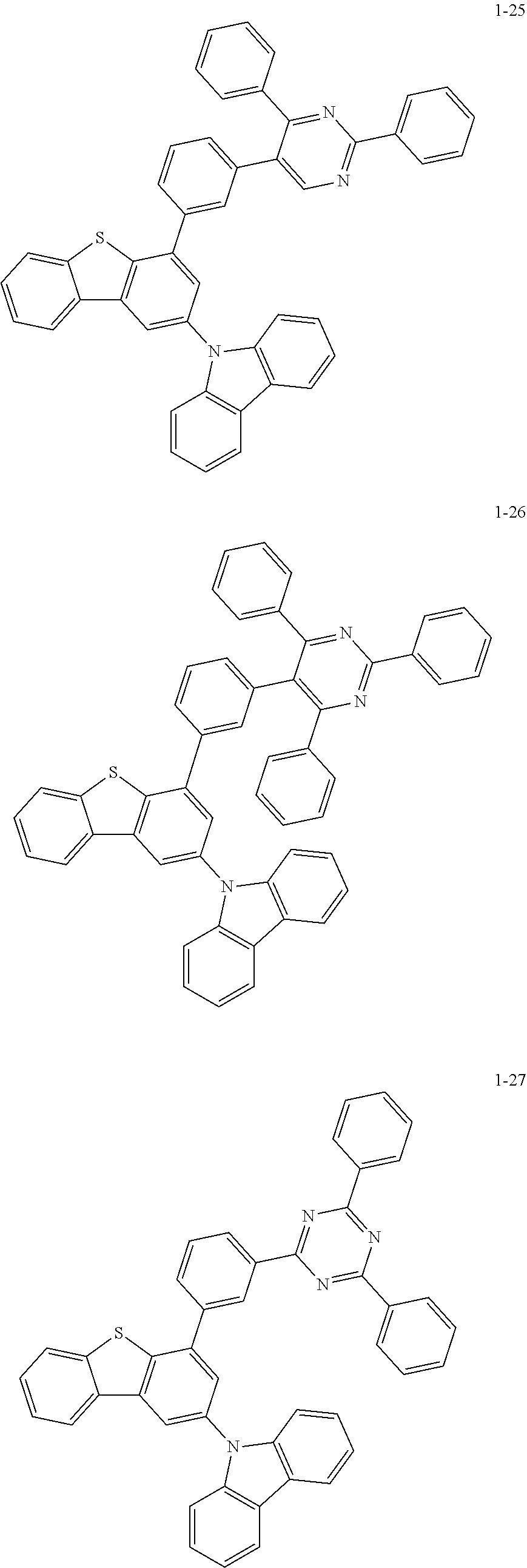









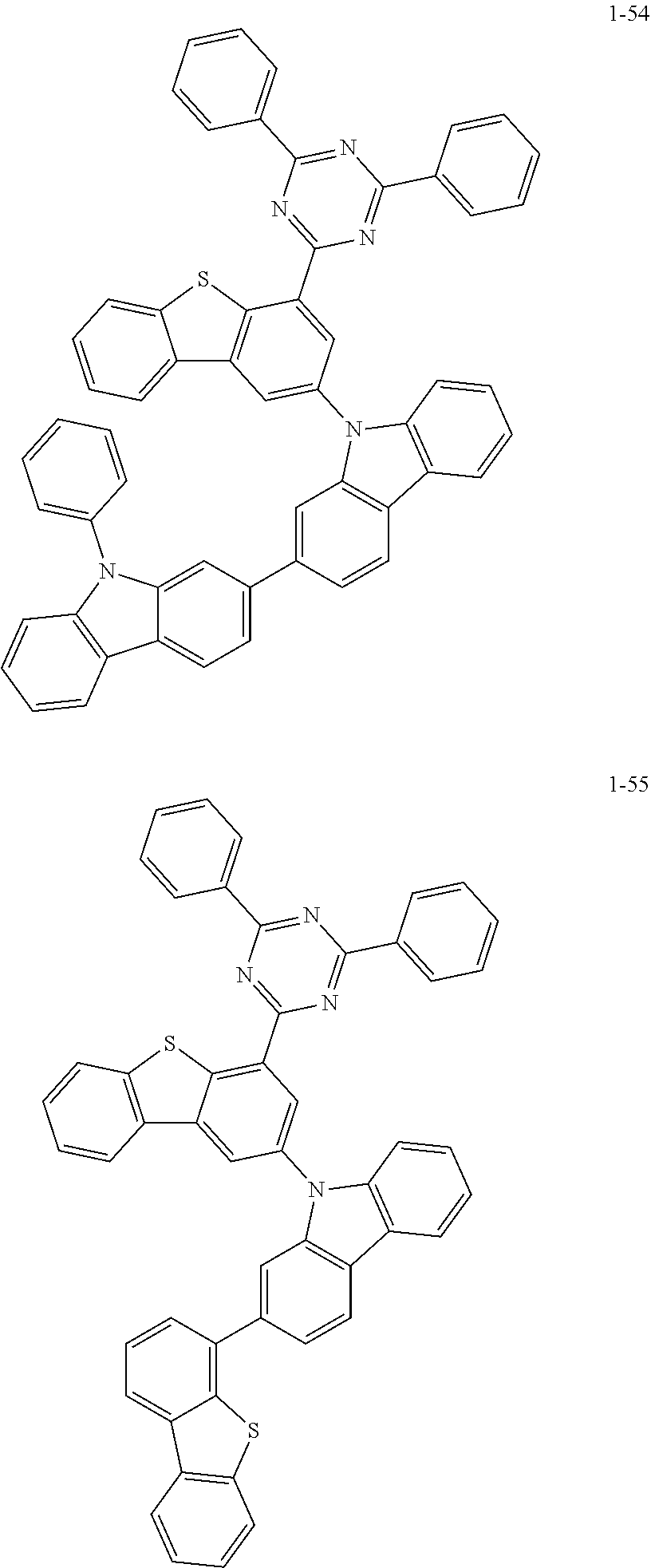
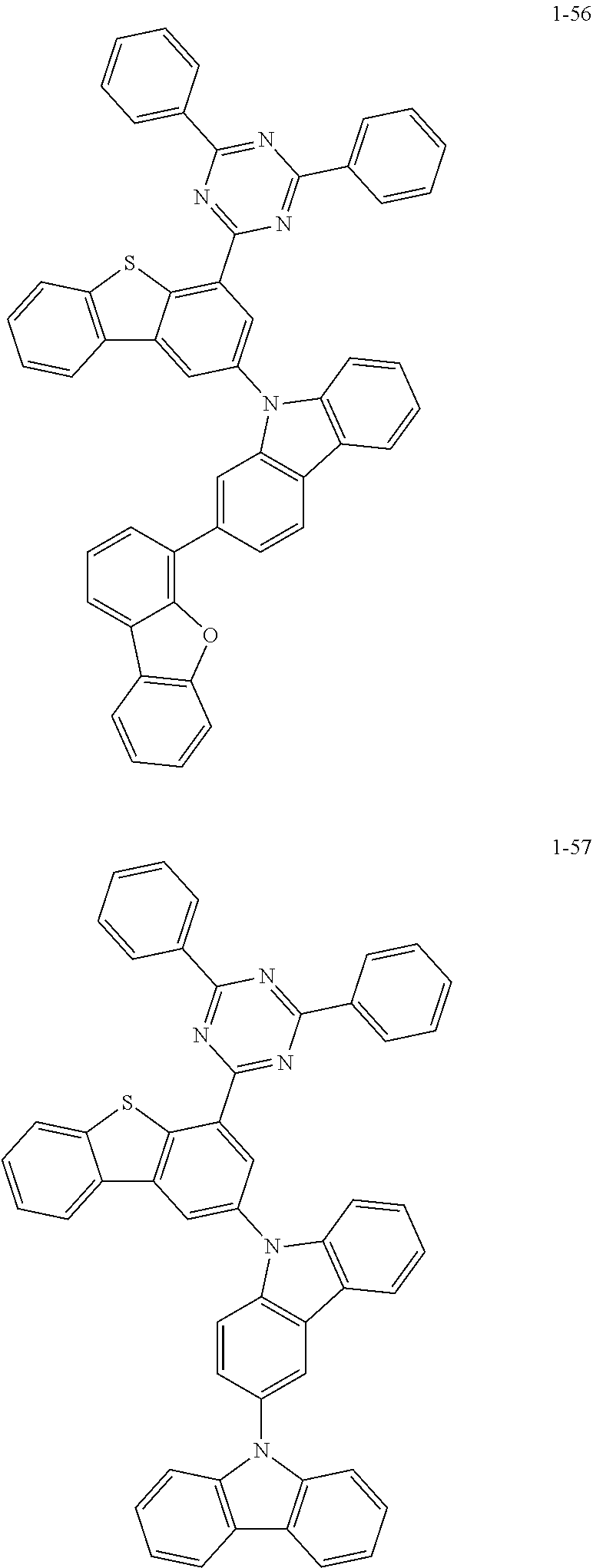





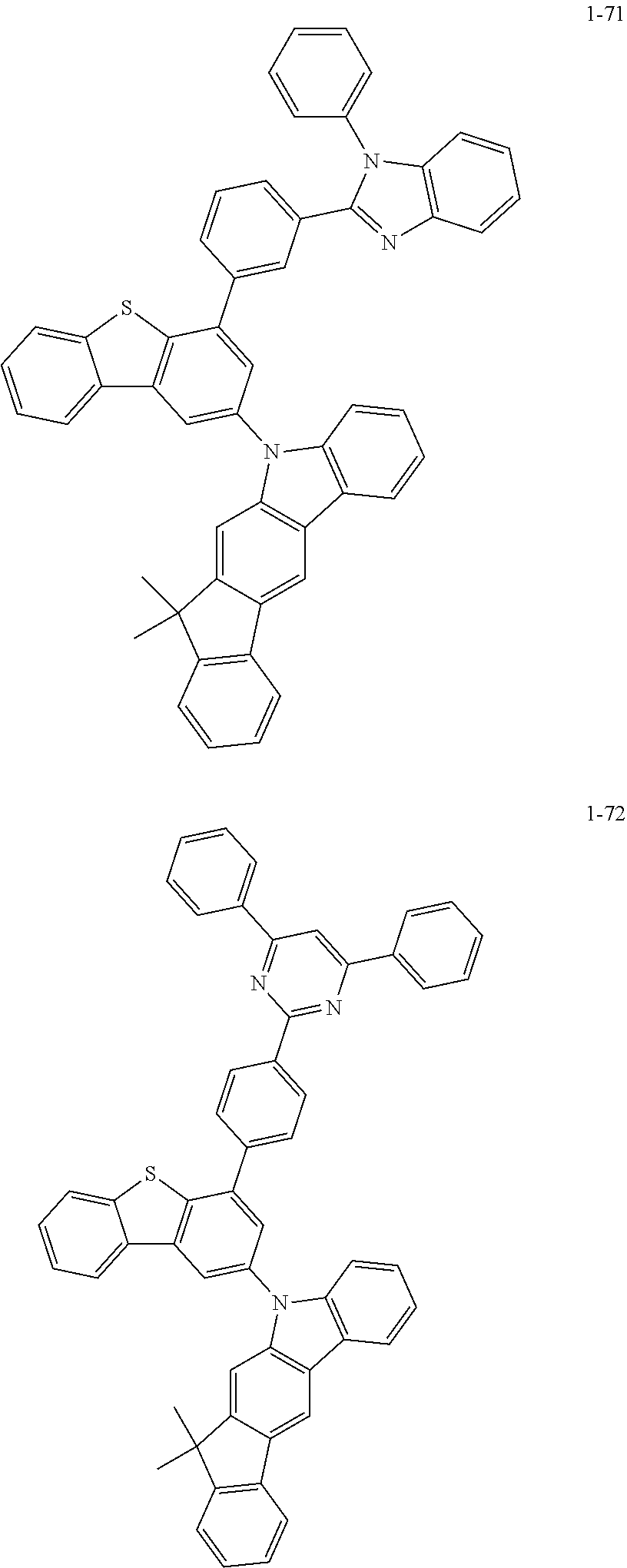

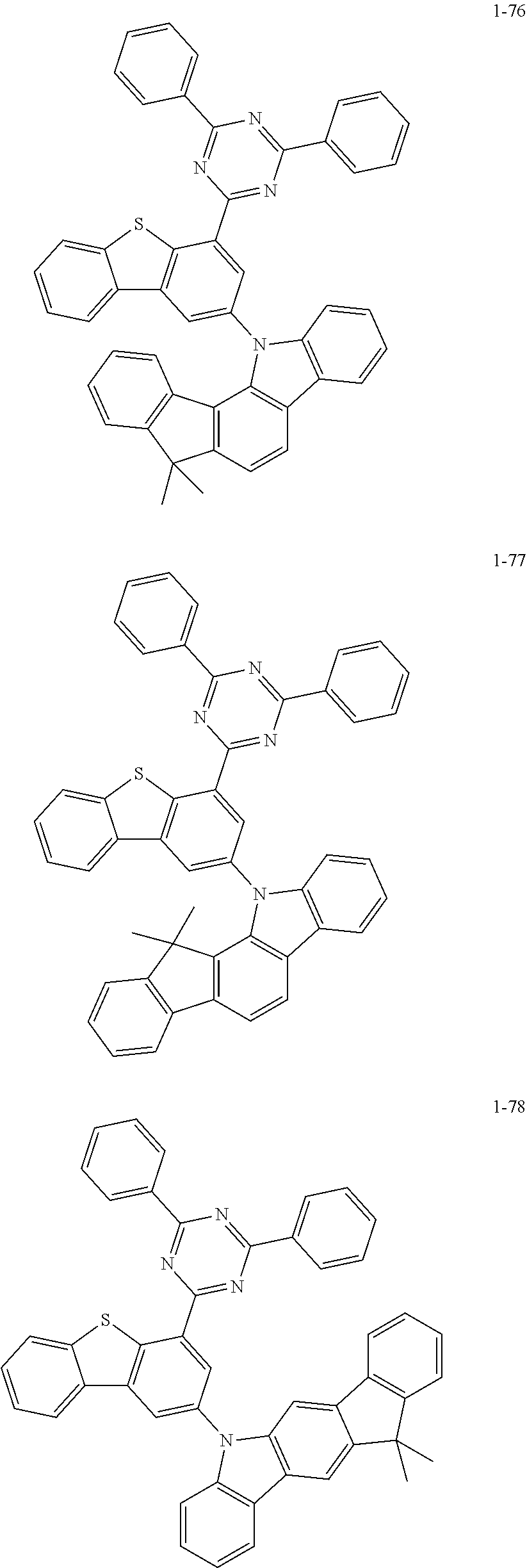


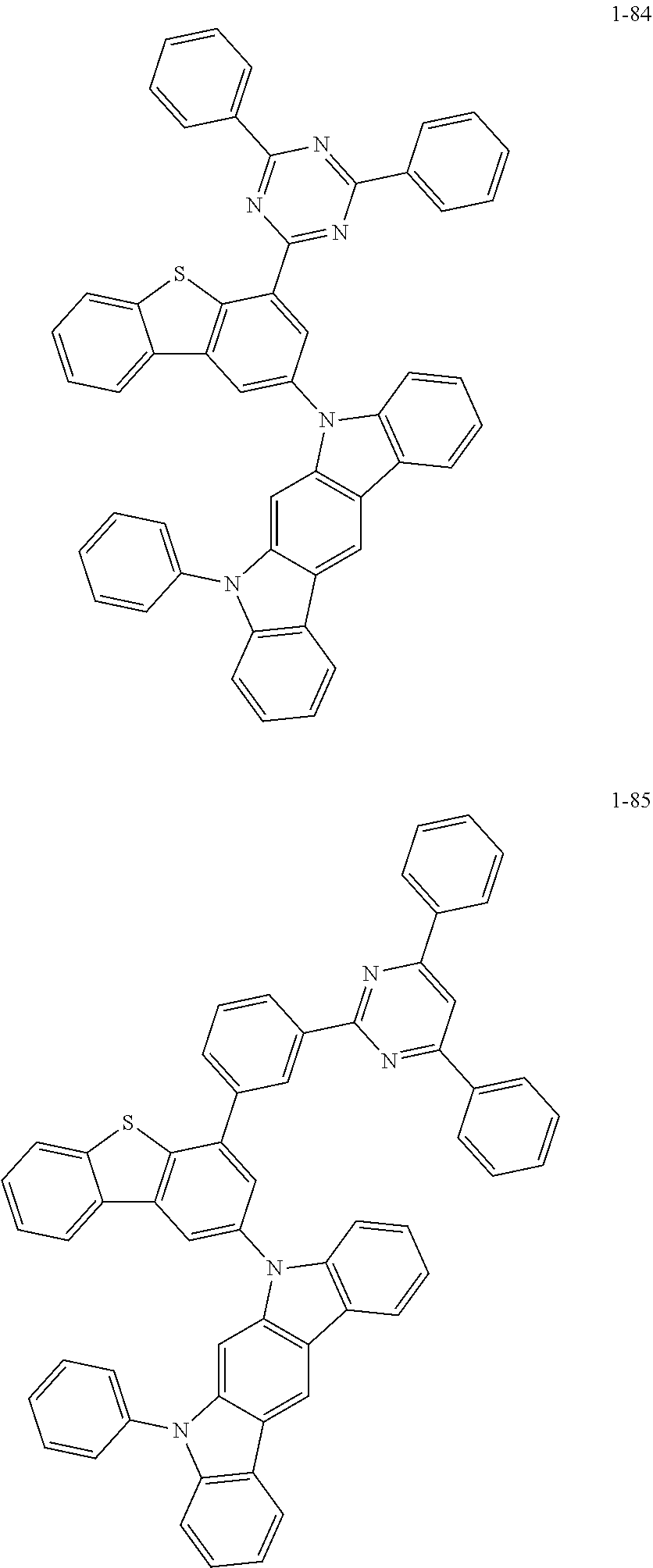







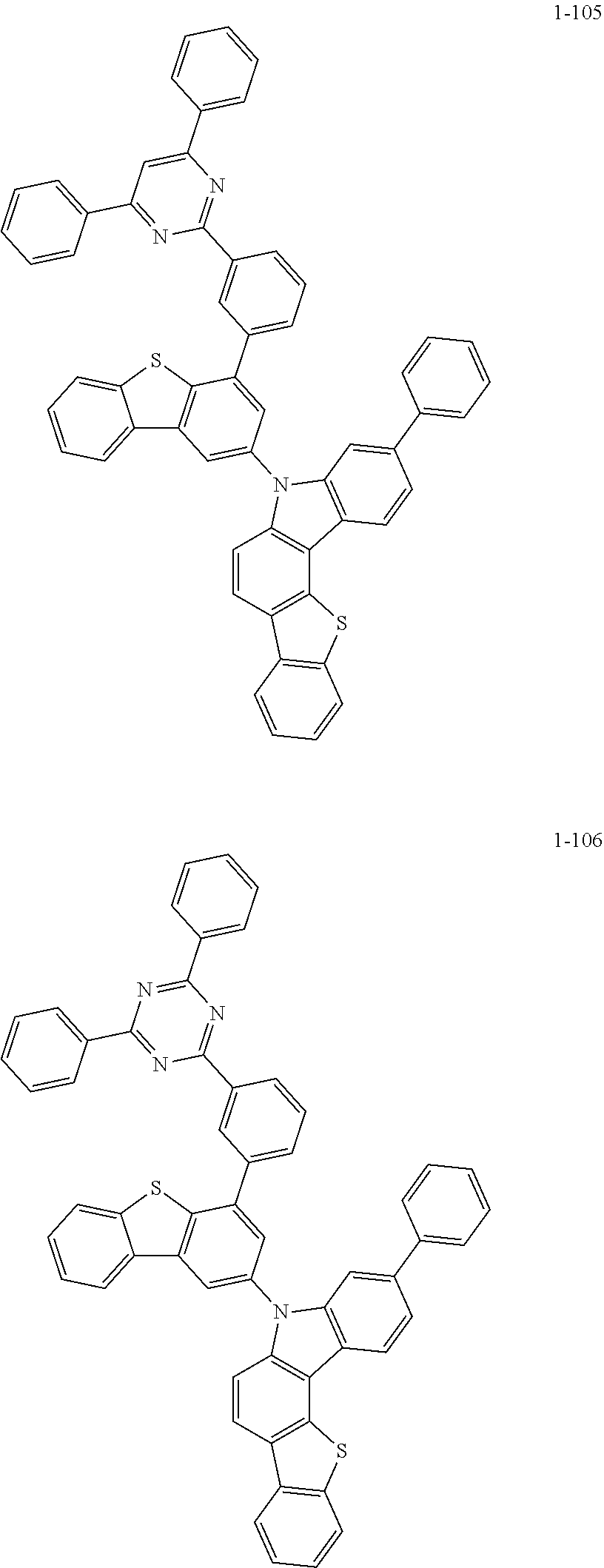




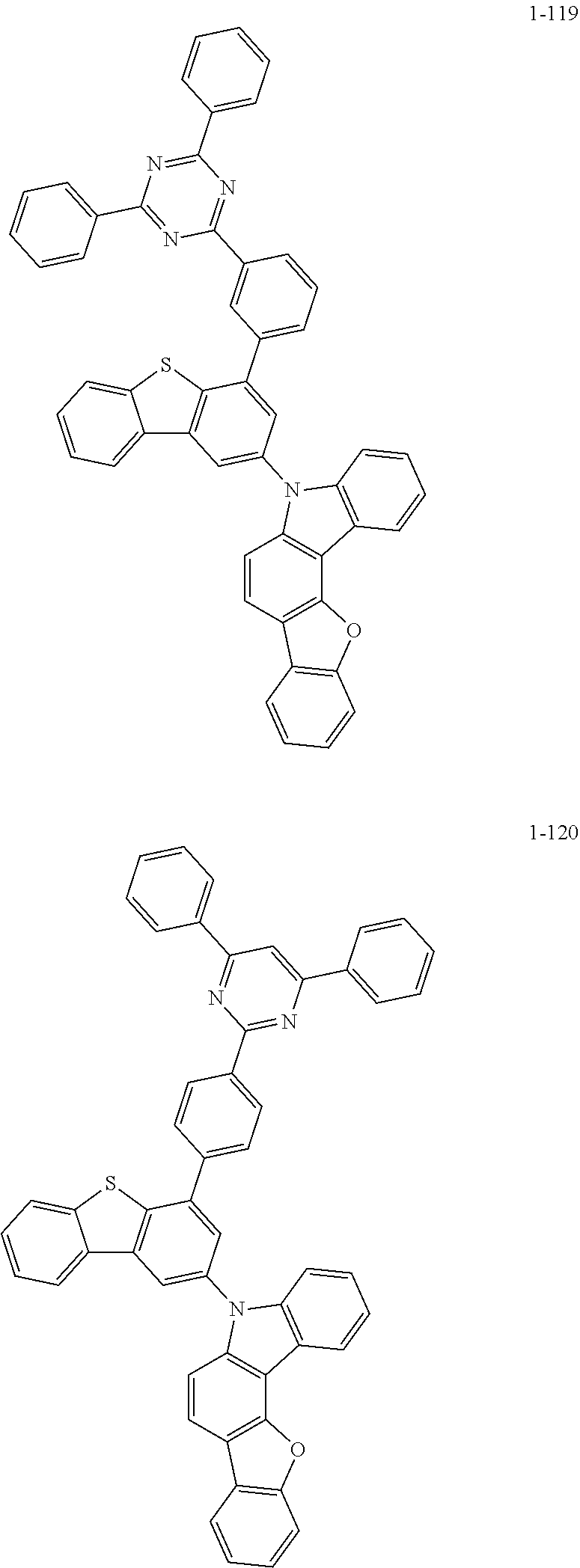






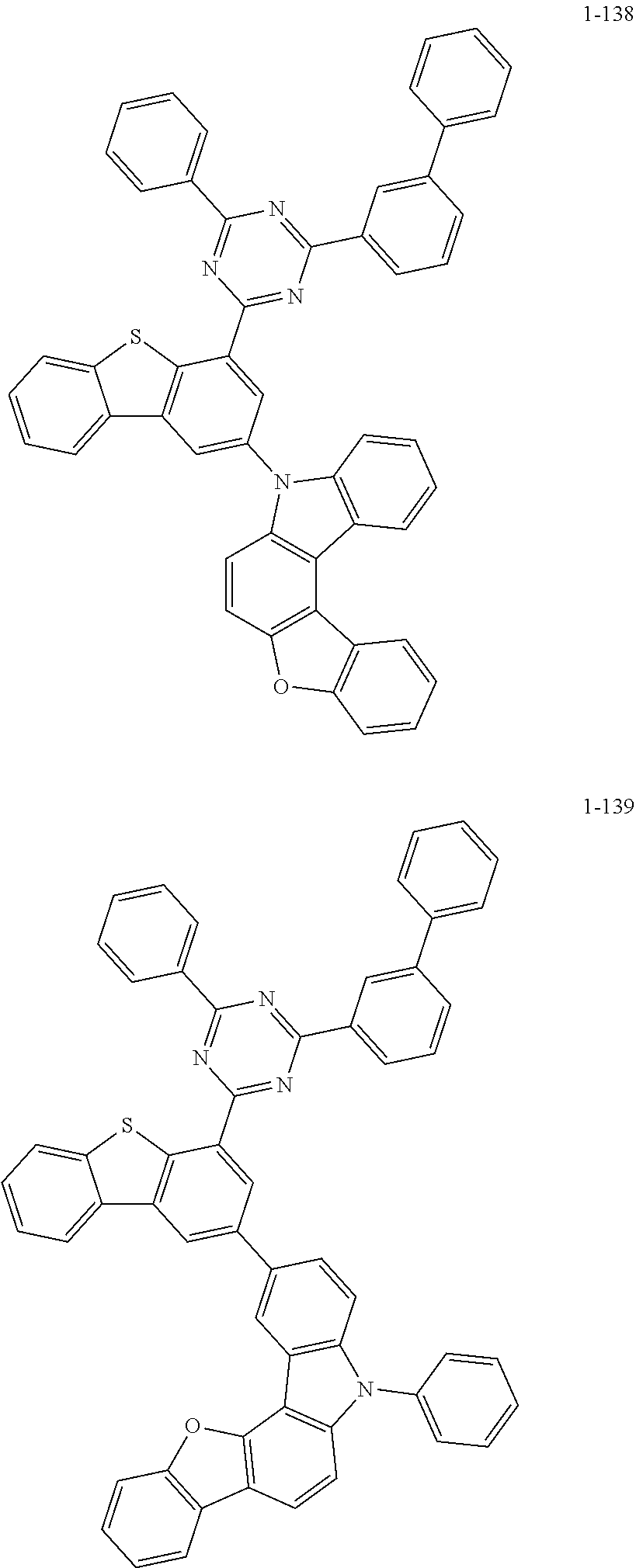
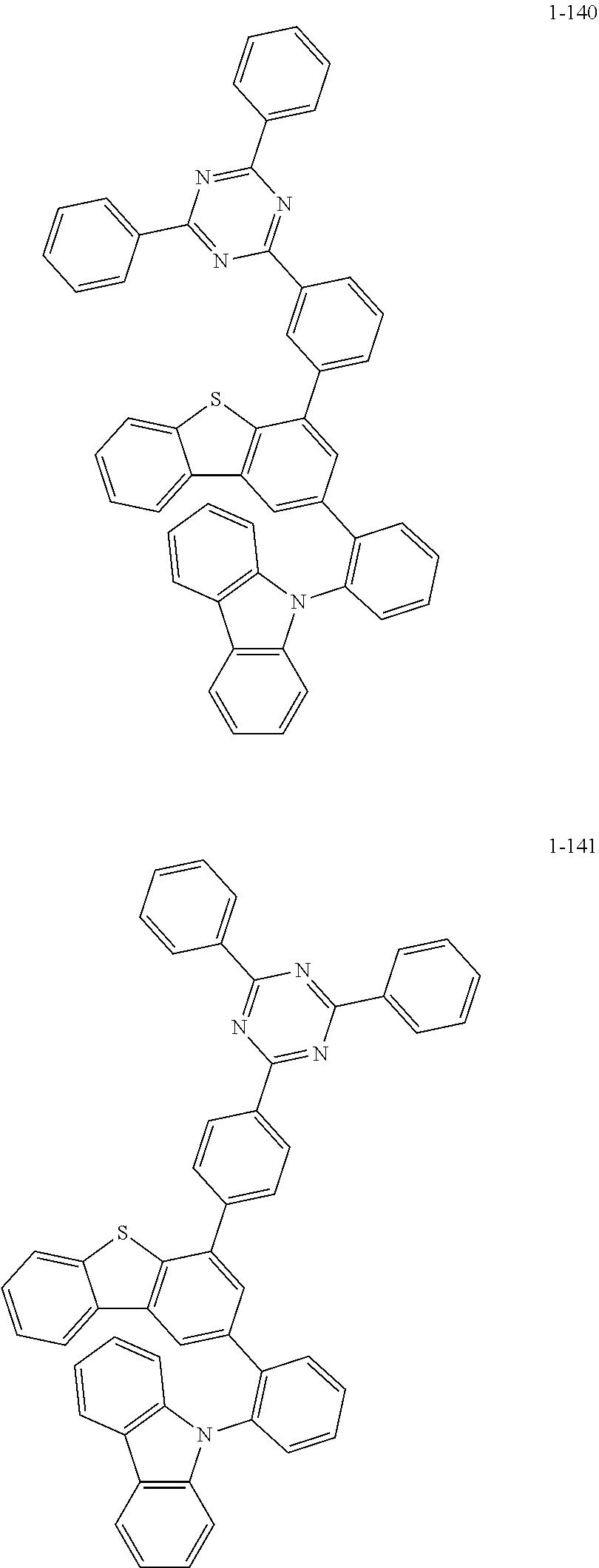
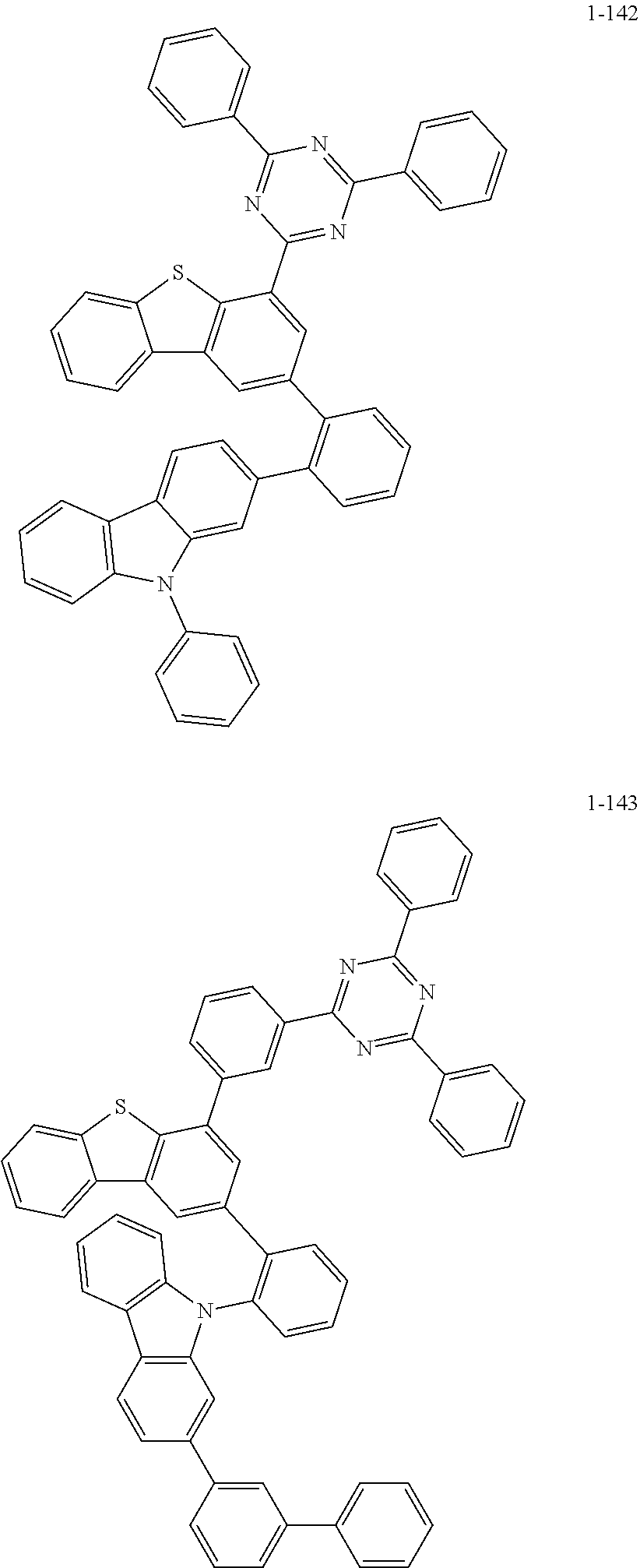





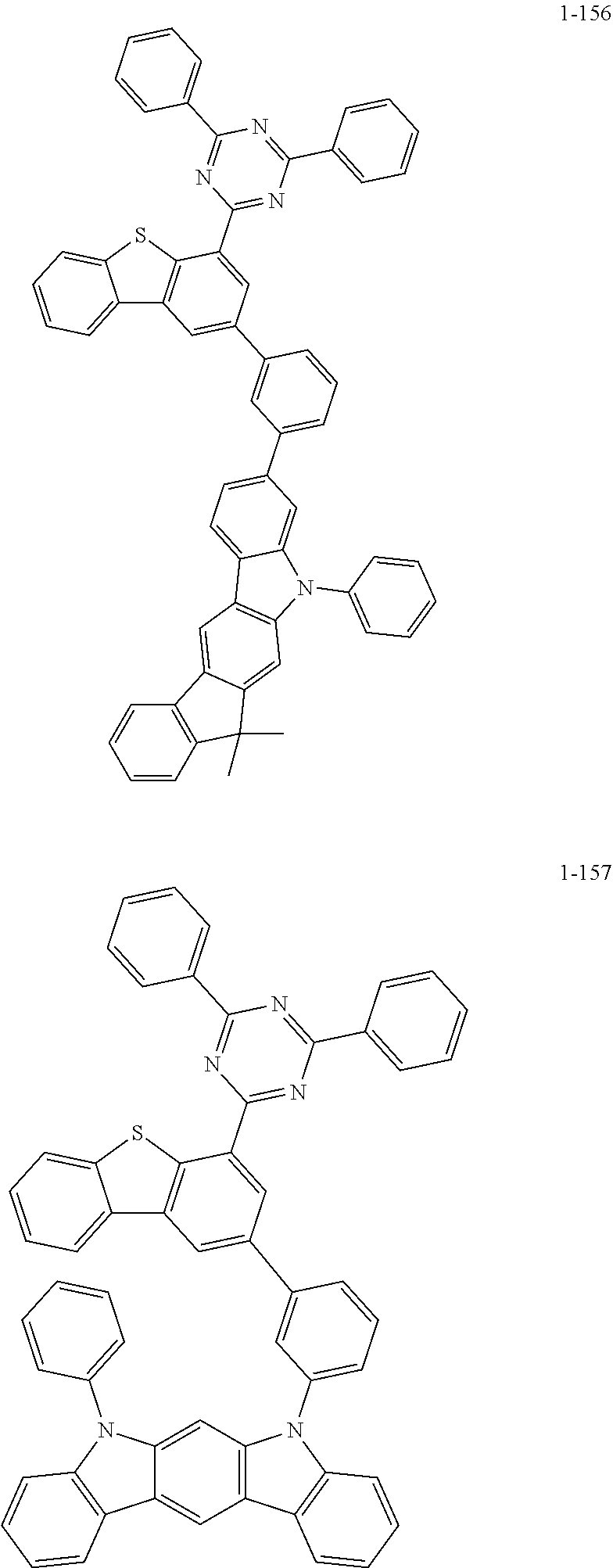

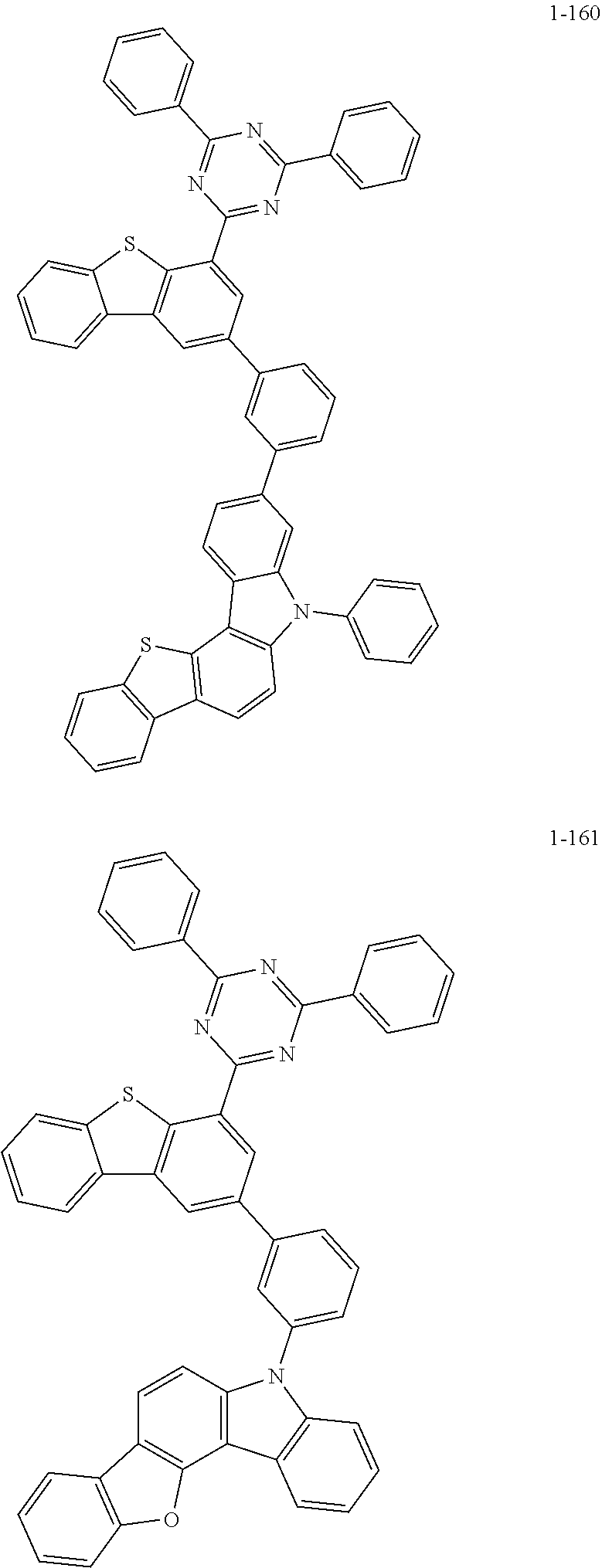



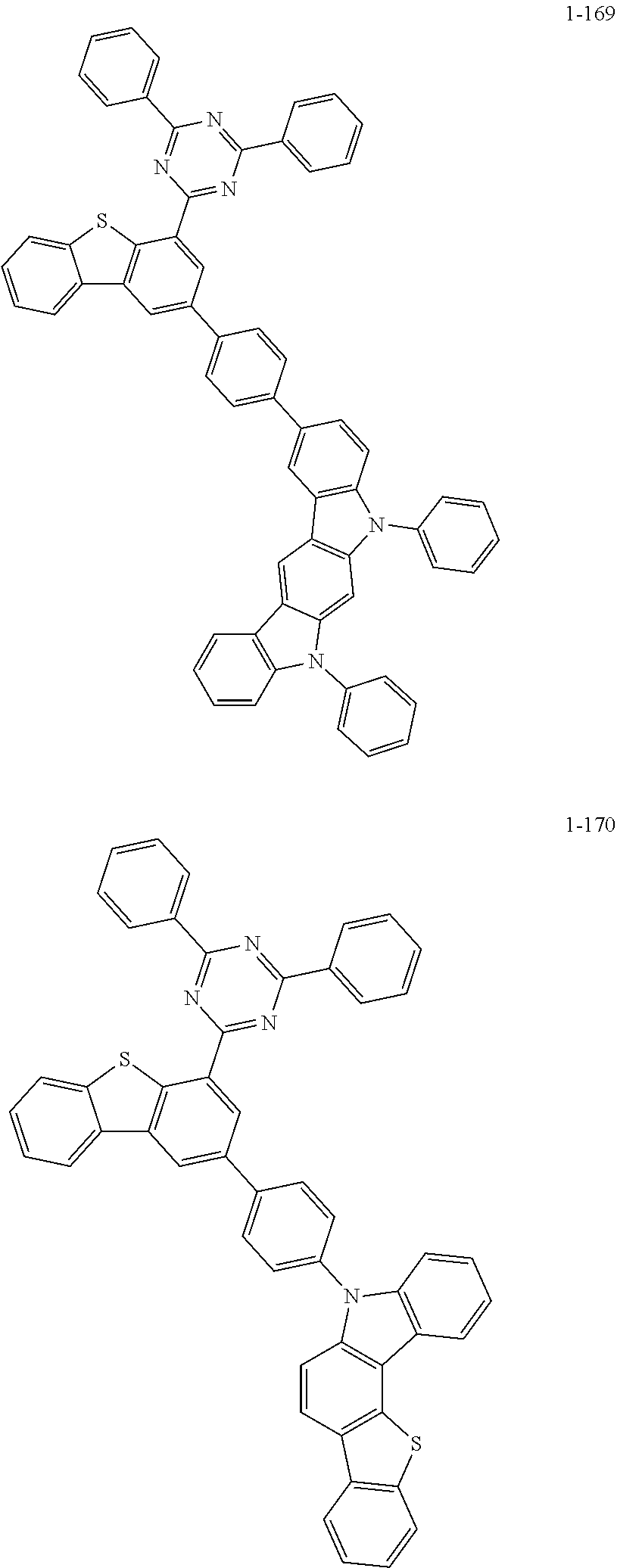


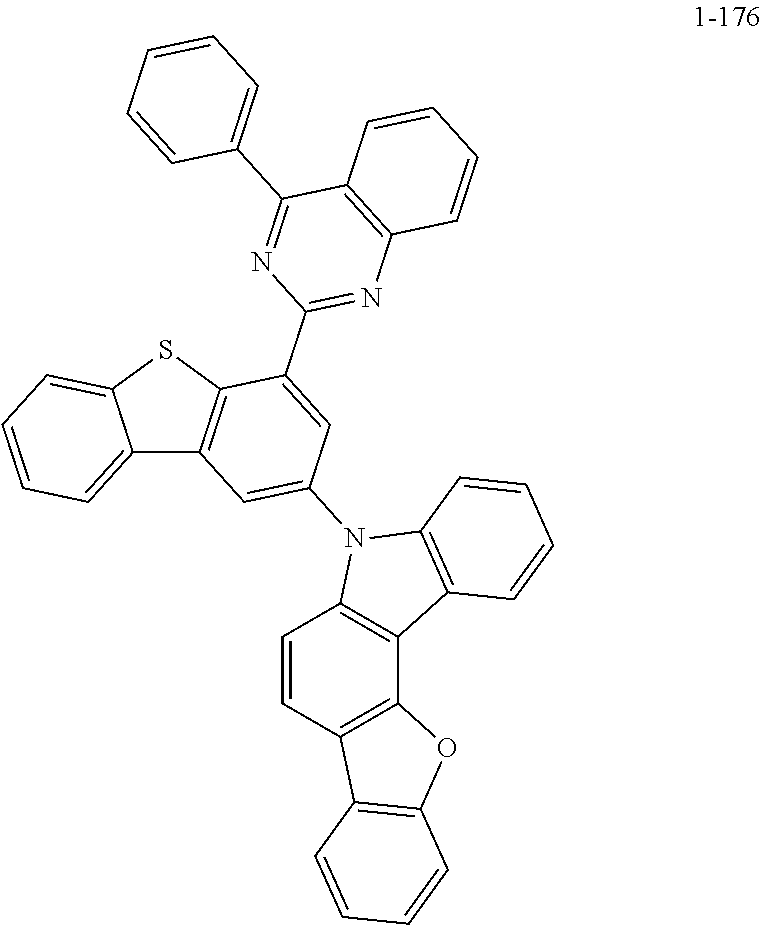

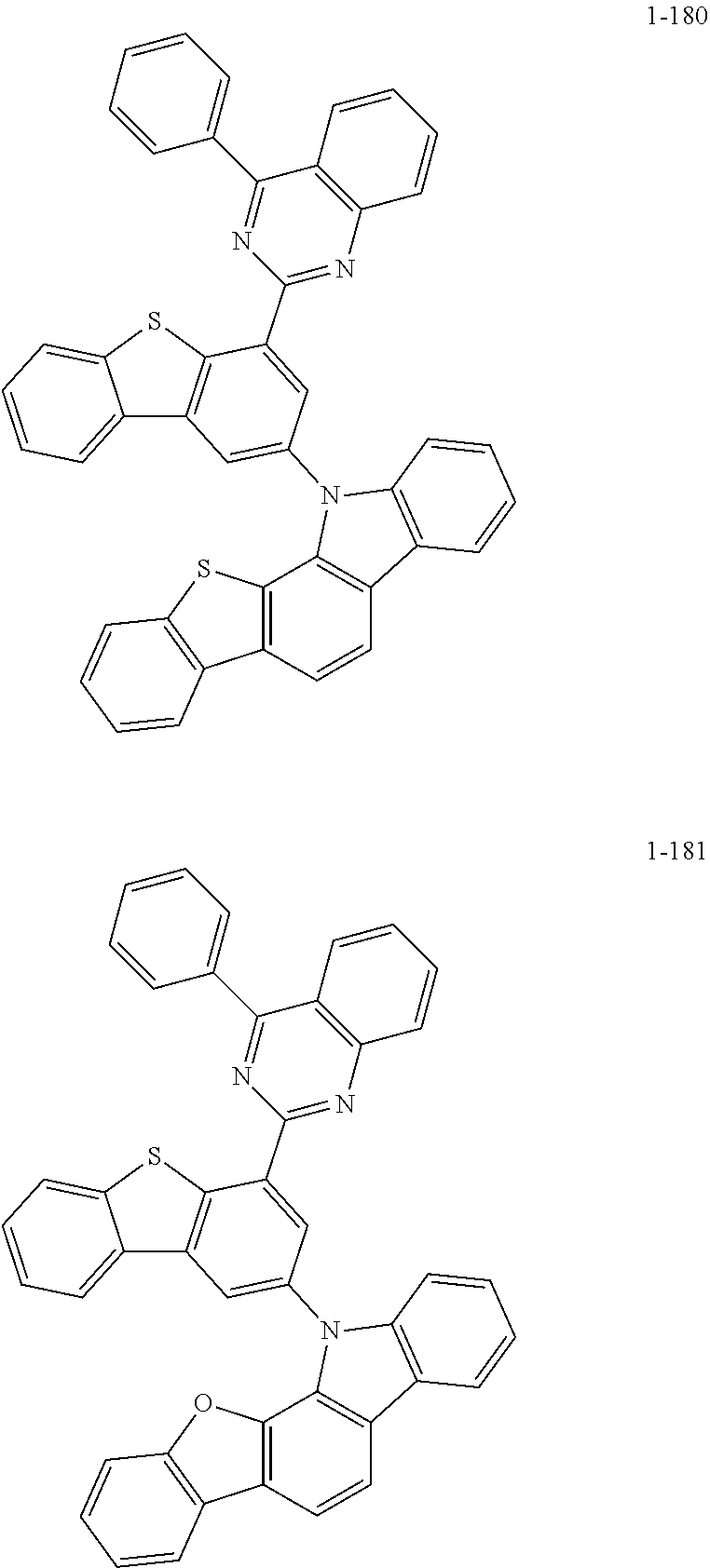






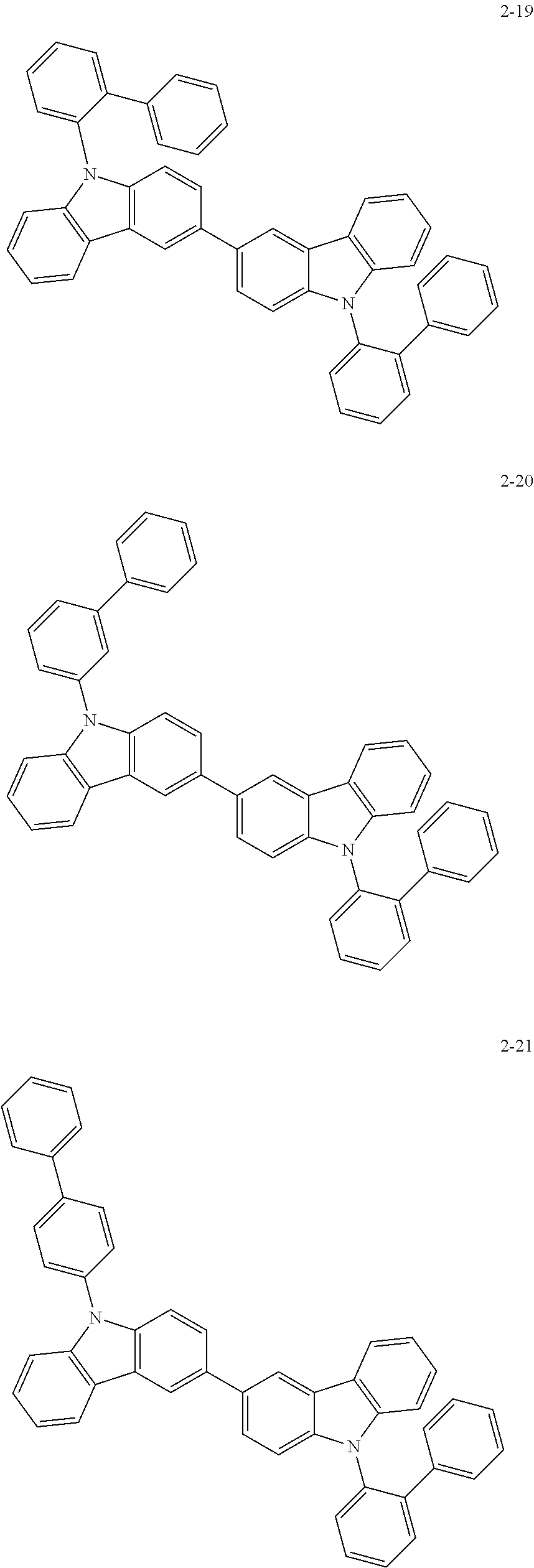




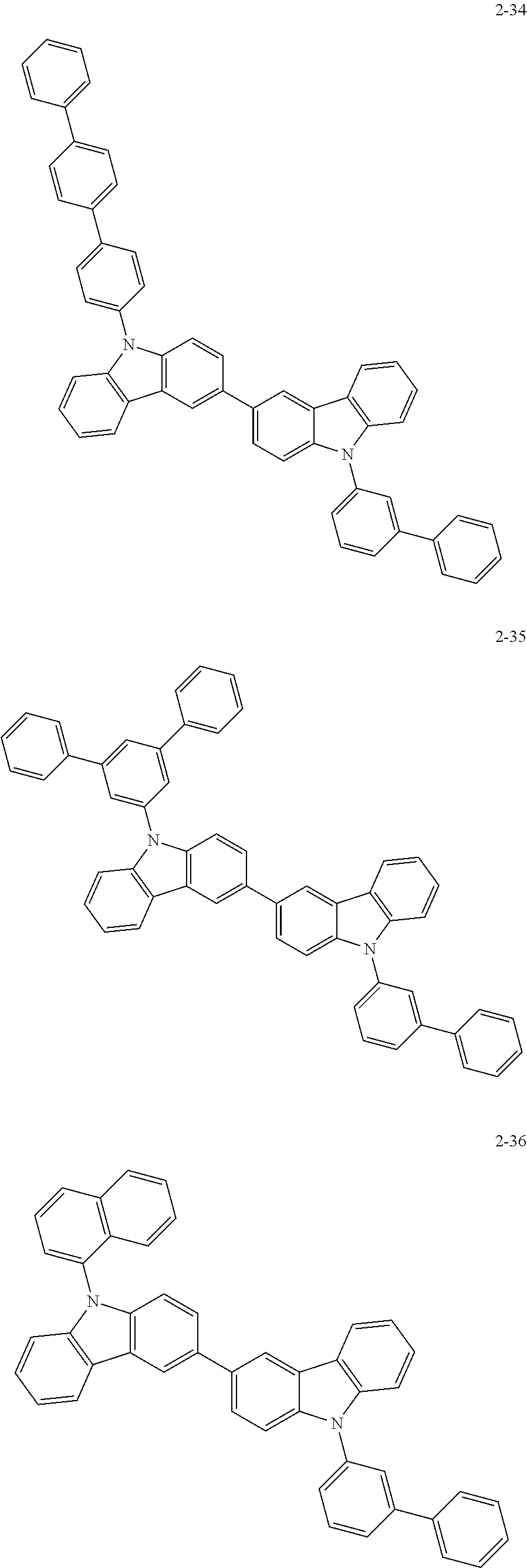





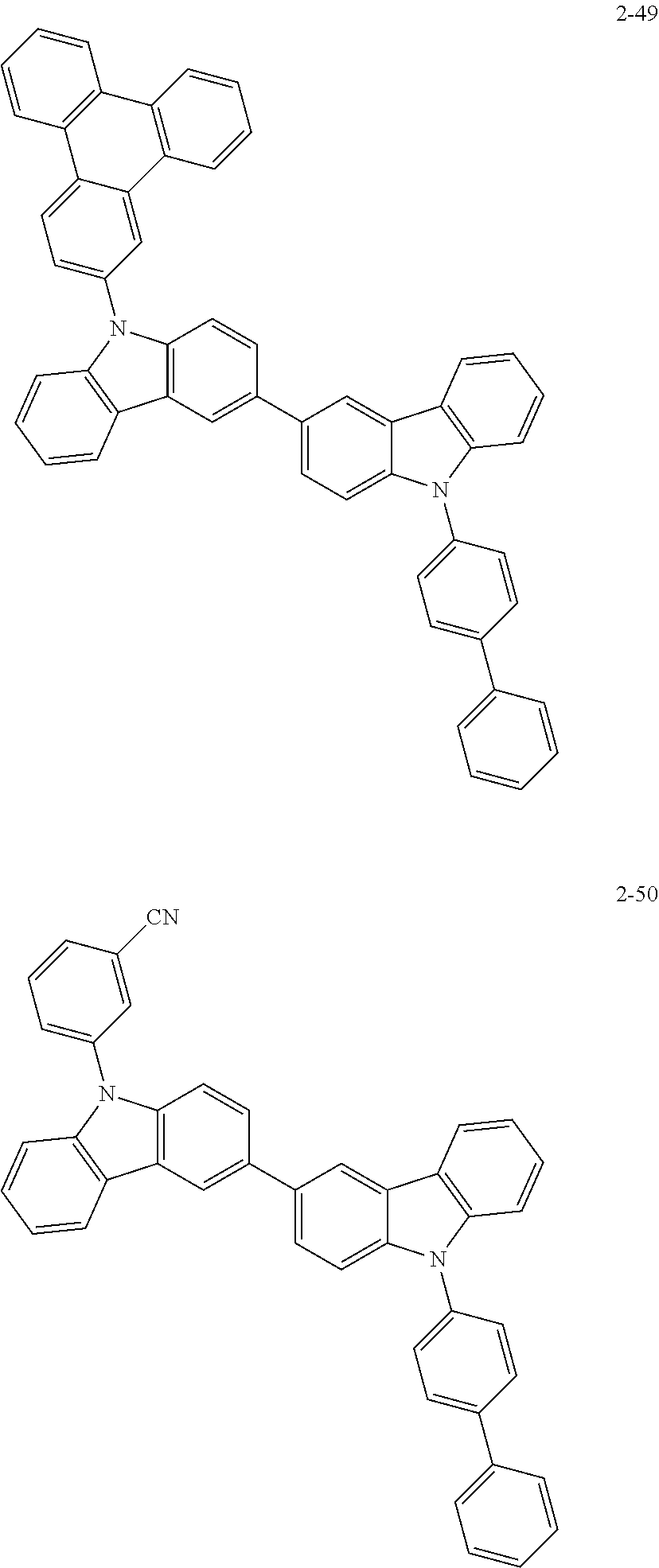
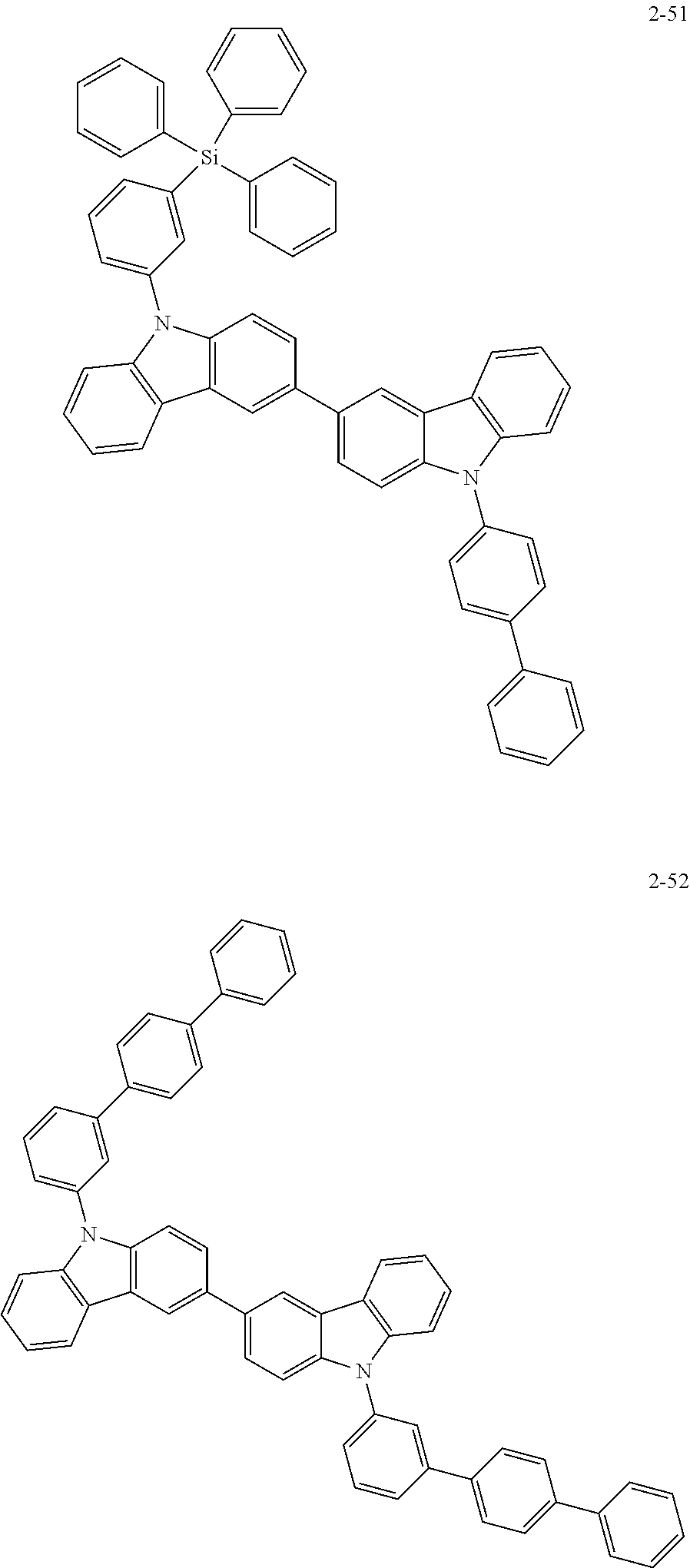
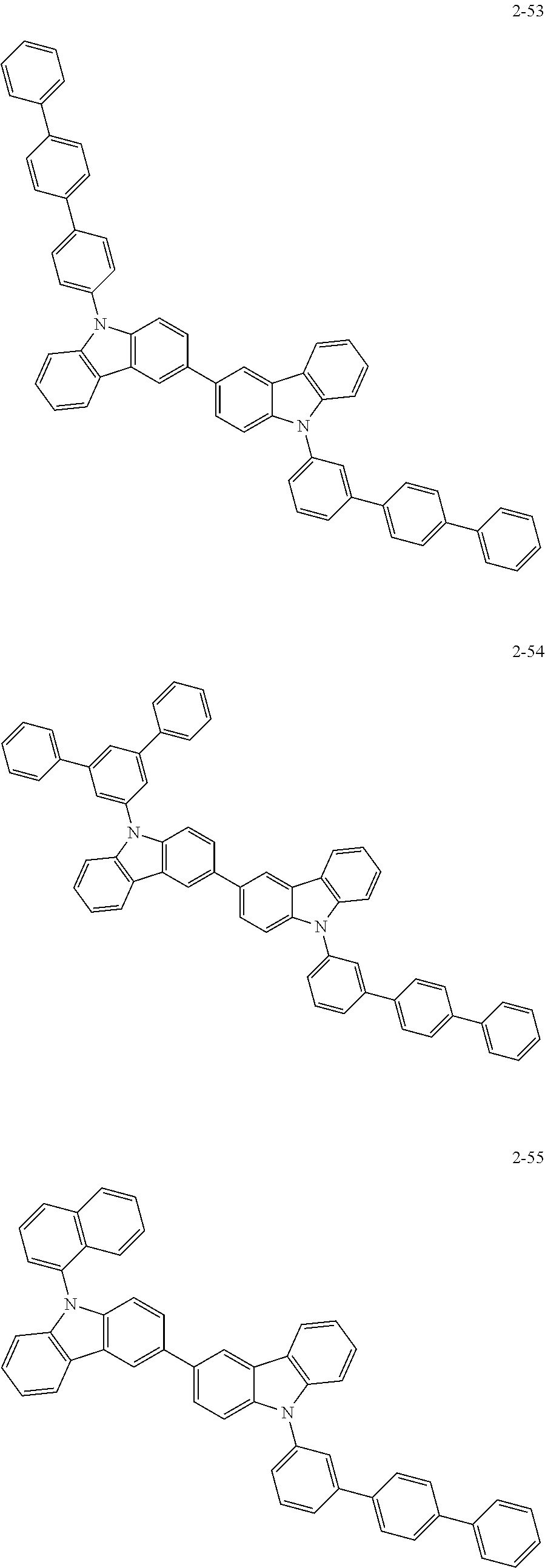
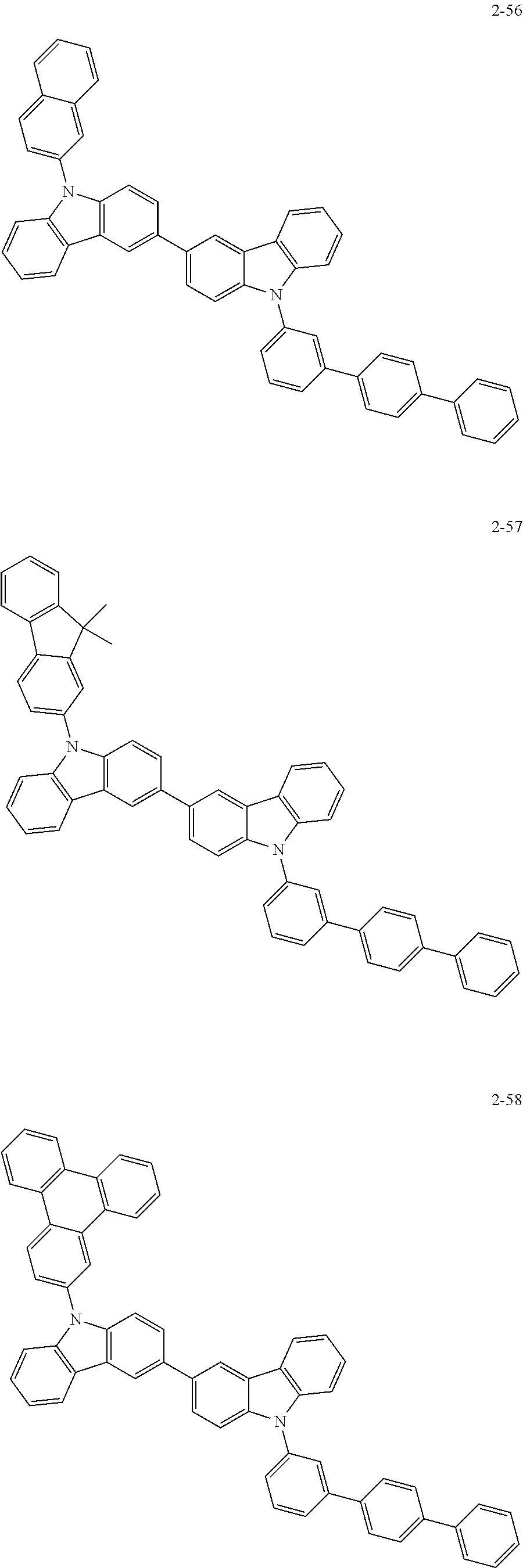

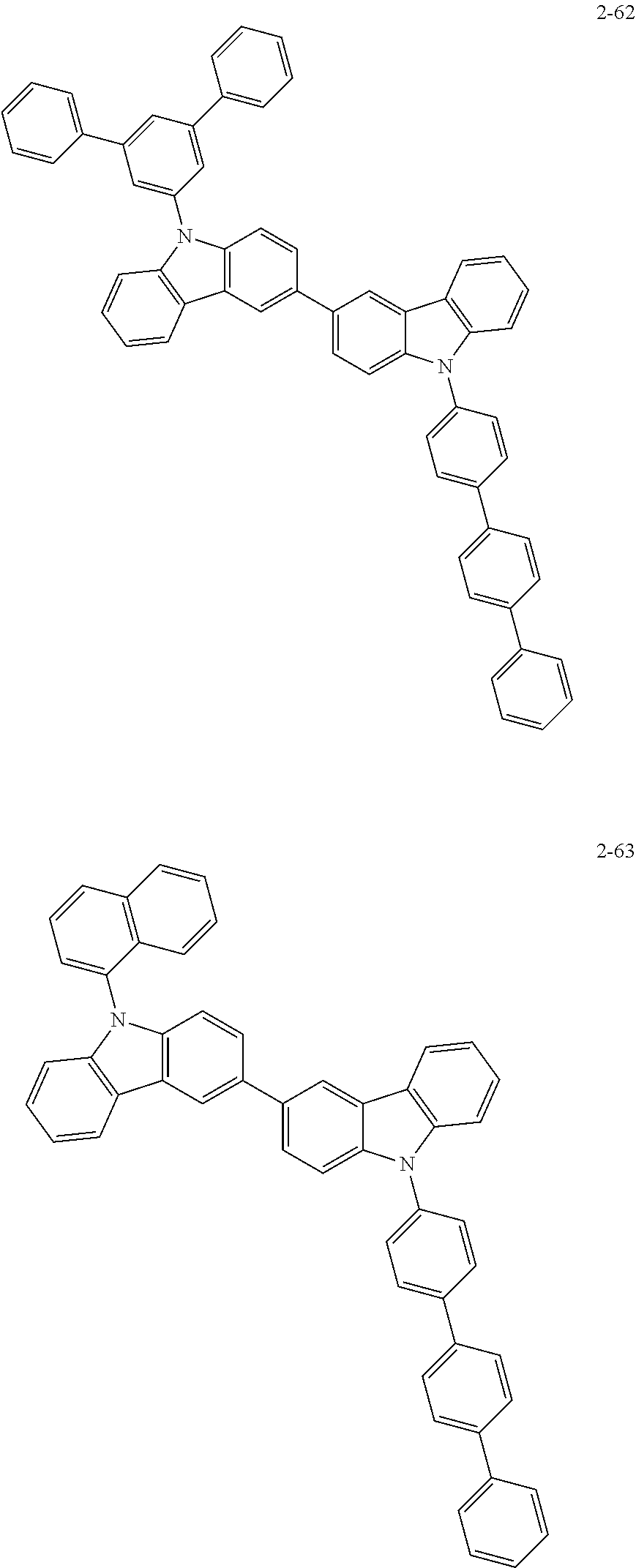











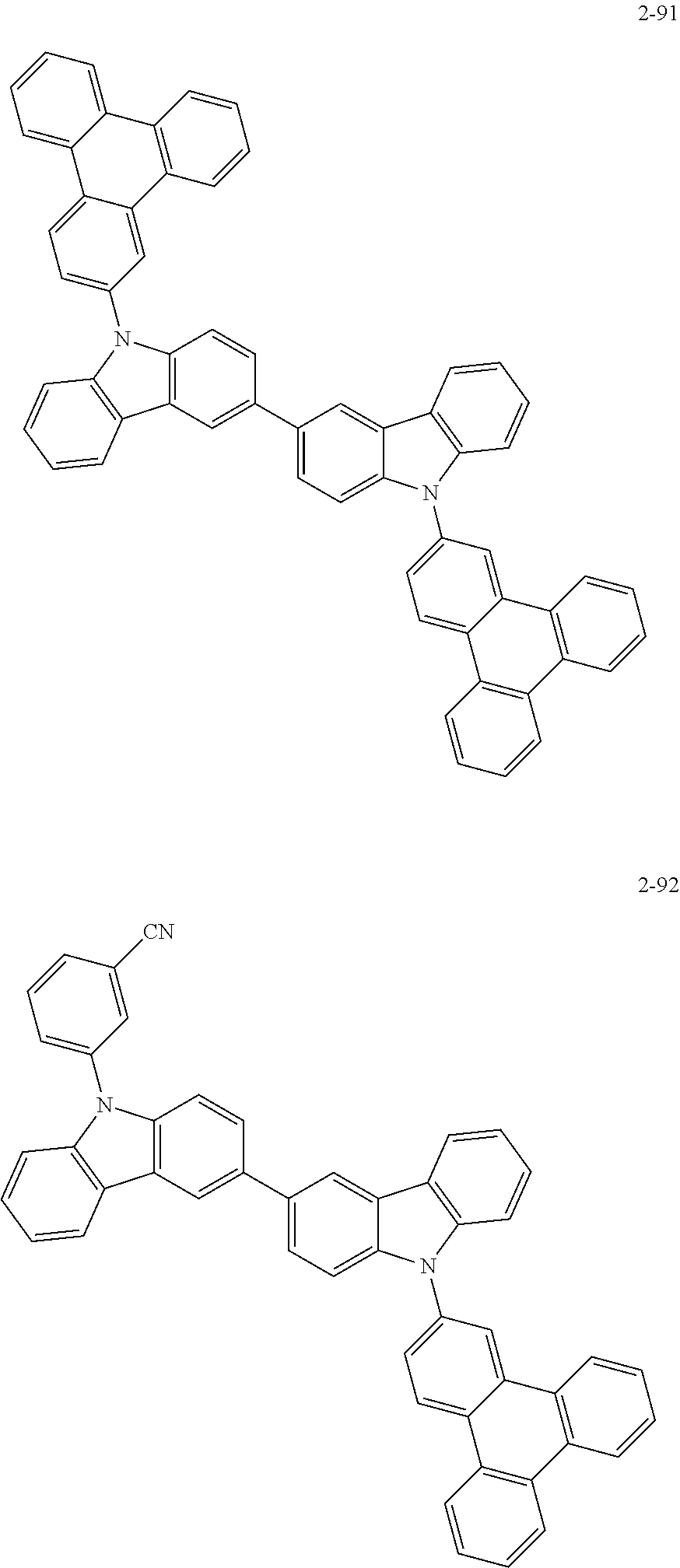












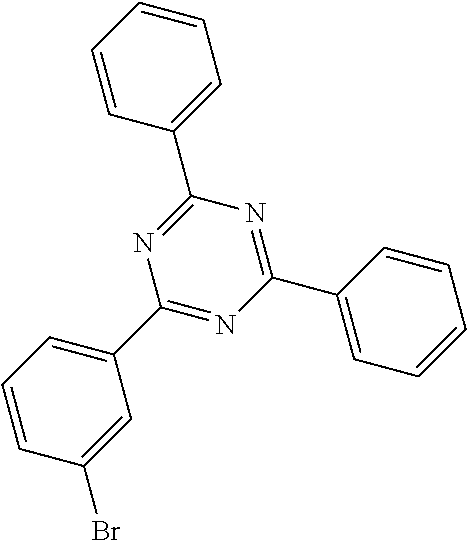
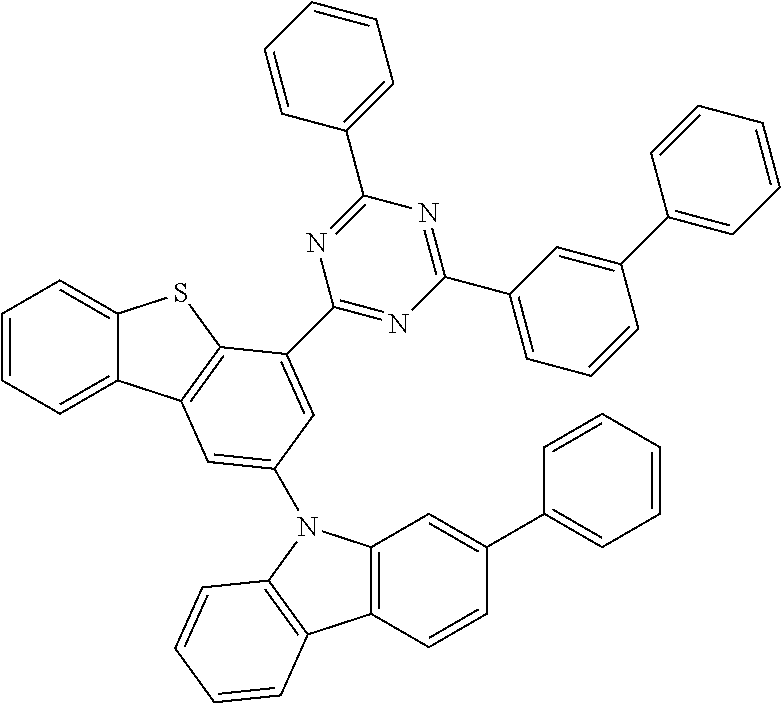
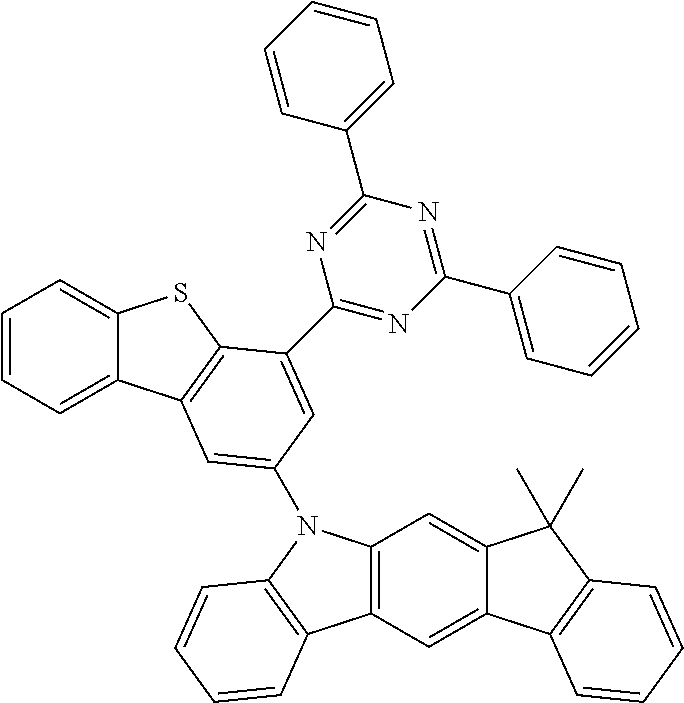
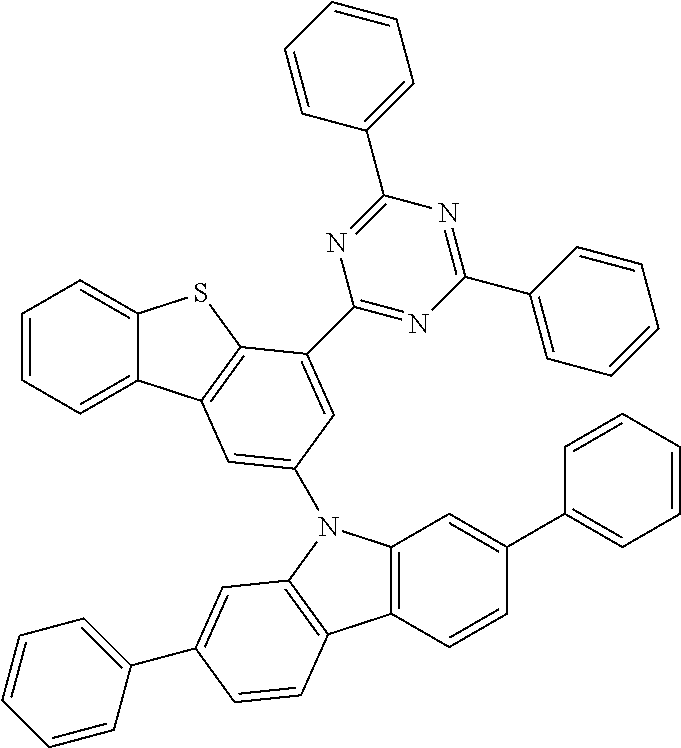


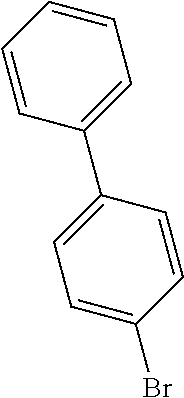

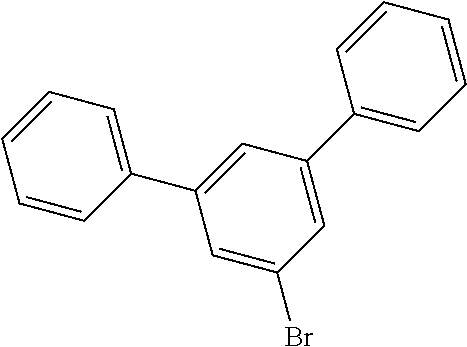

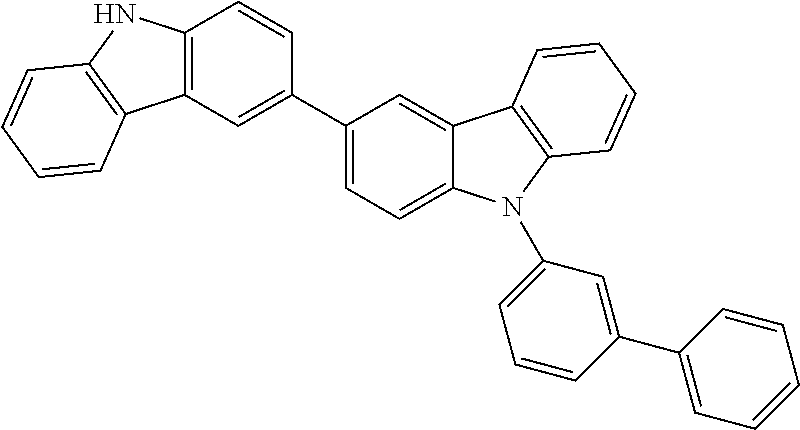


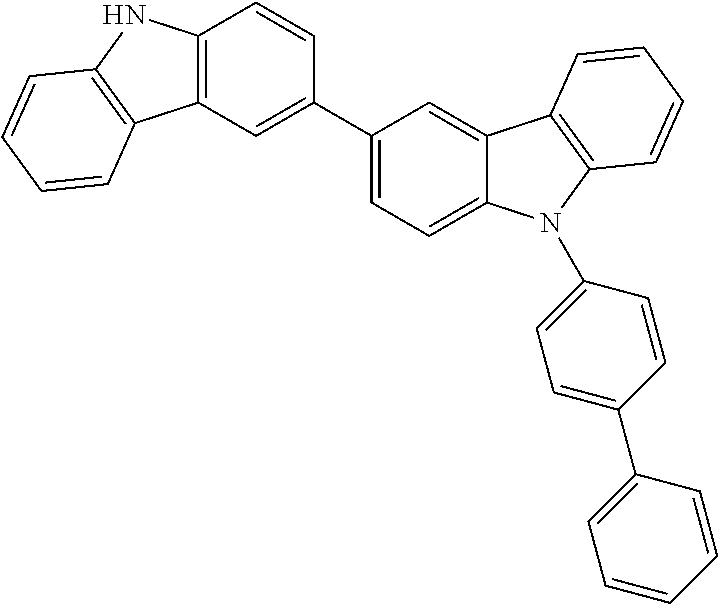
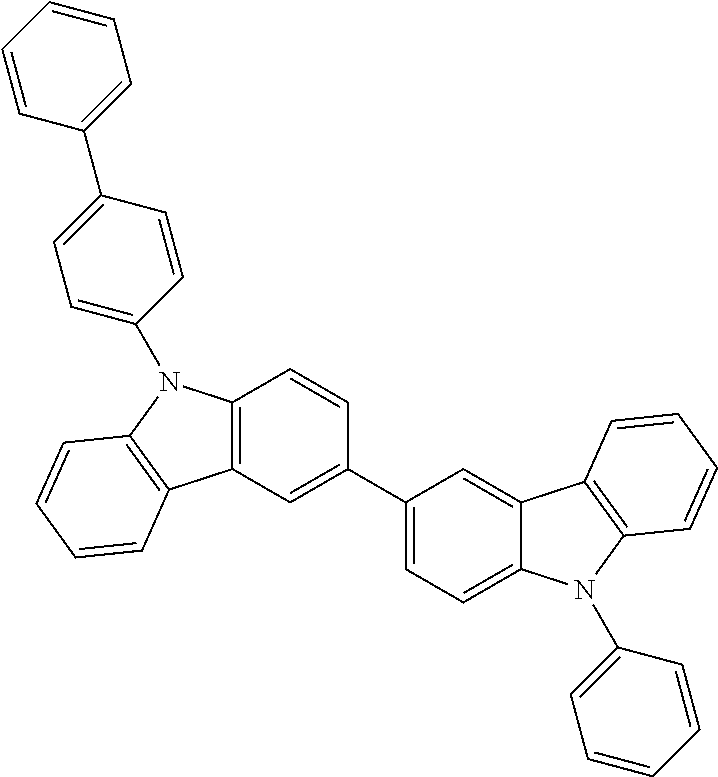

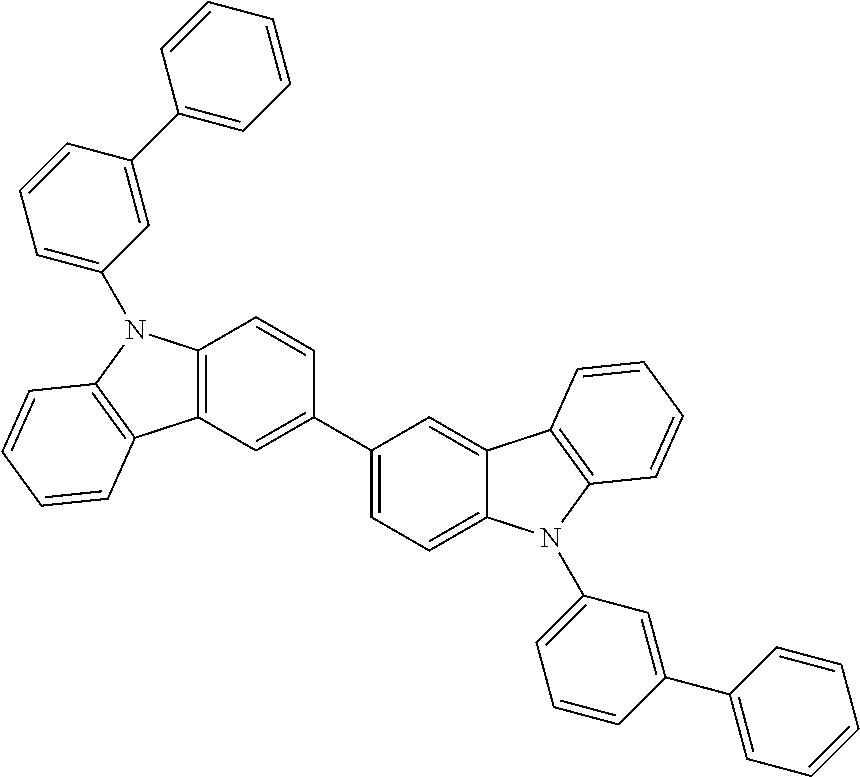
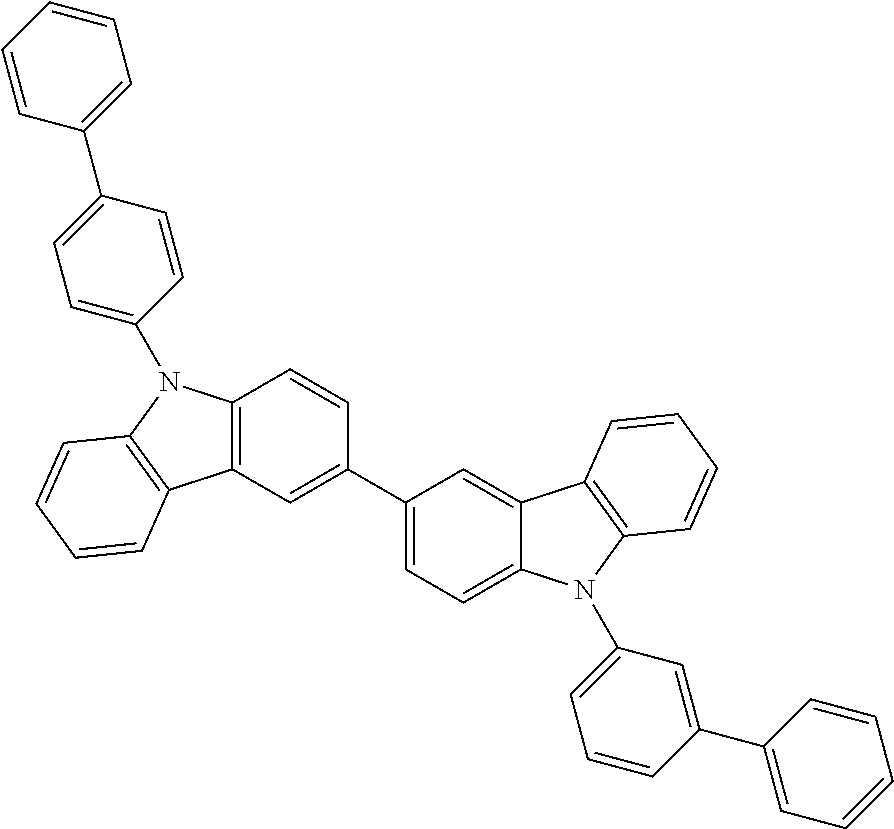
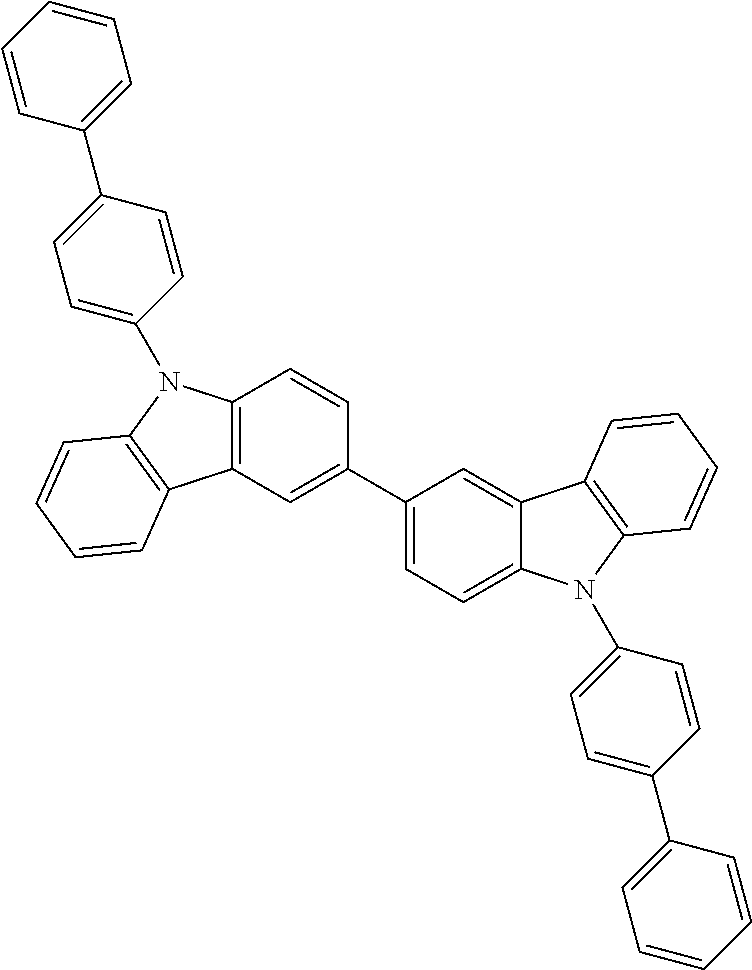

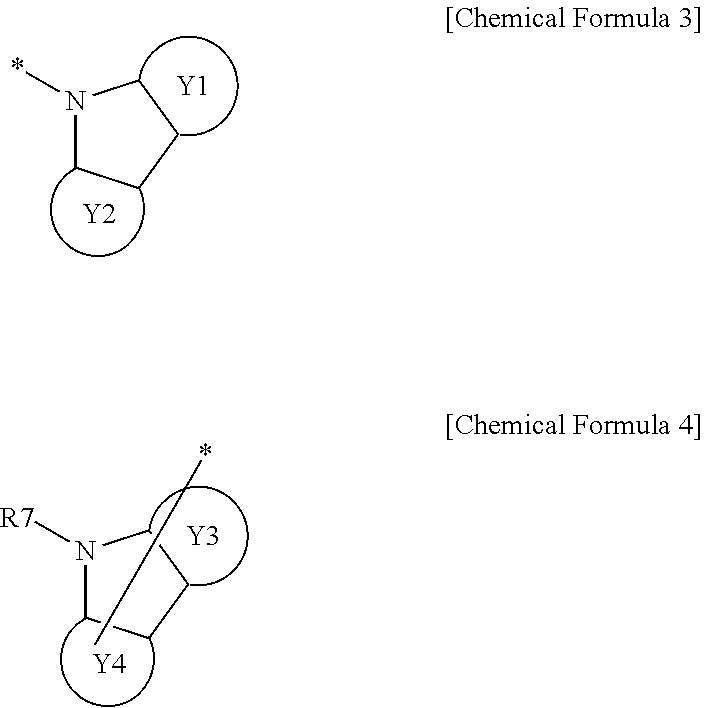

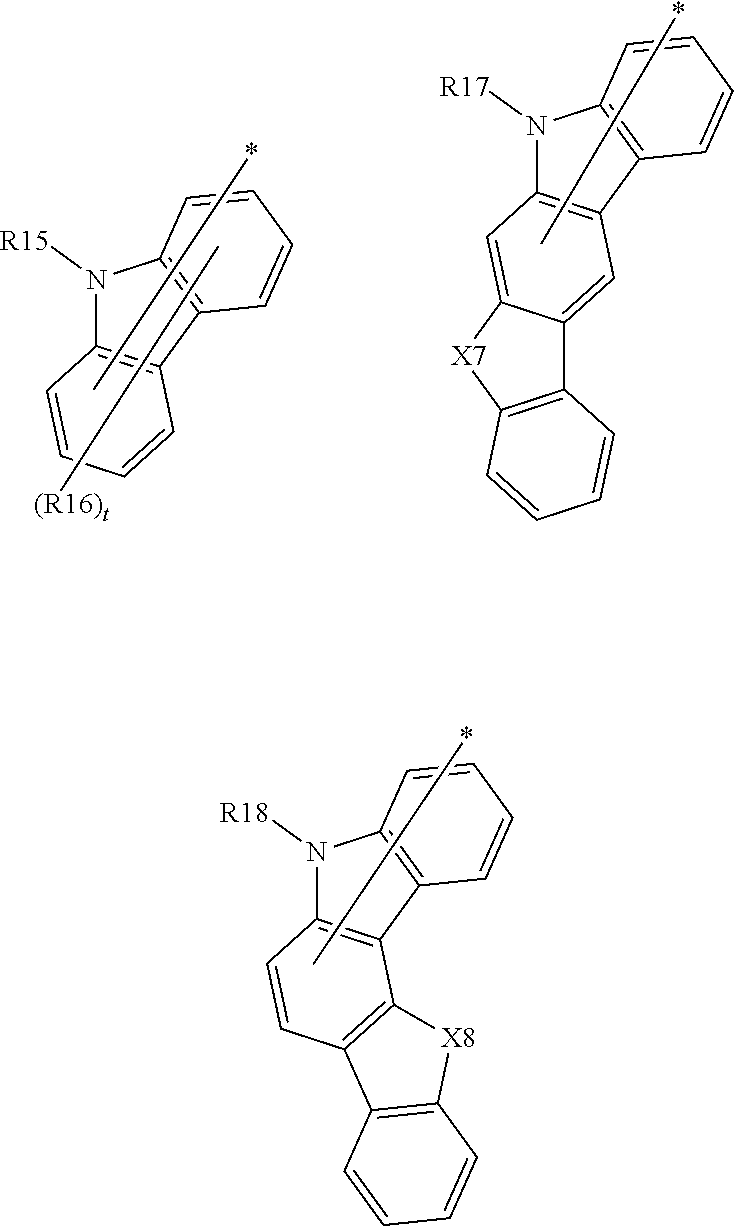

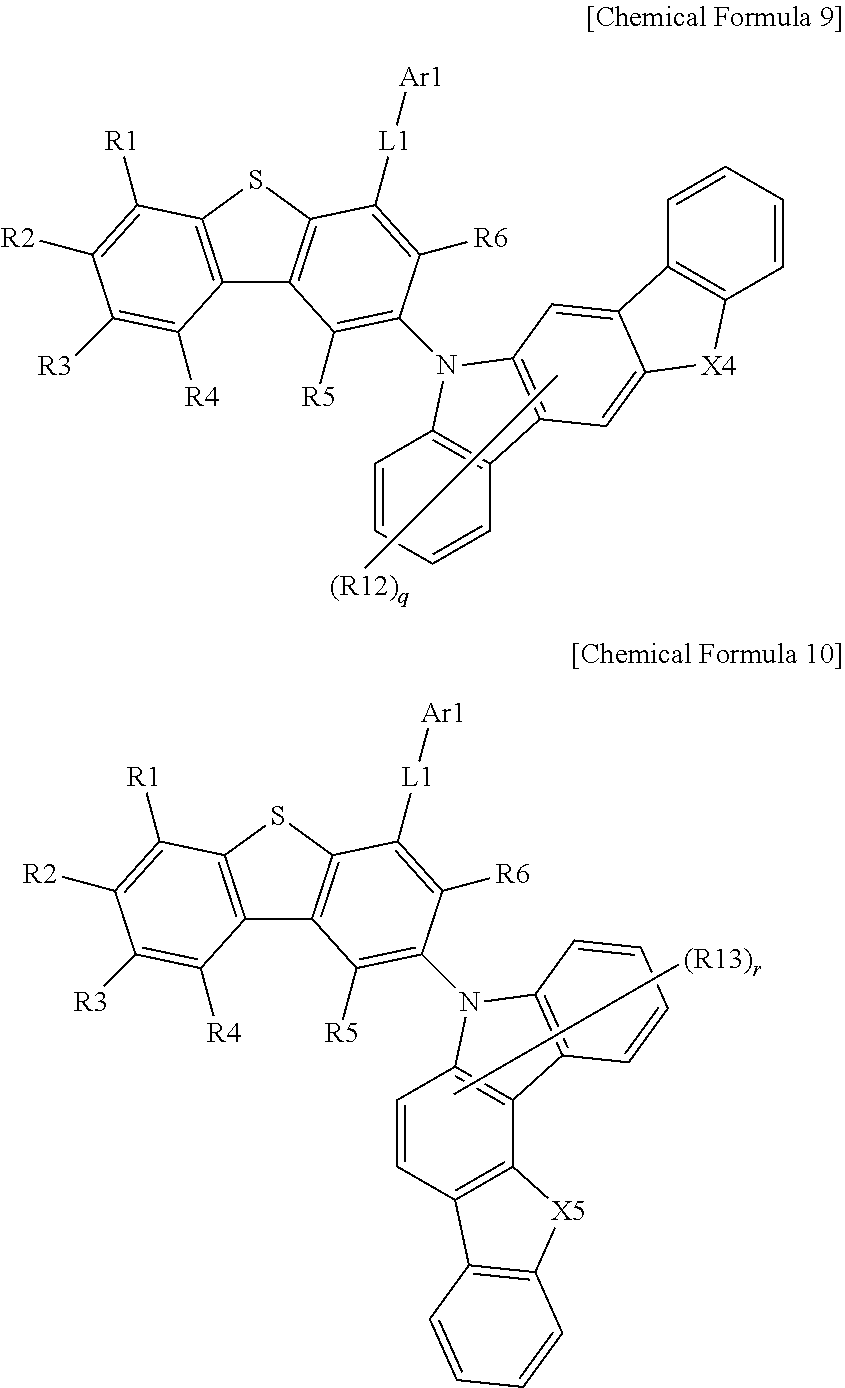








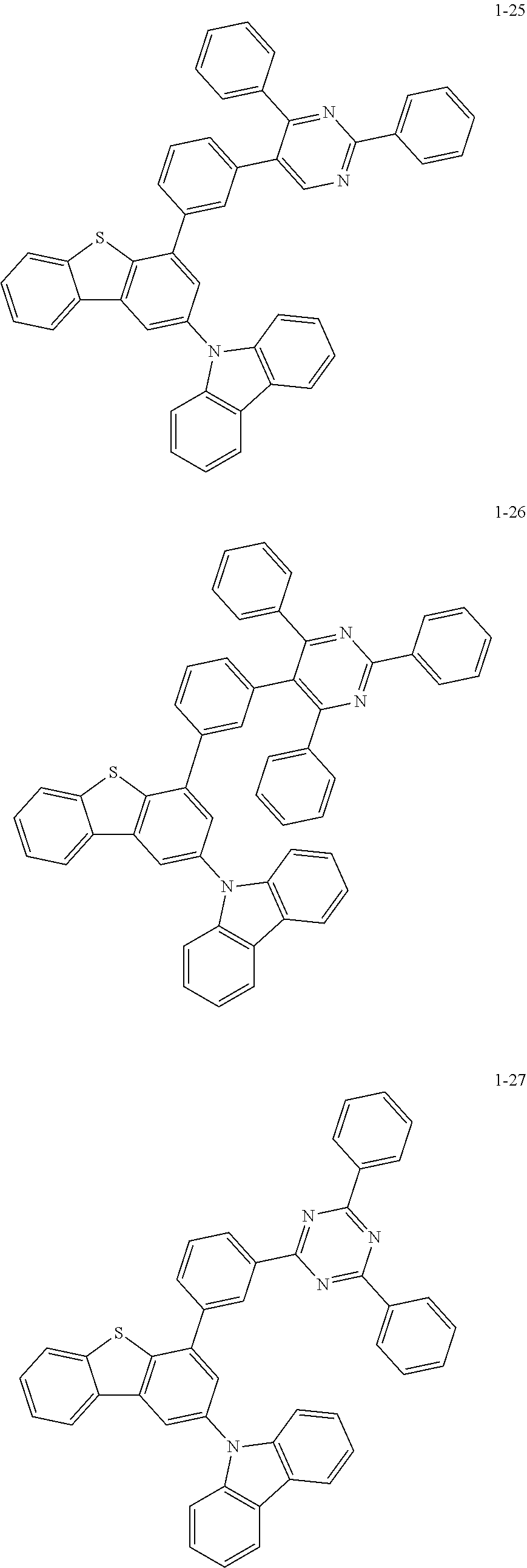







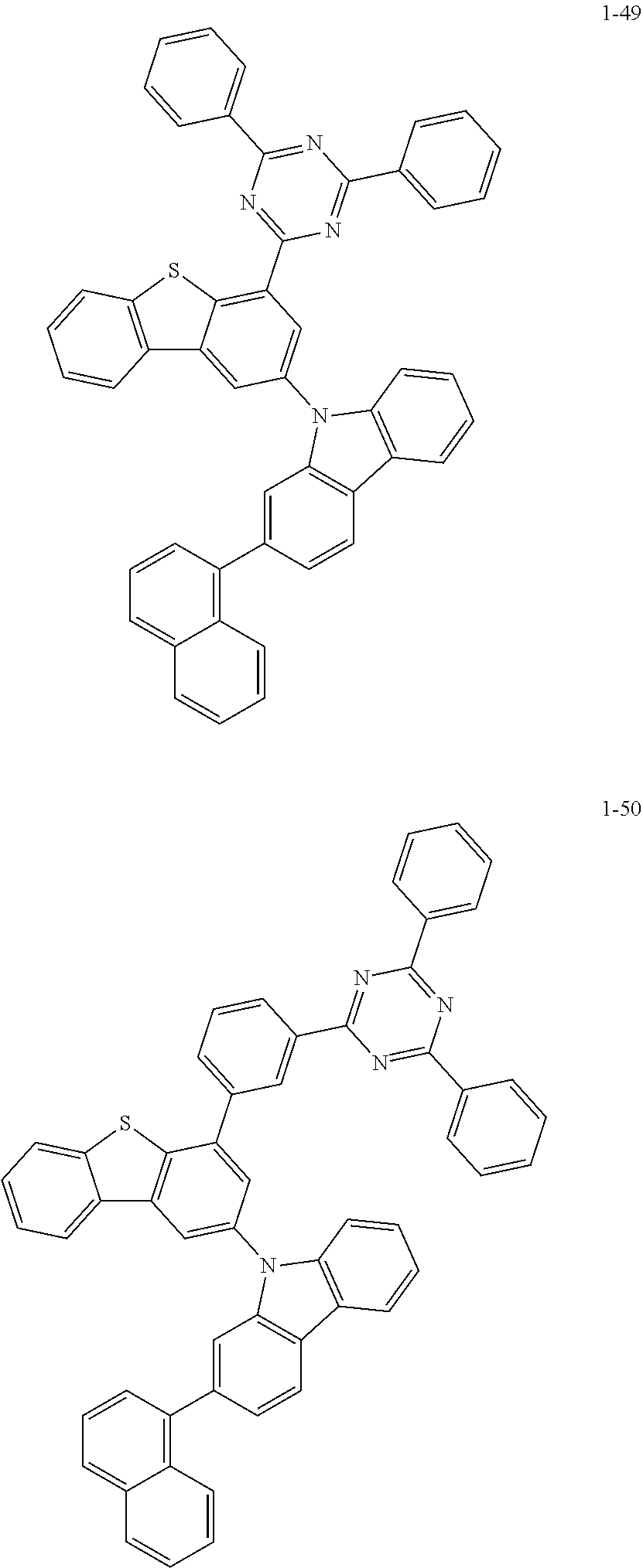



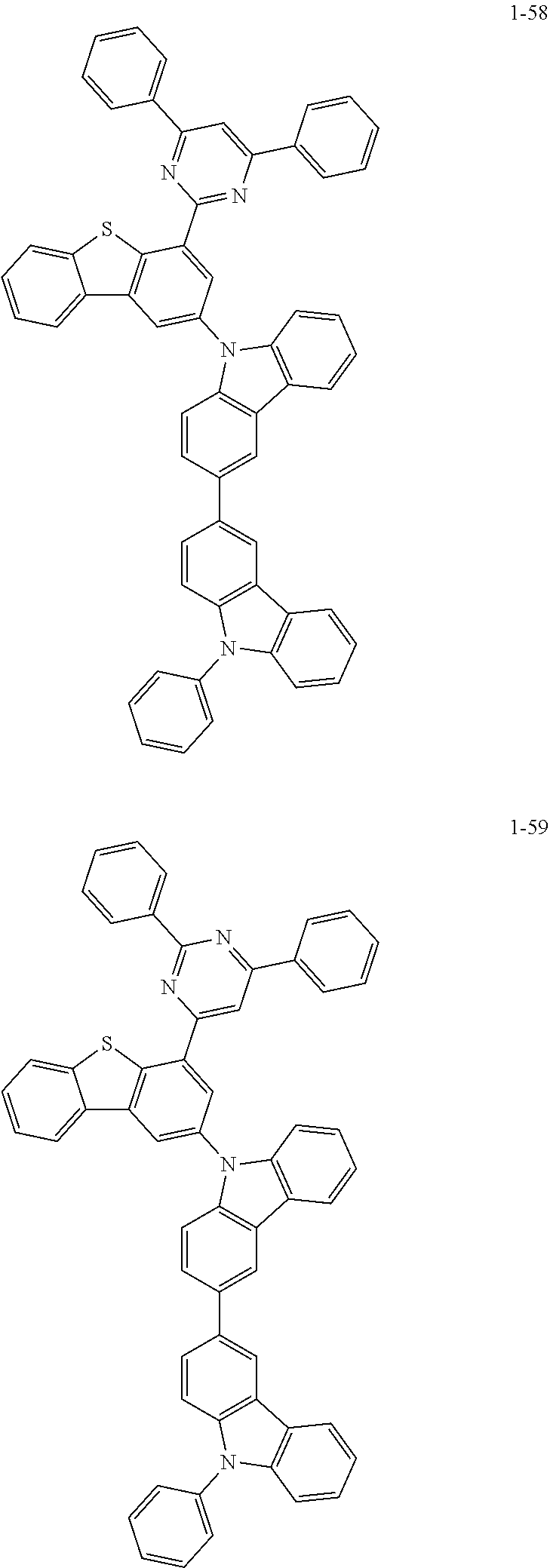
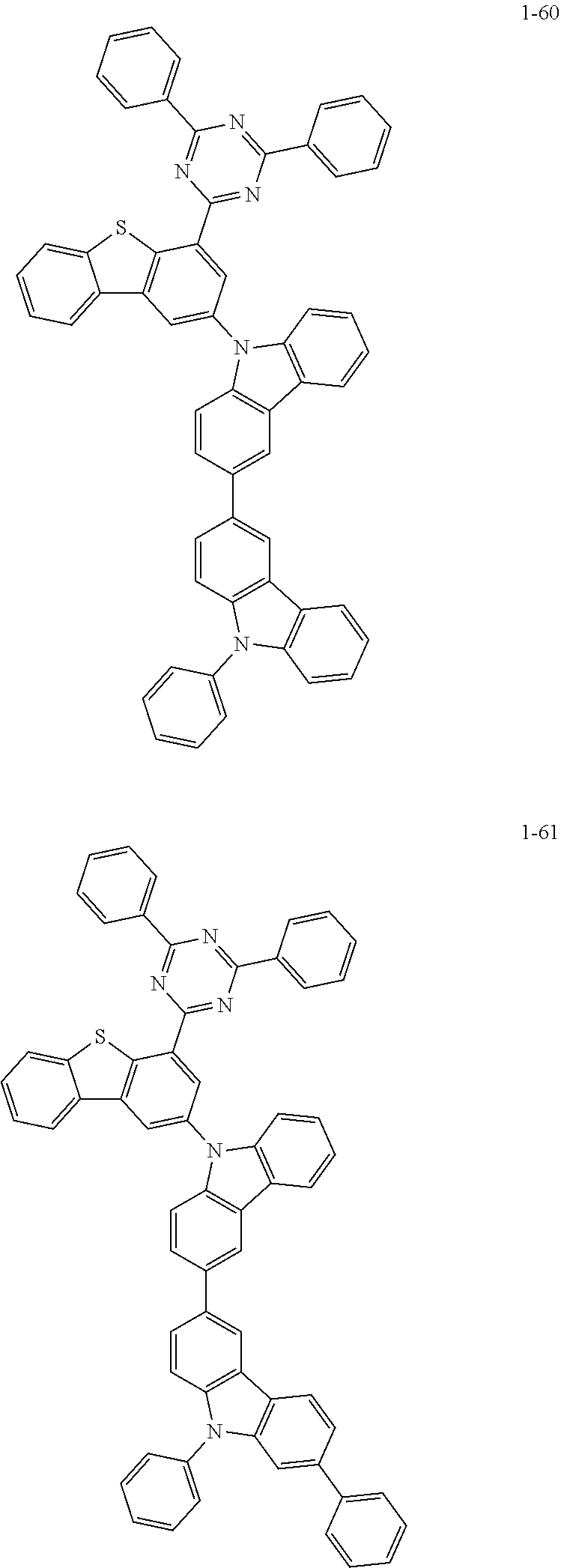



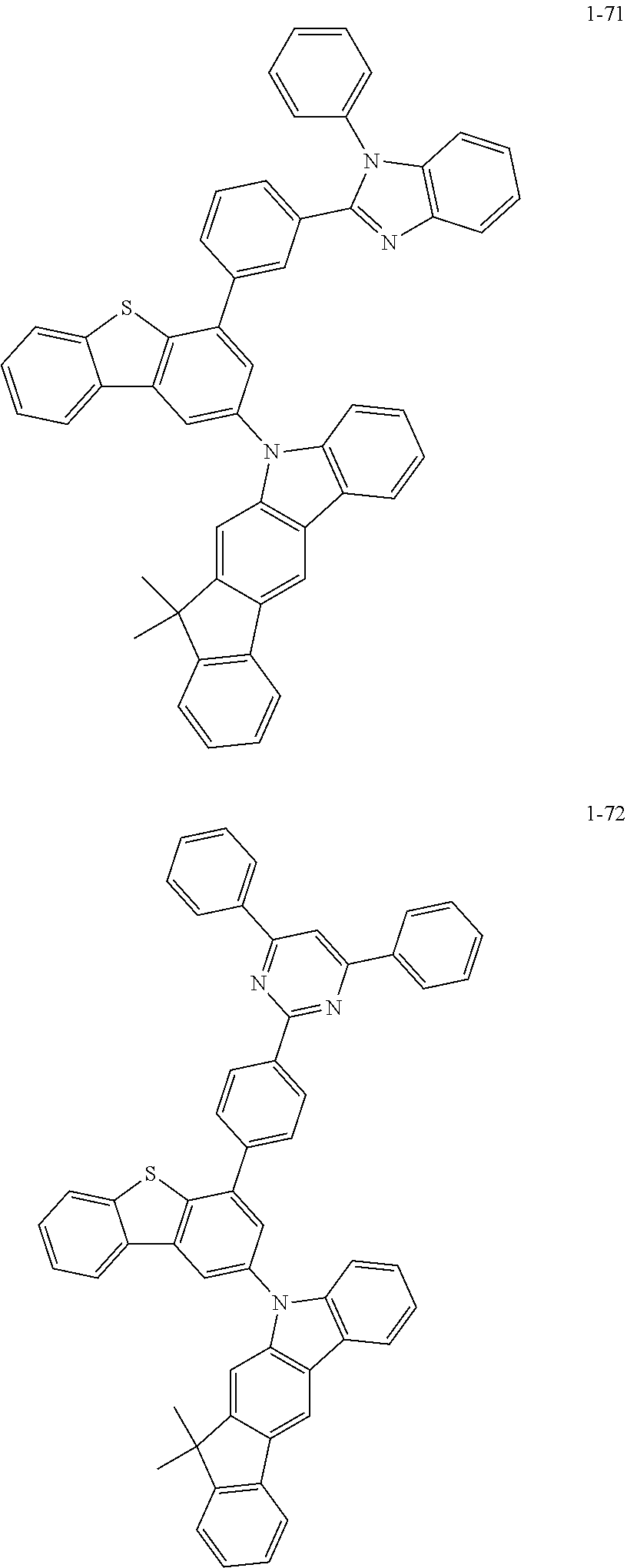


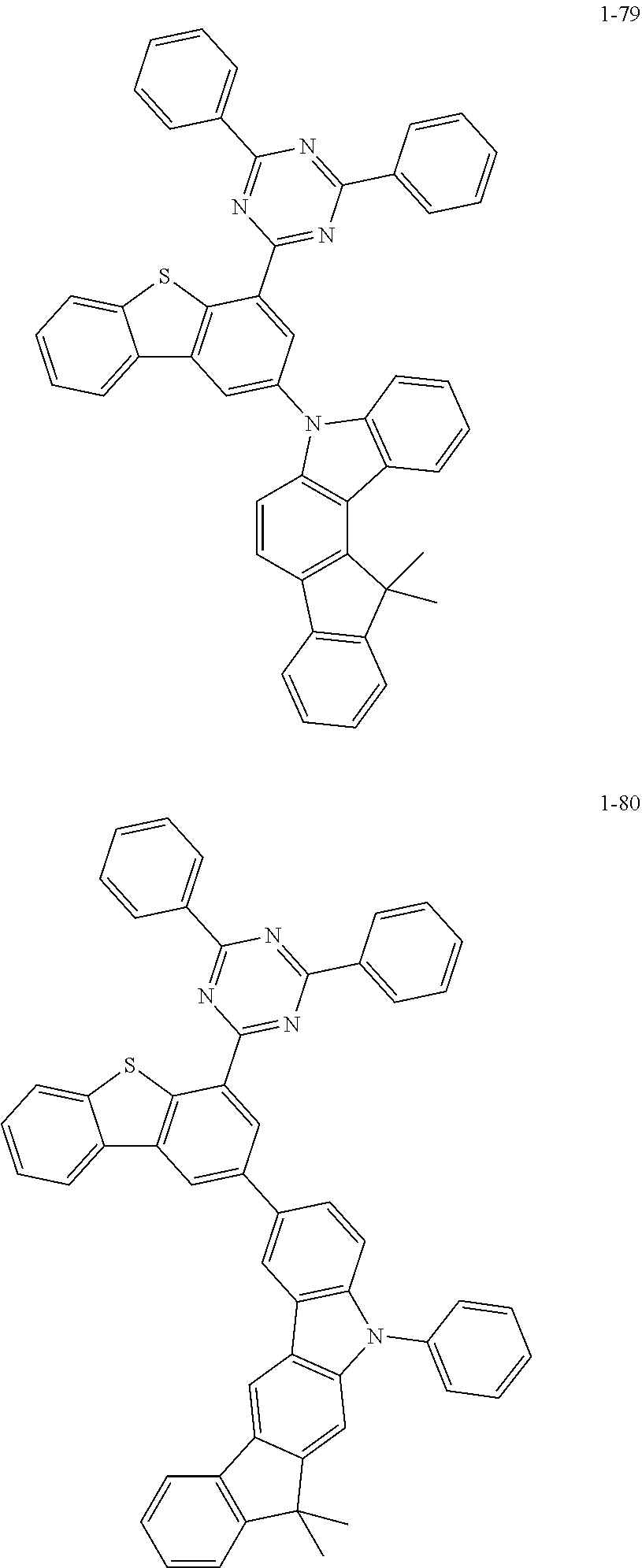









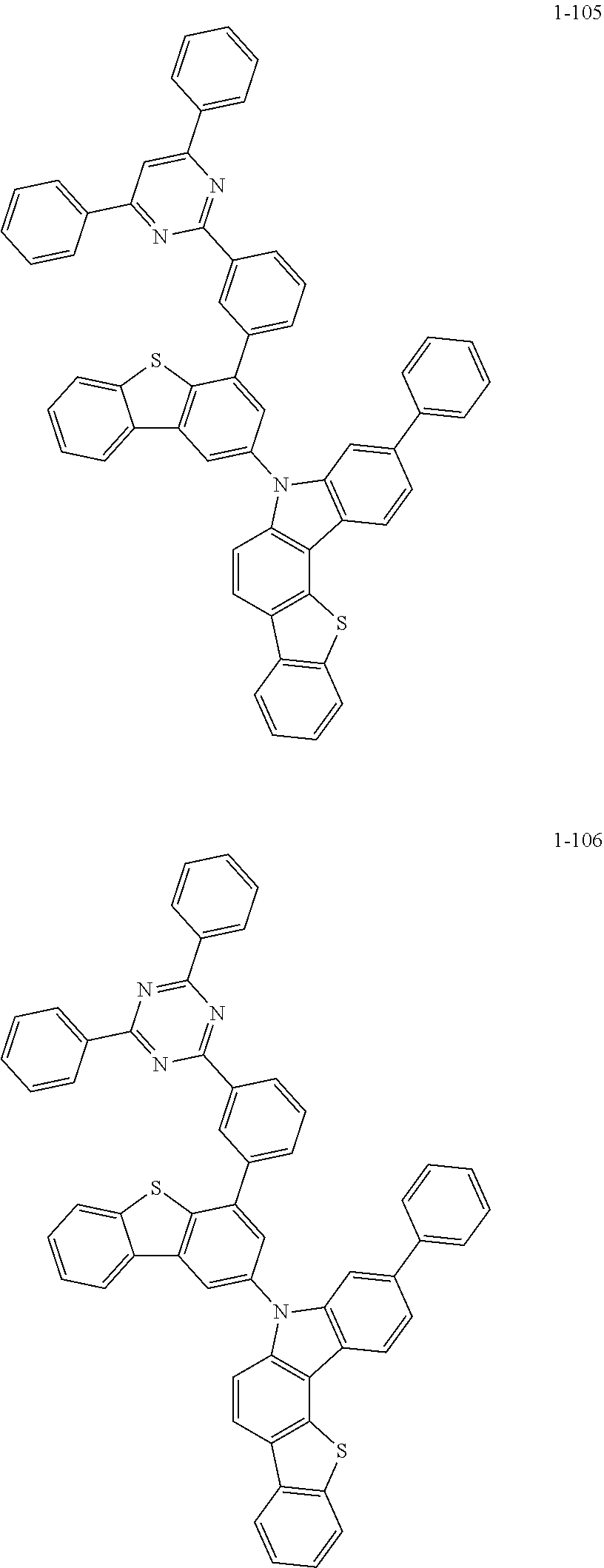




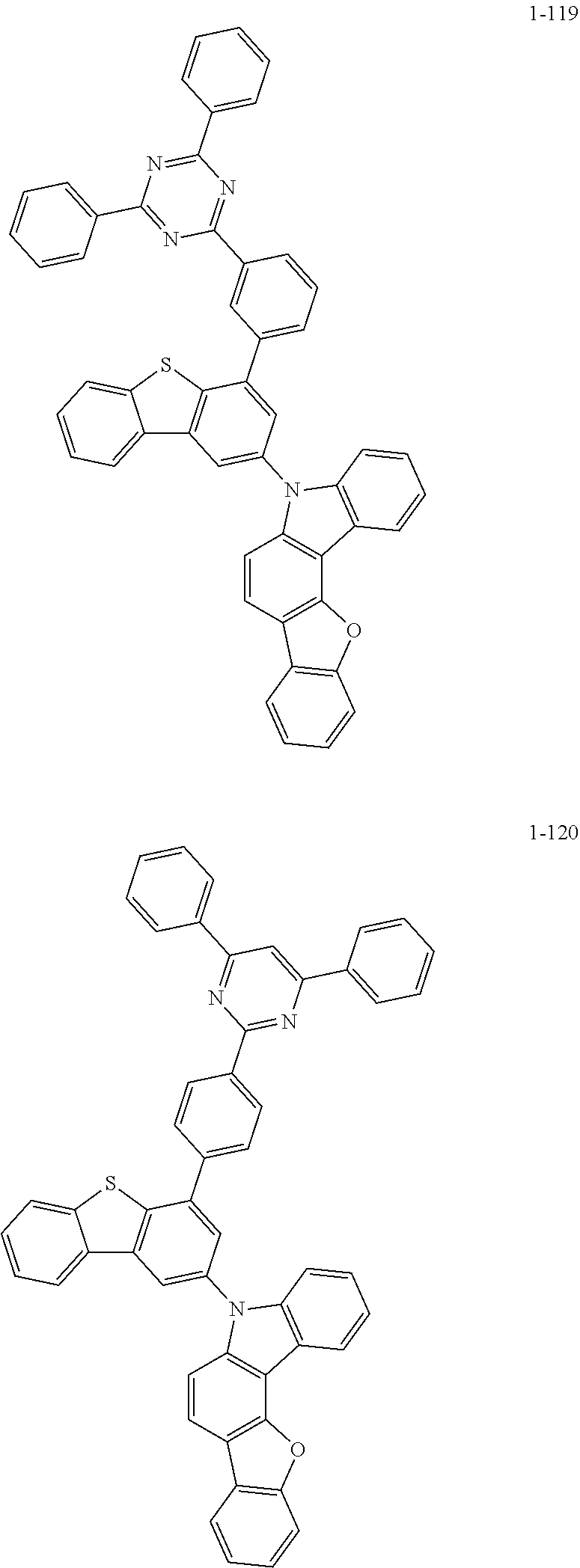










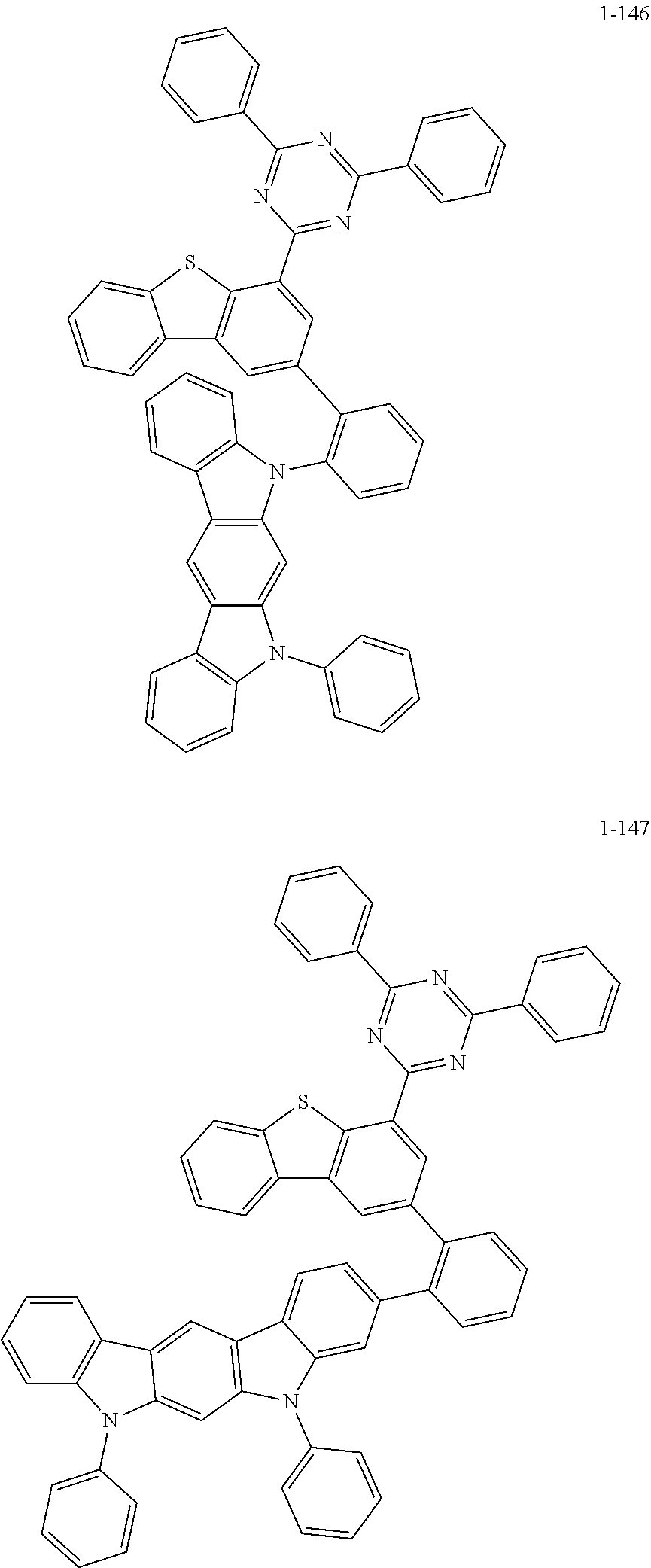










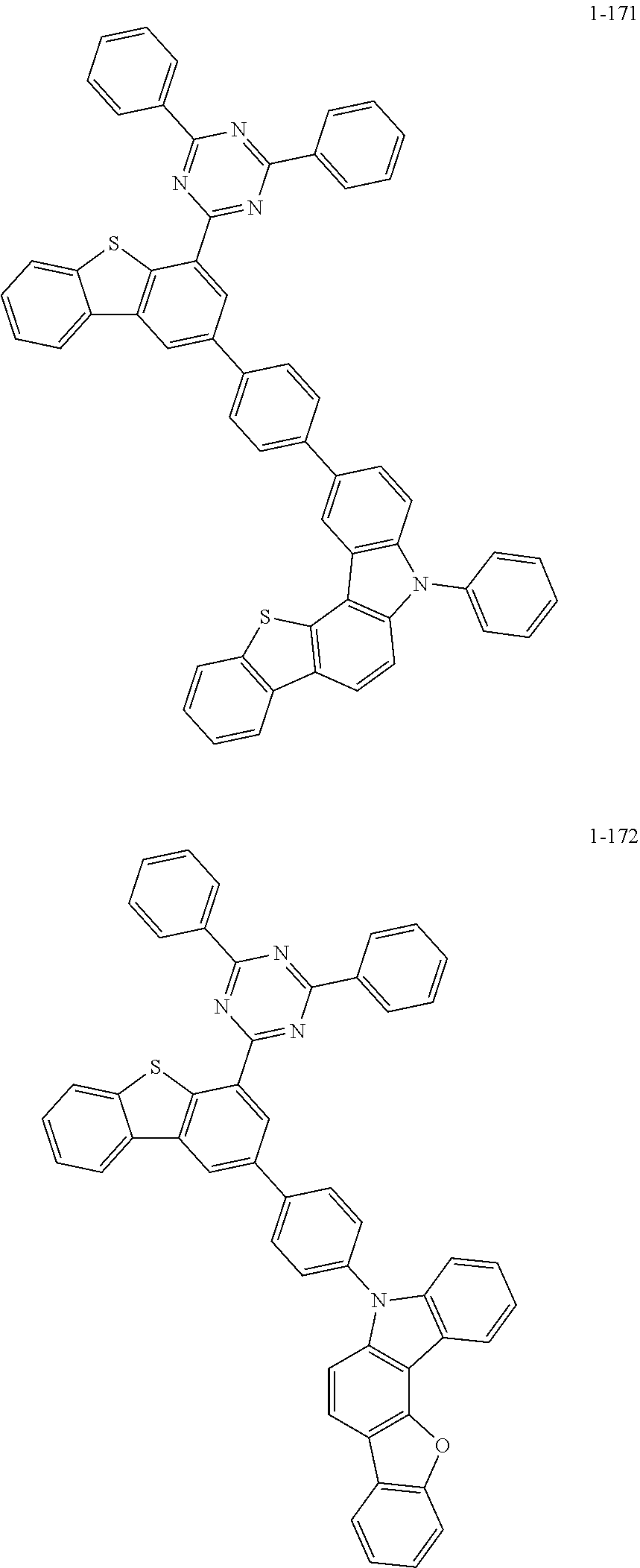

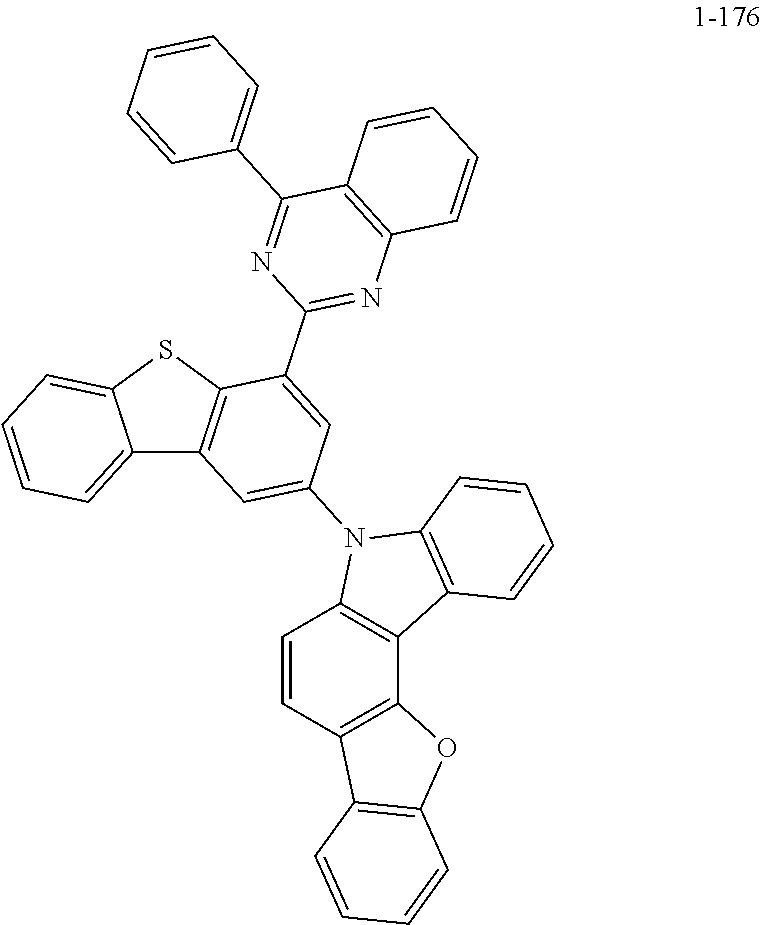









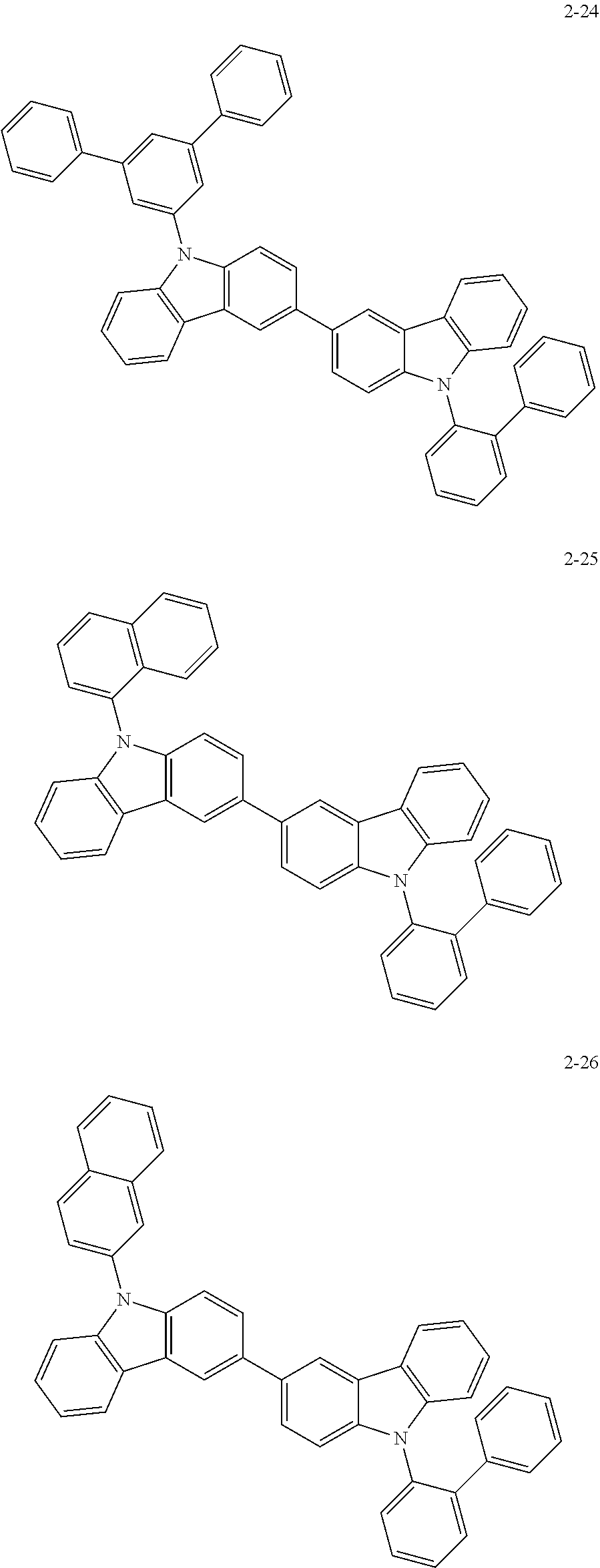









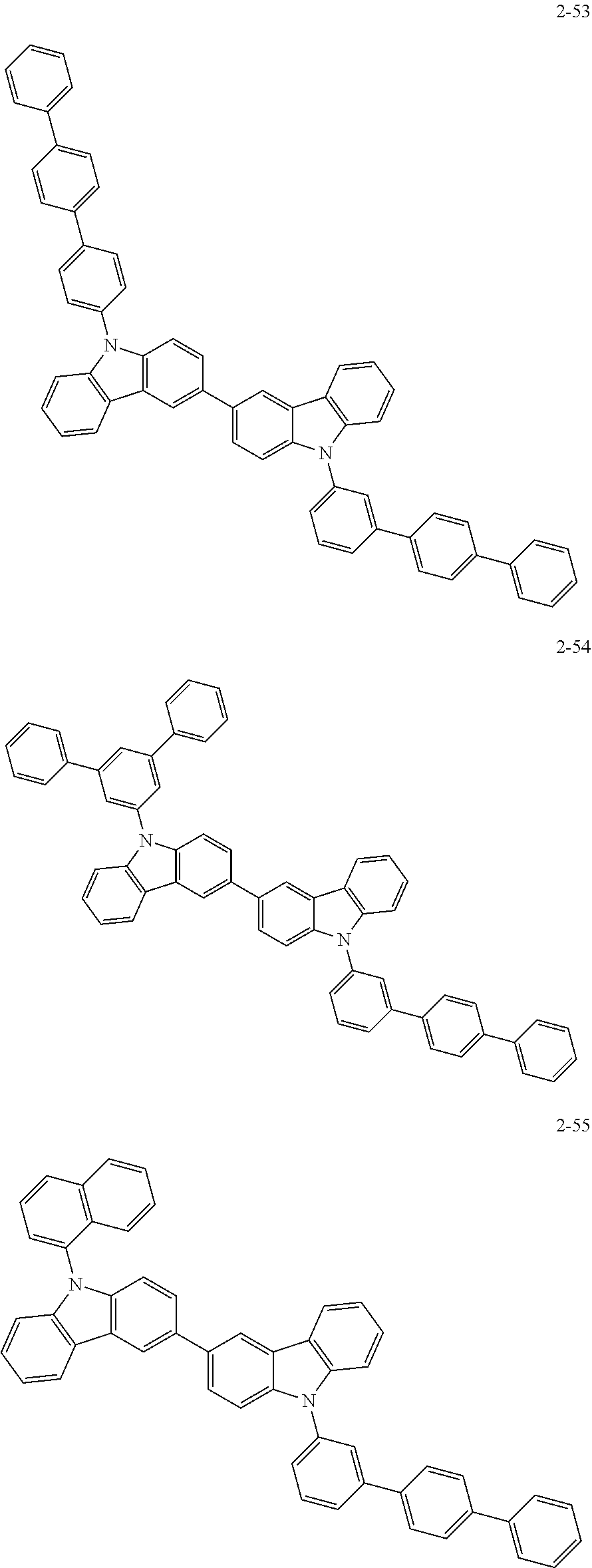
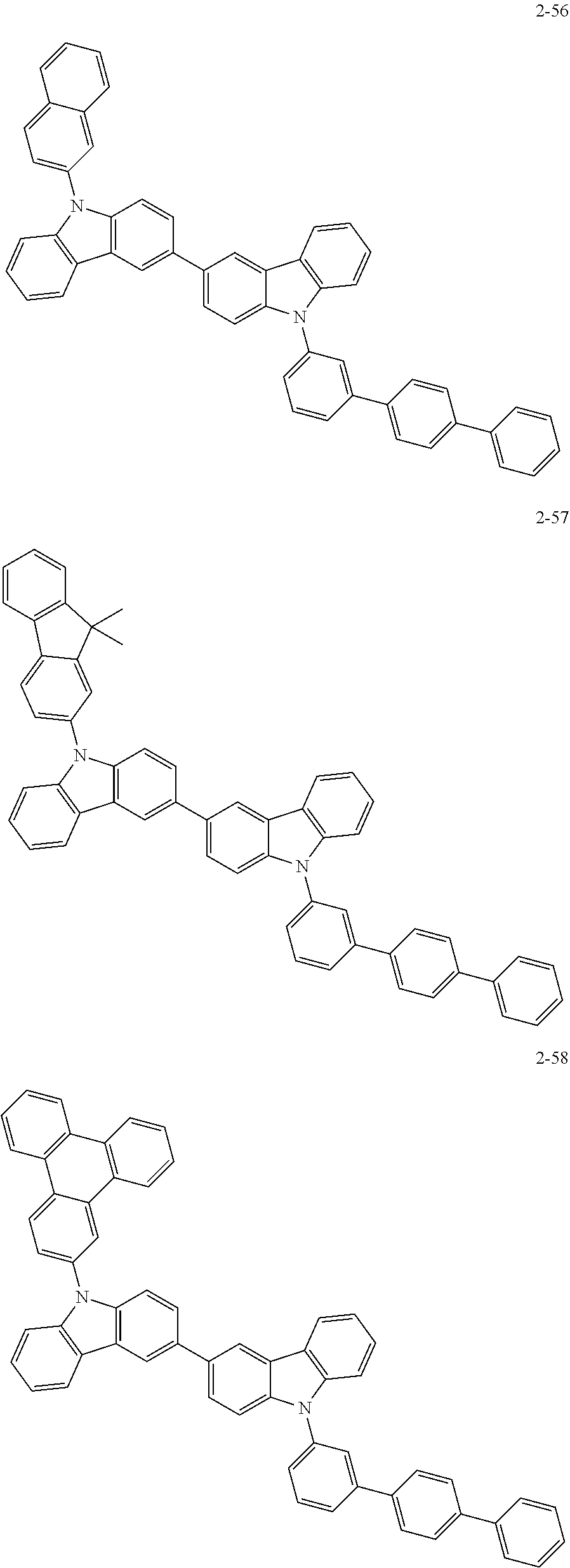






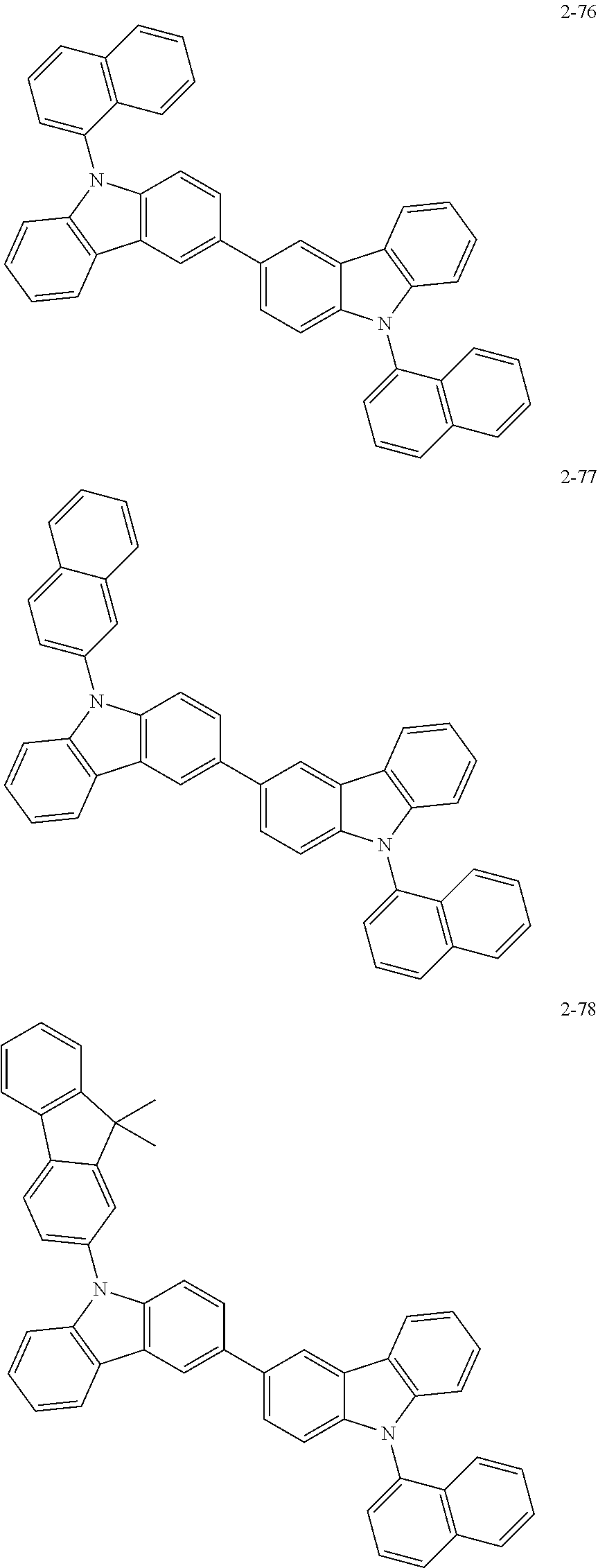





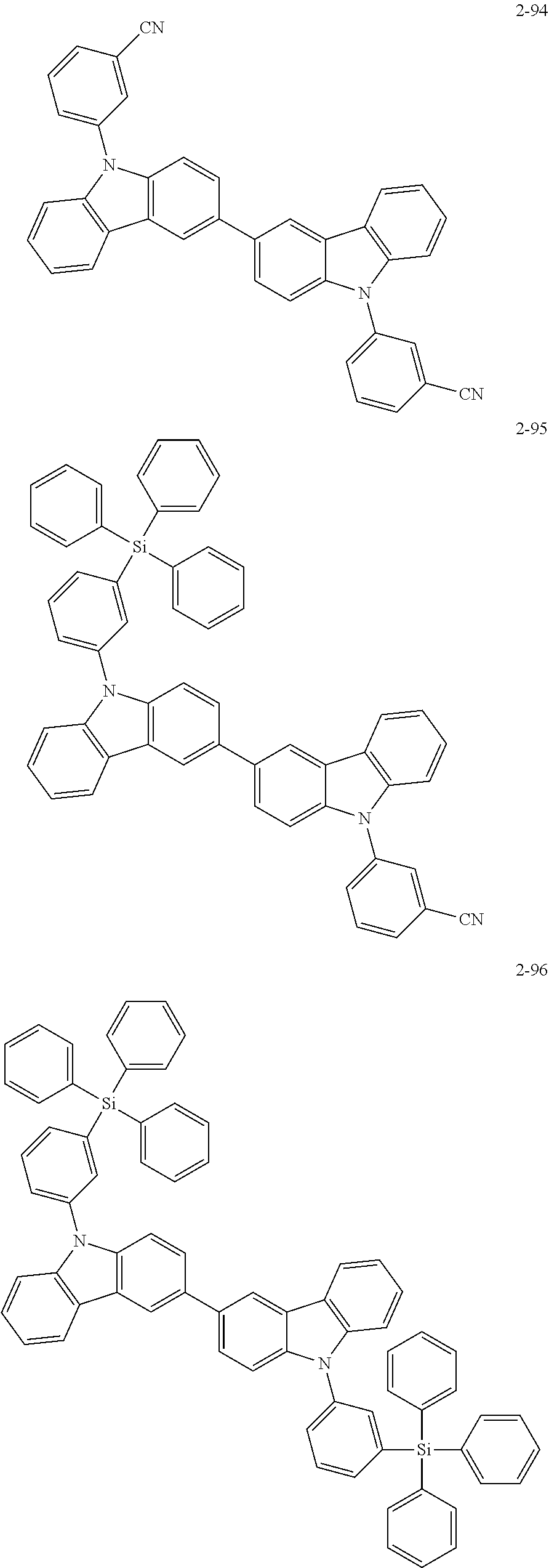


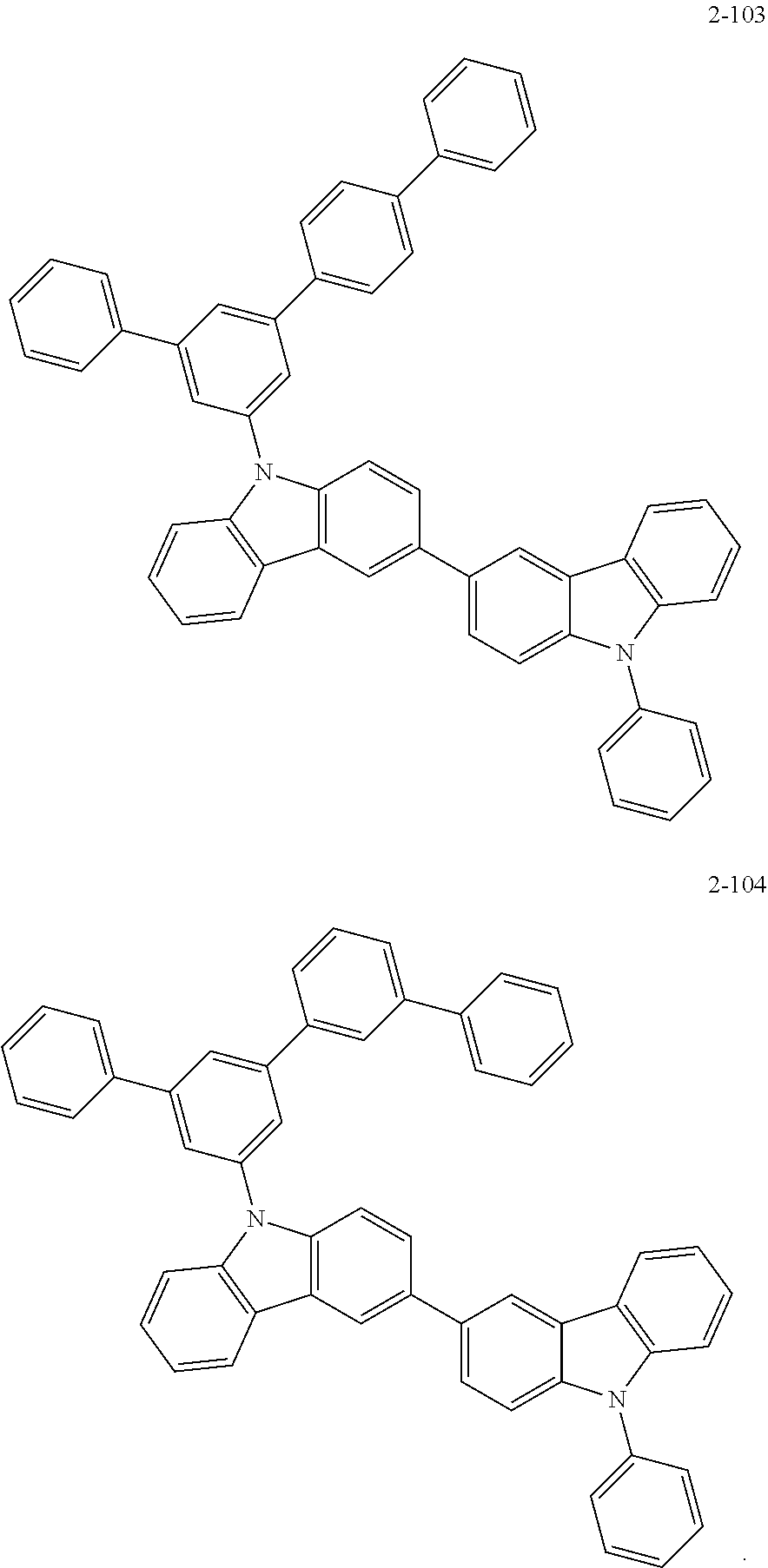
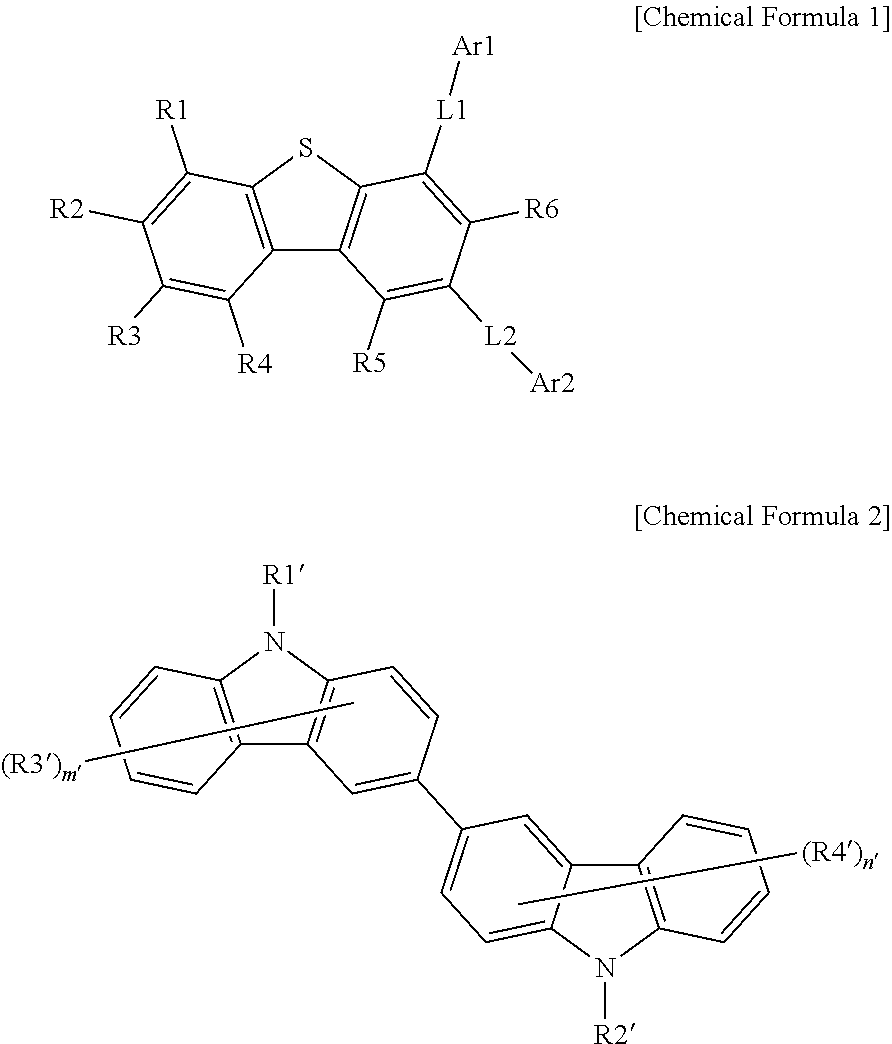
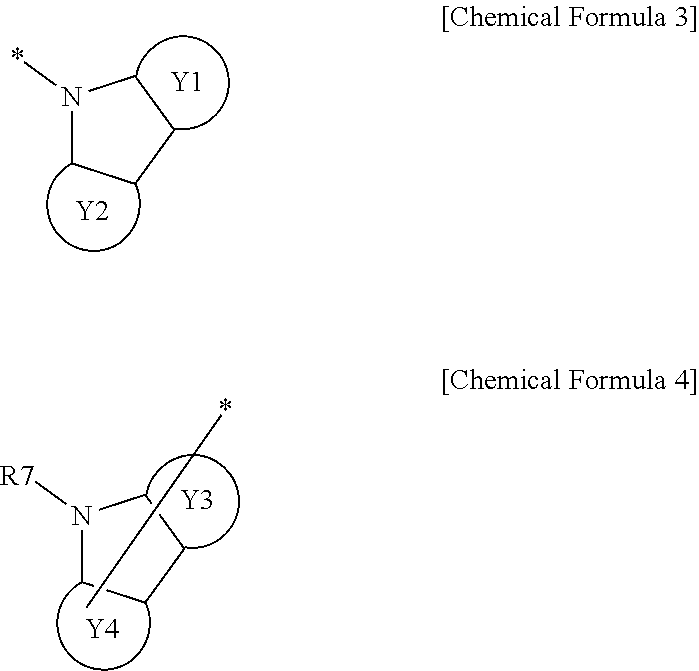


D00000

D00001

D00002
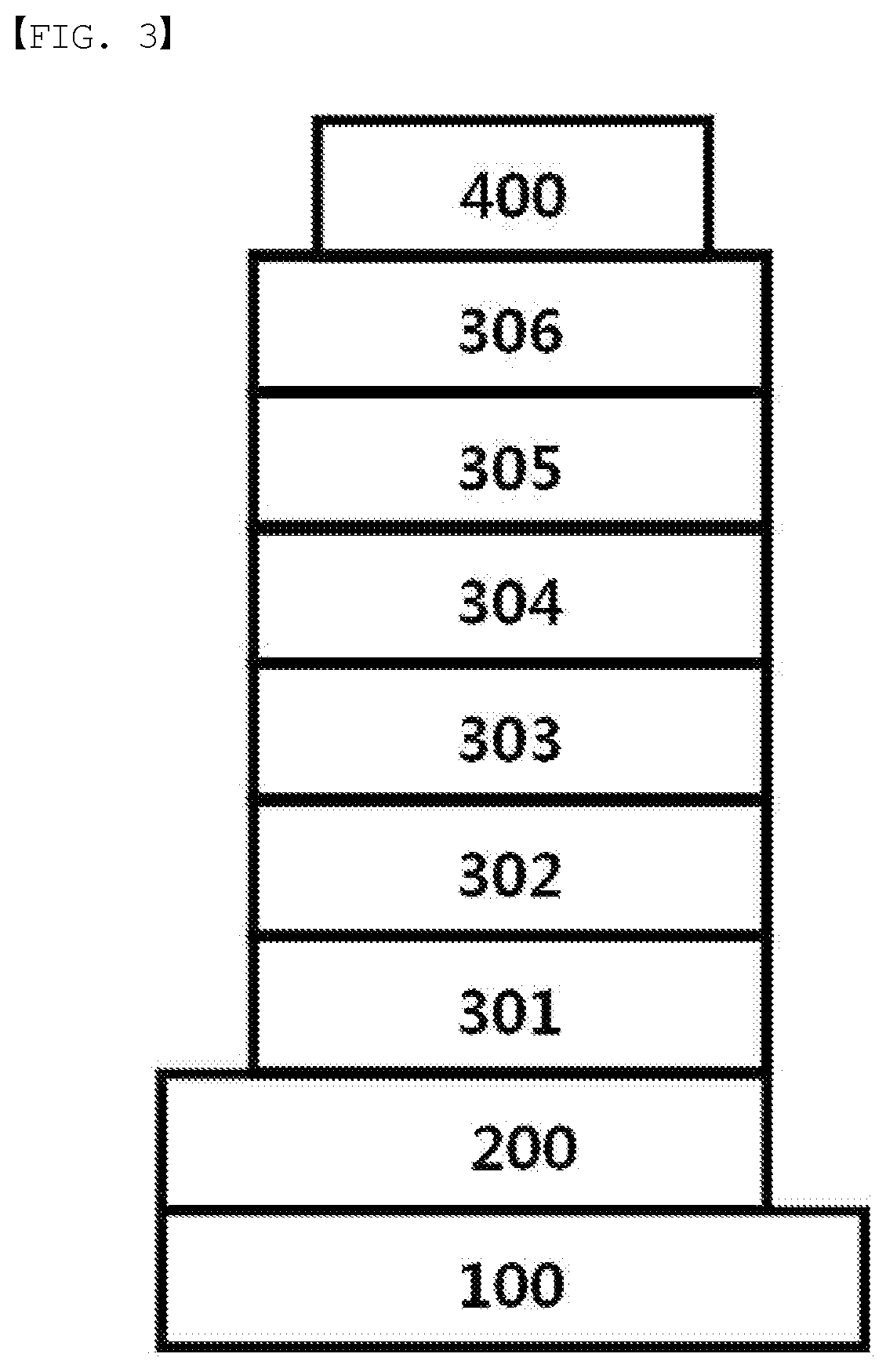
XML
uspto.report is an independent third-party trademark research tool that is not affiliated, endorsed, or sponsored by the United States Patent and Trademark Office (USPTO) or any other governmental organization. The information provided by uspto.report is based on publicly available data at the time of writing and is intended for informational purposes only.
While we strive to provide accurate and up-to-date information, we do not guarantee the accuracy, completeness, reliability, or suitability of the information displayed on this site. The use of this site is at your own risk. Any reliance you place on such information is therefore strictly at your own risk.
All official trademark data, including owner information, should be verified by visiting the official USPTO website at www.uspto.gov. This site is not intended to replace professional legal advice and should not be used as a substitute for consulting with a legal professional who is knowledgeable about trademark law.